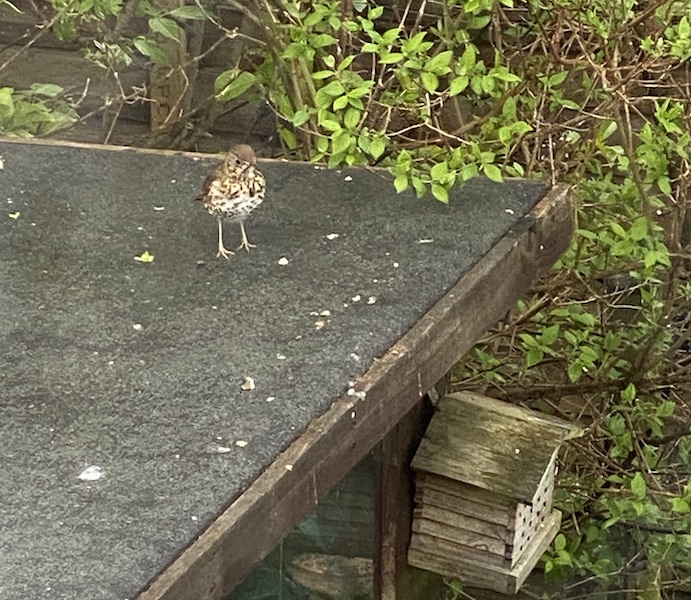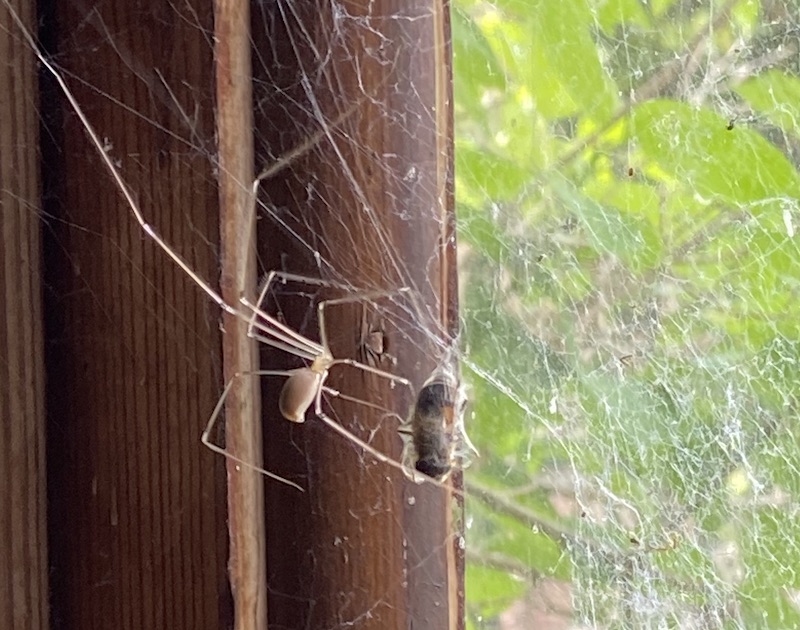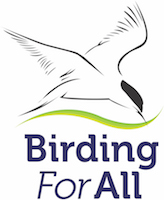All photographs throughout the BLOG (unless otherwise acknowledged) are taken with an iPhone 11 pro by me, a rubbish photographer.
Are they taking the proverbial?
(03-06-20)
I’ve spent much of the week trying to figure out what sort of bees the following are:
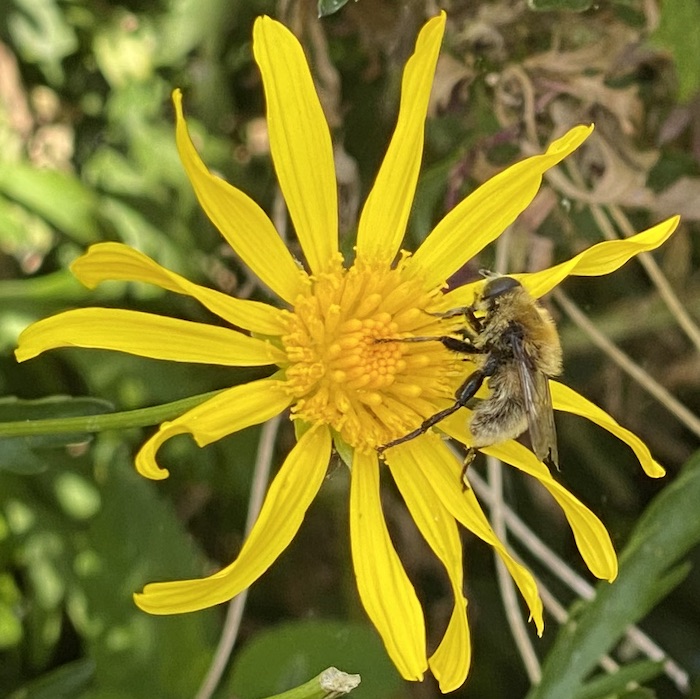
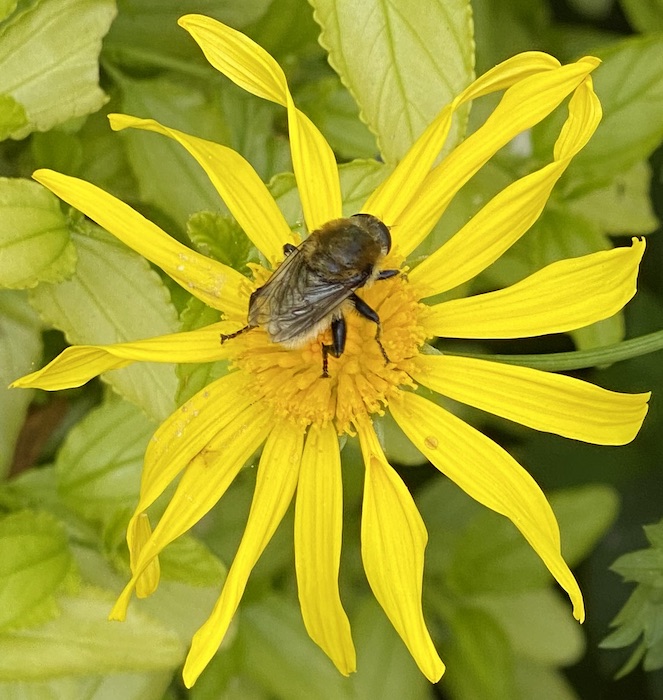
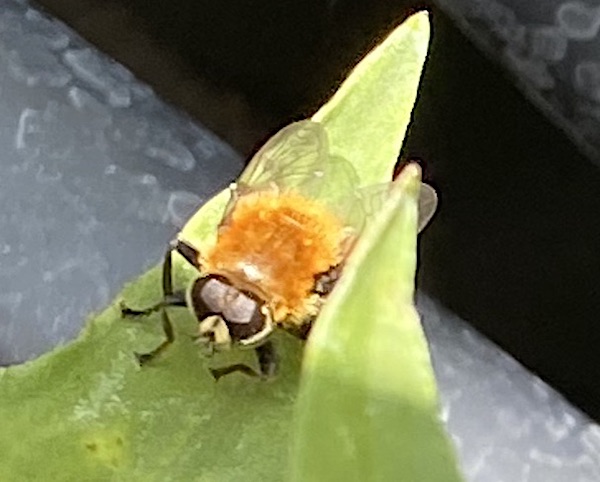
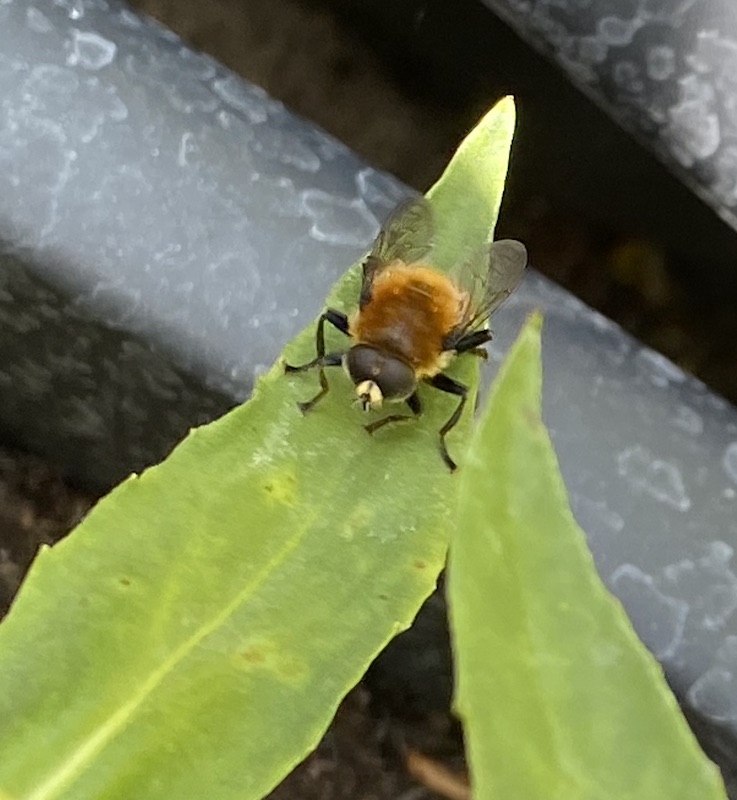
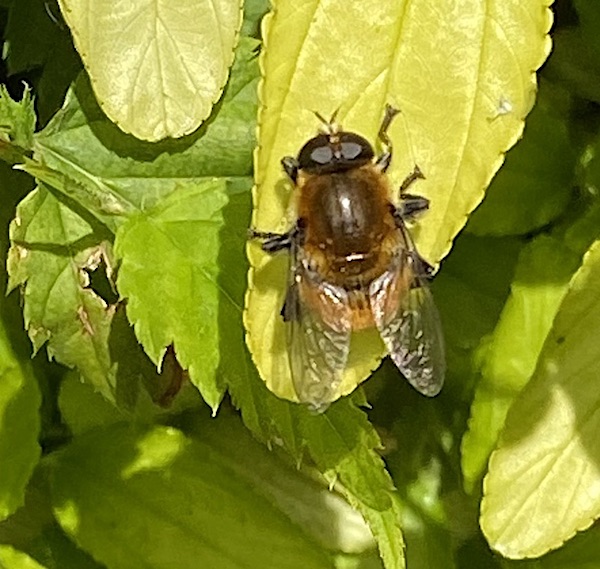
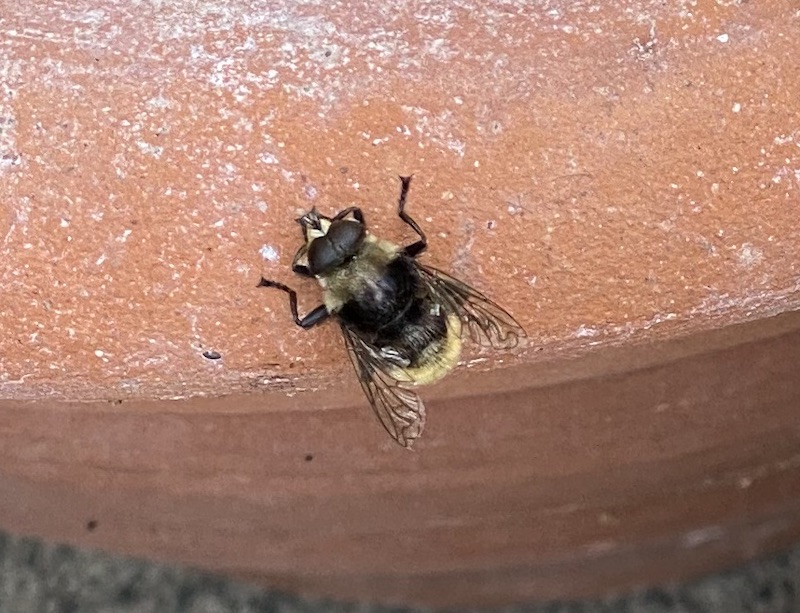
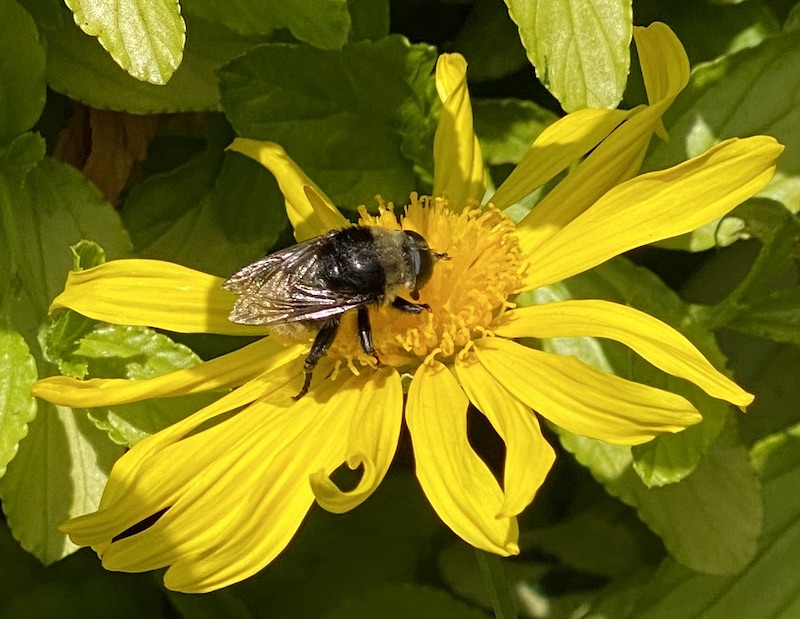
Narcissus Bulb Fly Merodon equestris
Turns out none of them are bees… but bee mimics; they are hoverflies.
Correction they are not hoverflies, except in the sense that there are a number individuals here.
WTF right?
It gets worse.
They are all one species the Narcissus Bulb Fly Merodon equestris. There is a way of telling this. For a start they have one pair of wings and, instead of the long waving antennas of bees they have small, paddle-like palps. That’s what makes you realise they are flies not bees. There are other syrphid bee mimics, but Merodon species are distinguished from these by the very strong hind femora, which bear a large triangular projection on the underside near the tip. Moreover, this one flies in low vegetation (sometimes even landing on the ground or in one case my flower pots) while the other bumblebee mimics prefer higher plant layers.
So there we have it, not bees but hoverflies and a number of lessons learned because of Lockdown.
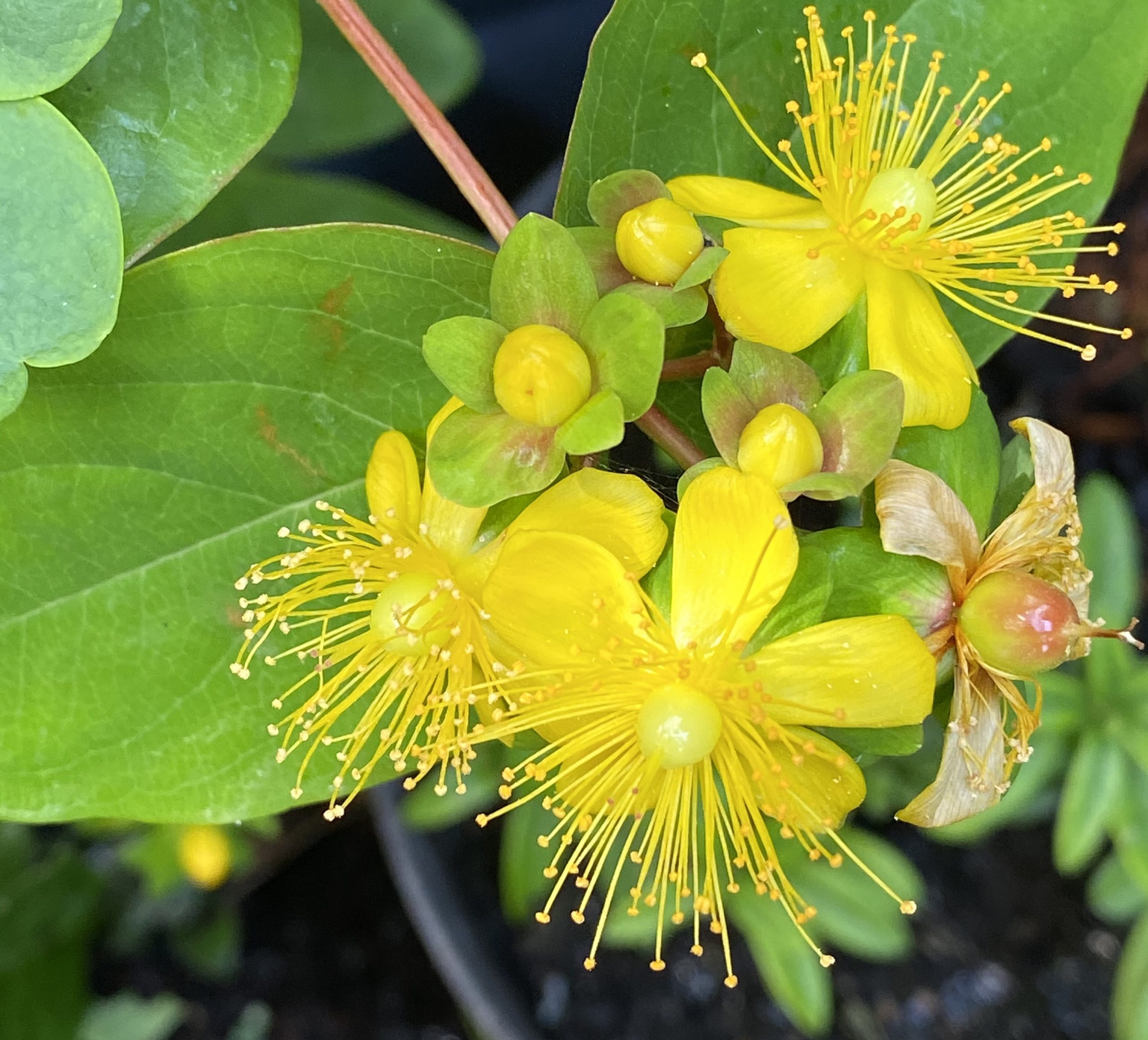
St John’s Wort – Hypericum perforatum
As a change from critters the above is a cultivated form of the wildflower St John’s Wort. I’ve never planted one but have half a dozen in pots that found there way here under their own steam… maybe the black berries they exhibit in the Autumn.
Passage
(02-06-20)
Big news for us was a new tick from home… Maggie spotted a raptor from the office window today – a Red Kite which was a first for the year too. It circled slowly by accompanied by a buzzard species. I was doing a ‘virtual’ talk today to some local RSPB staff and was told there had been at least 100 Red Kites passing over the Sandwich Bay Bird Observatory today… timing and weather must have been perfect. An amazing 139 were seen slowly moving north, a record movement for Kent!
A few days ago I was uncertain about ID of a bumblebee… now I am sure this is a White-tailed Bumblebee Bombus lucorum.
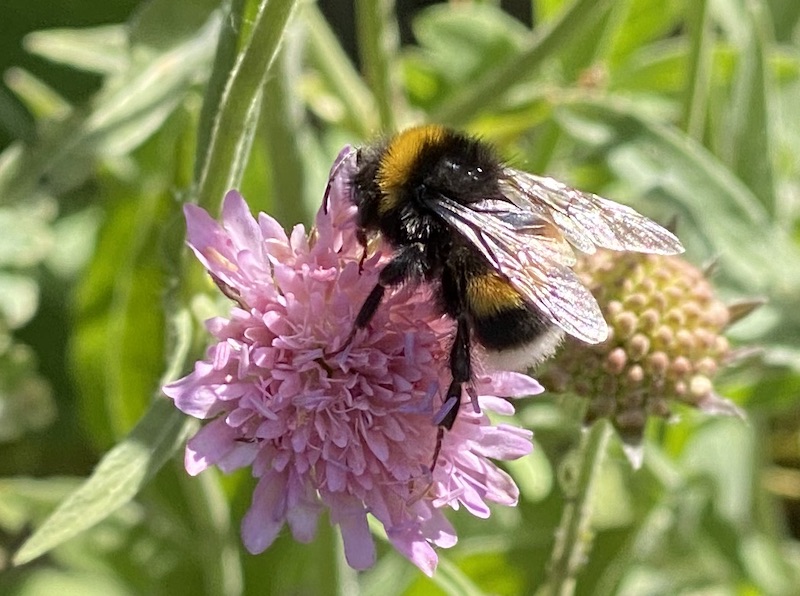
Frog Frolics
(02-06-20)
Cute is not a word I ever use! But take a look at these two what must be one of last year’s tadpoles with a two-year-old playing follow my leader… cute sums it up.
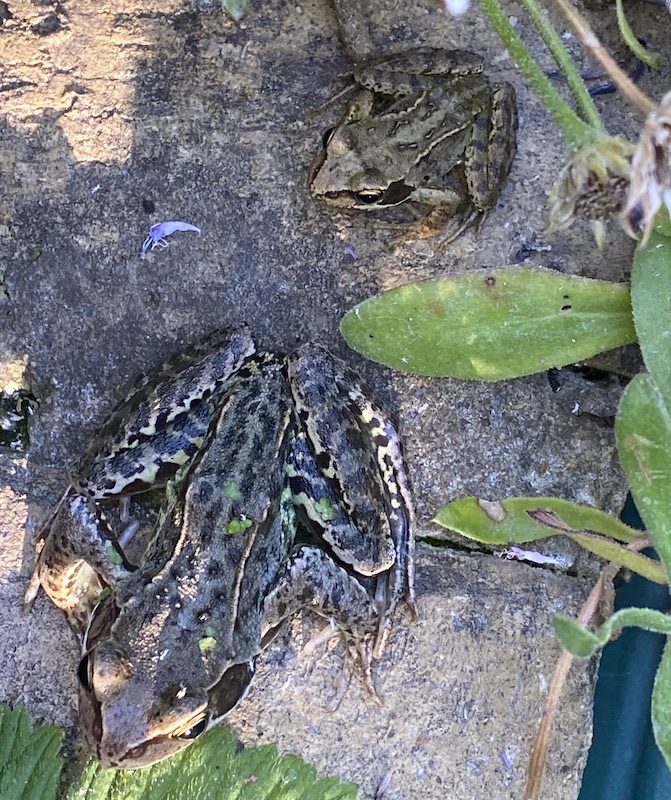
Here’s another frog under the food catching tray, mentioned the other day. The variation in colours from almost black, through dark green to khaki fascinates me.
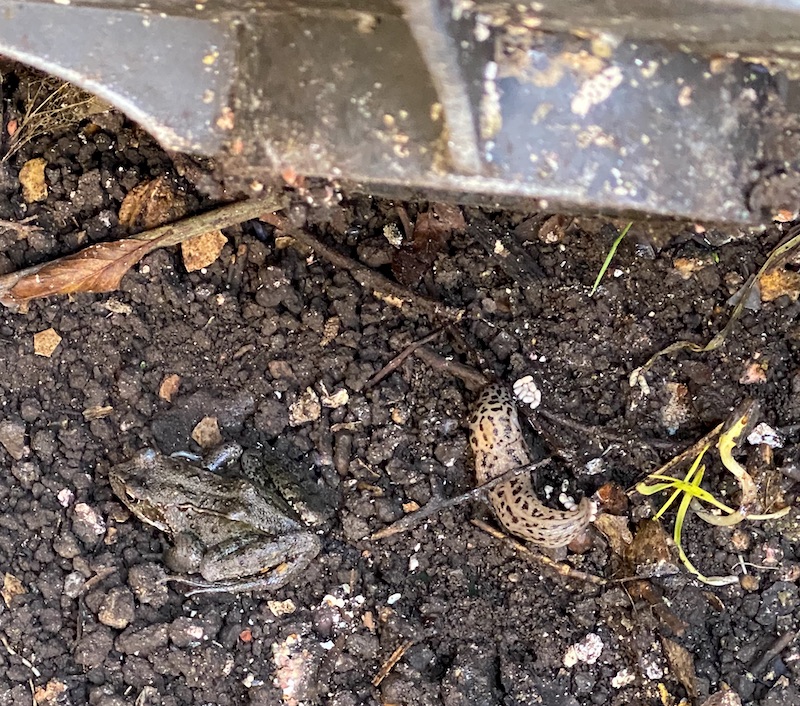
Frog with a Leopard Slug Limax maximus* probably having polished off its smaller relatives.
This morning Maggie found this frog on a leaf. Shortly afterwards a fly landed on the leaf and the frog leapt at it mouth open and missed, landing in the pond!
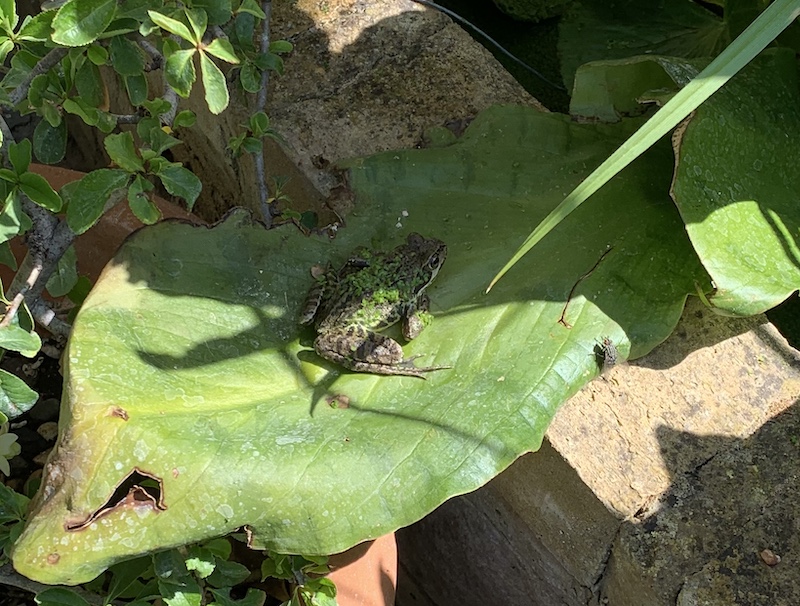
And finally, in the frolicking frog parade this chap who I snapped with his old china.
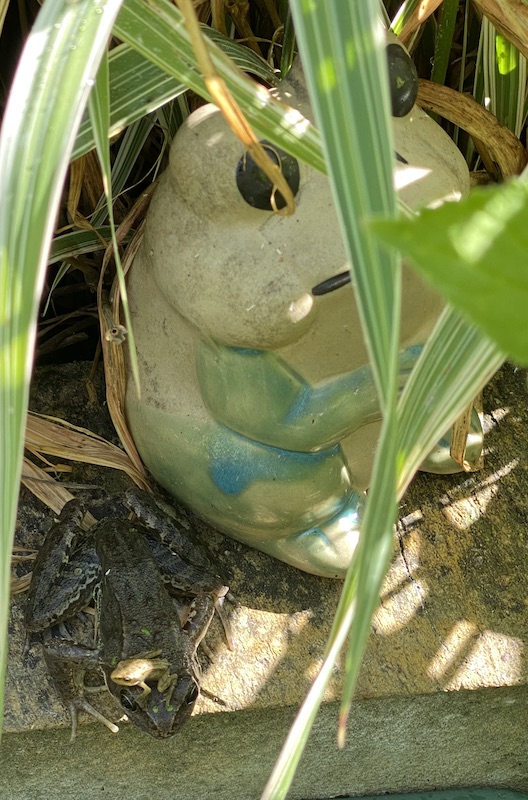
Sorry me old china, there’s no way we can get it on.
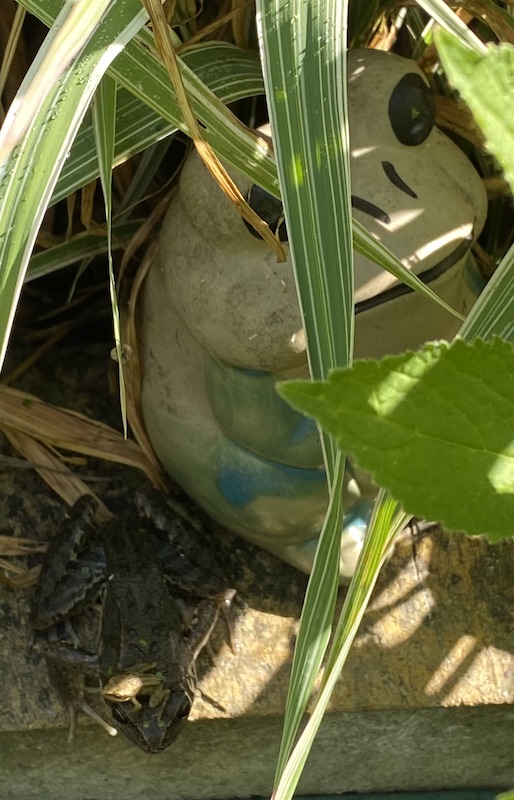
*Leopard or Great Grey slug, Limax maximus, as its scientific name implies is the largest in the UK and can grow as much as 8 inches in length! It has a very unusual and distinctive mating method, during which the hermaphrodite pair use a thick thread of mucus to hang suspended in the air from a tree branch etc. Native to Europe and Africa they are now found all over the world.
Golden locks and the three bears
(01-06-20)
So, this month starts with a fairy tale… in more ways that one.
It seems like the whole scientific community are trying to put the brakes on the government who are determine to leads us over the cliff into a second wave of virus. With the same infection rate as when the lockdown was imposed, government says its OK to send kids back to school, open more shops, allow small gatherings and let the shielded out for exercise. People still leading government will vote with their feet. Those who think they are immortal with follow the government, the rest of us will make our own judgement calls and stay locked down, socially distanced and home teaching etc.
Meanwhile a fairy tale has unfolded in my bijoux haven.
I’ve bitten the bullet and got out the books rather than continue to accrue photos of unidentified bugs. This was brought on by observing three different sized hoverflies on one osteospermum bush. It’s easy to see the relative sizes that way.
Daddy bear has no common name and is nearly the size of a honey bee. It’s one I have encountered many times in the garden and is common literally the length and breadth of Europe.
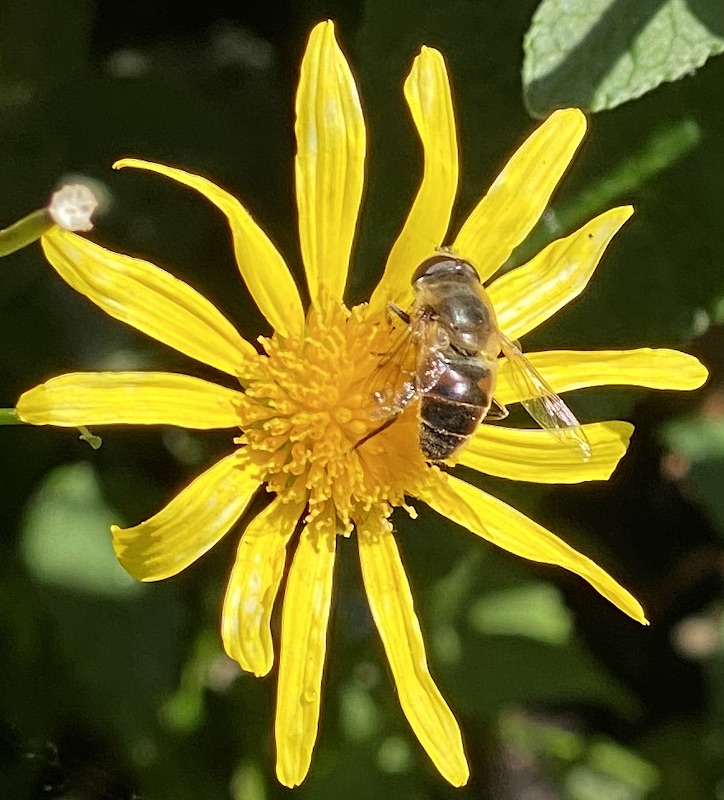
Daddy Bear: No common name – Eristalis pertinax
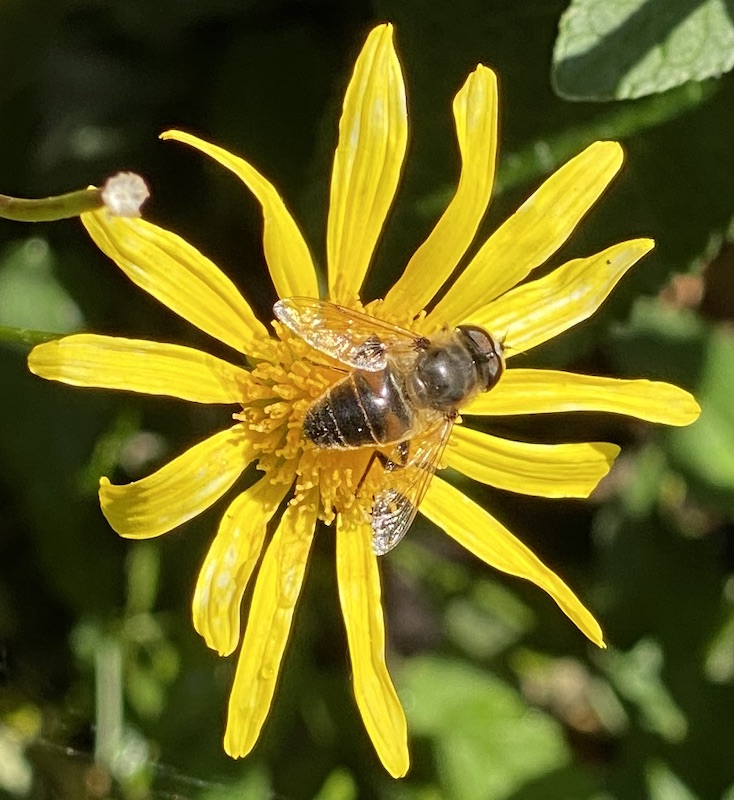
Considerably smaller, mummy bear is already a star of this blog. The Marmalade hoverfly is even more widespread, common across most of Europe, Northern Asia and northern North America. It is probably the hoverfly I see most of from early Spring through to late Autumn and in most numbers too.
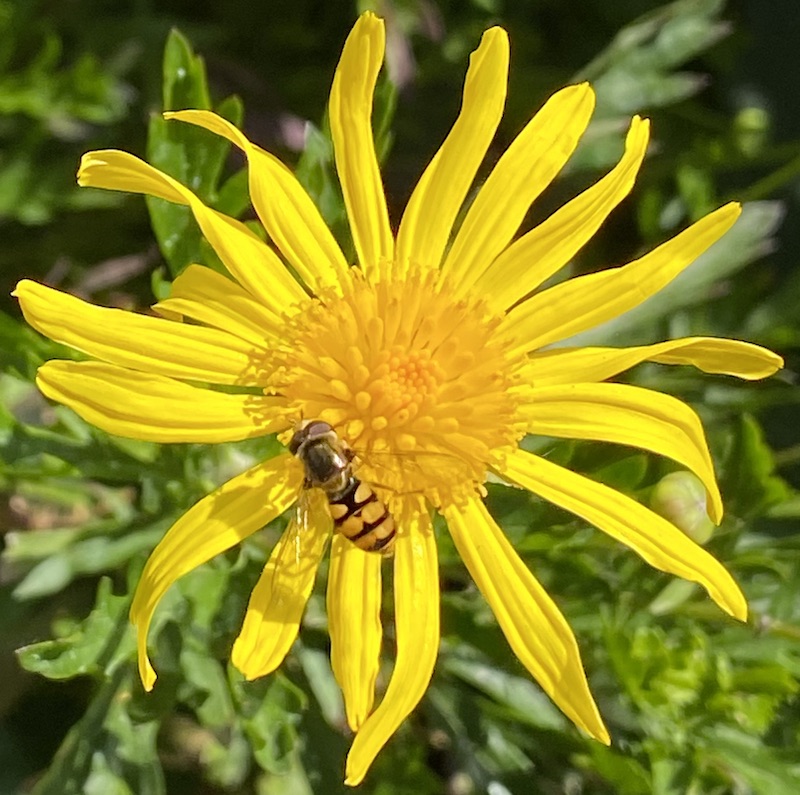
Mummy Bear: Marmalade Hoverfly – Episyrphus balteatus
Then we come to the diminutive baby bear, the Thick-legged hoverfly, a tiny species, easily overlooked and dismissed as an ordinary fly until you realise it hovers. Moreover, unless you get really up close and personal, or get a photo, its charms can be lost. The images show it too is a little jewel of the universe of small things. I find that it is hard to get wrong if you can see its eponymous feature, hind leg thighs thicker than a prop forward’s.
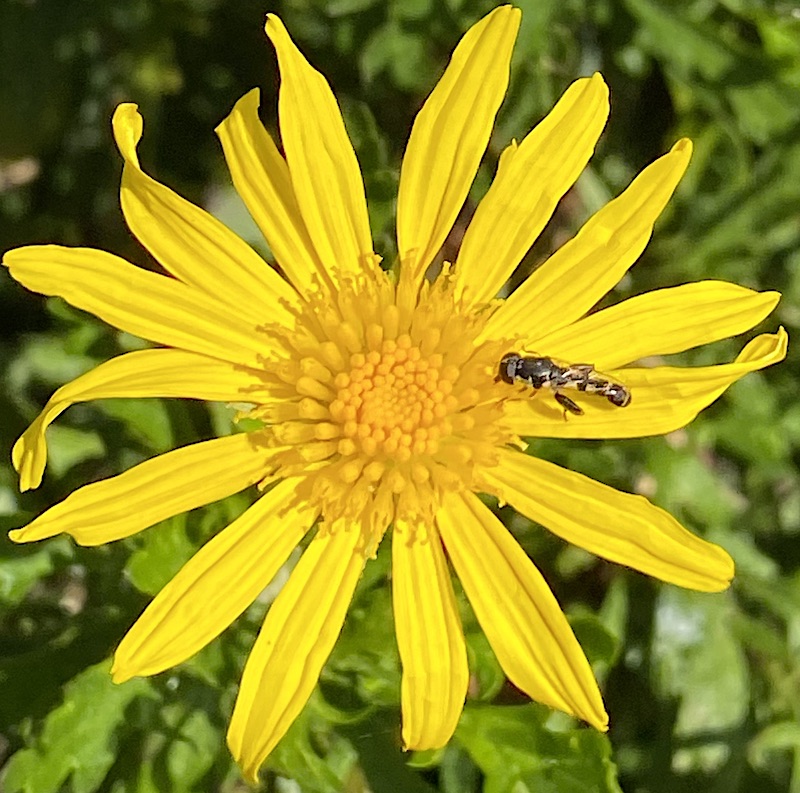
Baby Bear: Thick-legged Hoverfly – Syritta pipiens
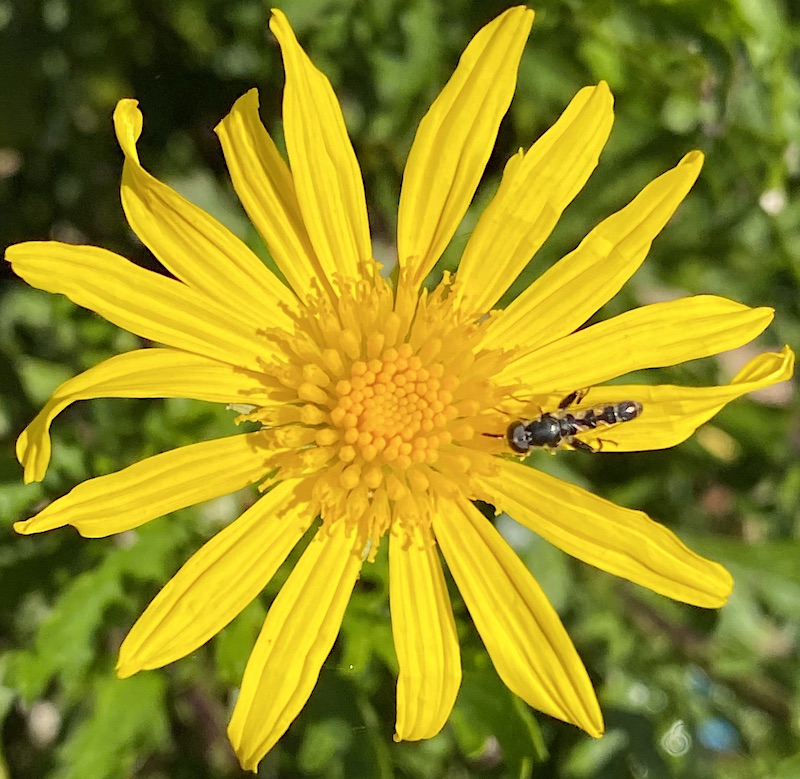
As for Golden Locks… that’s me these days, what hair isn’t silver with age is being bleached golden by the sun as I sit among the flowers, eating my early morning porridge.
I used the excellent guide below, which, sadly, may be out of print but if like me you would find it useful I’ve added a link Natural History Book Shop which might be able to source it.
| Britain’s Hoverflies An Introduction to the Hoverflies of Britain | by Stuart Ball & Roger Morris | WILDGuides | 2013 | 296 pages, 500 colour photos, colour distribution maps | ISBN: 9780691156590 |
Pleasantly trapped in privilege
(31.05.20)
Out in the real-world life and death, cruelty and compassion continue without us and its hard not to feel almost numb within our cocoon. I feel outrage against the racism causing such an eruption in the US. I feel compassion for the millions in Africa with no protection possible from their impoverished states and little likelihood of us rich nations doing much for them while we suffer our own losses; I feel outrage and compassion and shame.
It is so easy to look inward in these lonely times. Pleasantly trapped in a colourful garden with its limited but enjoyable wildlife my ire raises to tales of raptor persecution and unpunished fly-tipping and the selfish entitled actions of our own government, which really should fade pale in the light of so much more deadly and ubiquitous cruelty and crime elsewhere. Privilege, selfishness and arrogance everywhere should be outed and shamed.
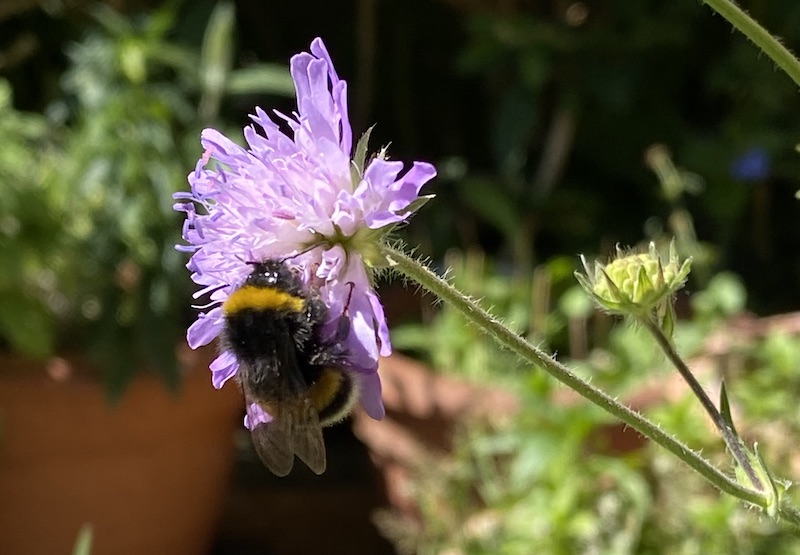
Cocooned and privileged my daily concern is whether this is a White-tailed Bumblebee or a Garden Bumblebee.
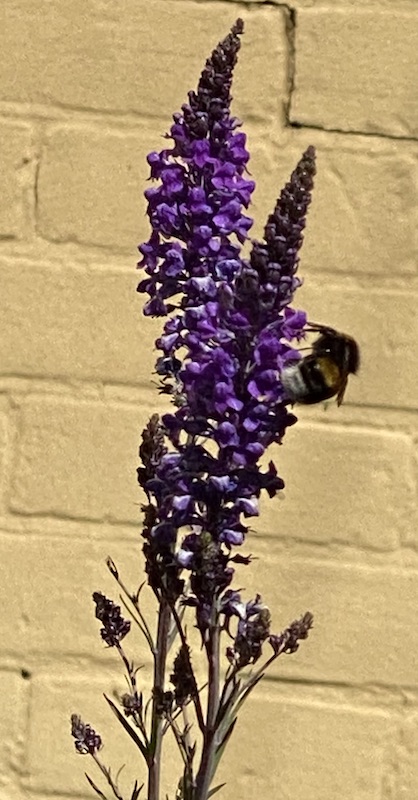
It’s harder to see the tadpoles now that their legs are formed and they seem to have dispersed around the pond. However, the frogs continue to delight. Underneath our feeders we have a plastic bowl set into the ground to catch the seed and suet dislodged from the feeders. Every now and then we lift it to empty out any soggy remains after the Blackbird, Robins and Dunnocks have picked it over. Last time Maggie did this there were two small frogs beneath… presumably there to eat all the small slugs that make it their home.
As I sit by the pond reading or trying to photograph the bees and flies I’ll catch a movement of foliage or hear a plop as a frog jumps in or out of the water. Today this fellow jumped onto the pond wall and peered out at the world.
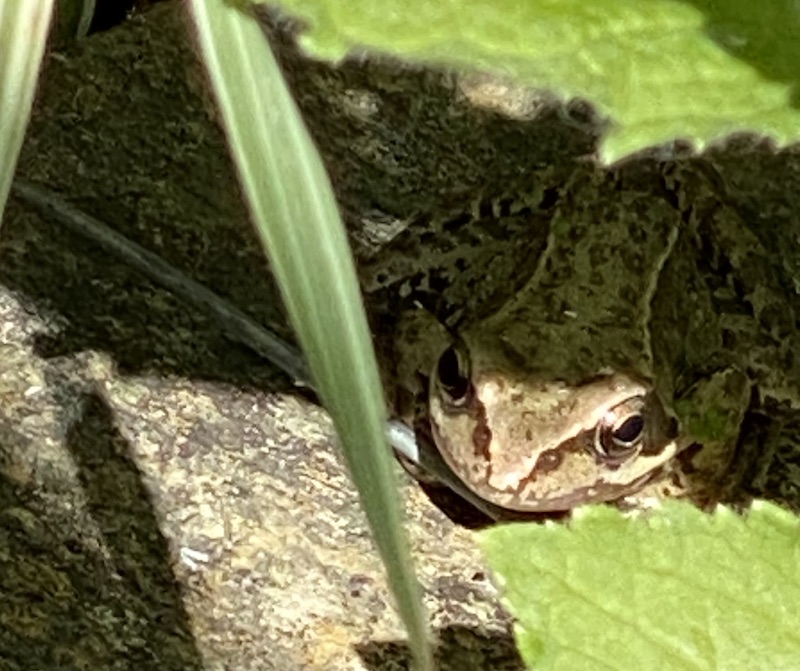
Lush Lassitude, warm but wobbly
(30-05-20)
Still a bit unsteady I decided that much of the day should be spent catching up on work I should have done already.
Lassitude seems to be one of the defining themes of lockdown along with overgrown hair and all day pyjamas. I am doing enough to keep projects ticking over, but hardly stretching myself. I started a novel at the beginning of the year and had it half written by lockdown and haven’t written another word for ten weeks. Website updates, writing assignments and the rest of what I should do has become minimalist… just getting by, not my normal pace at all.
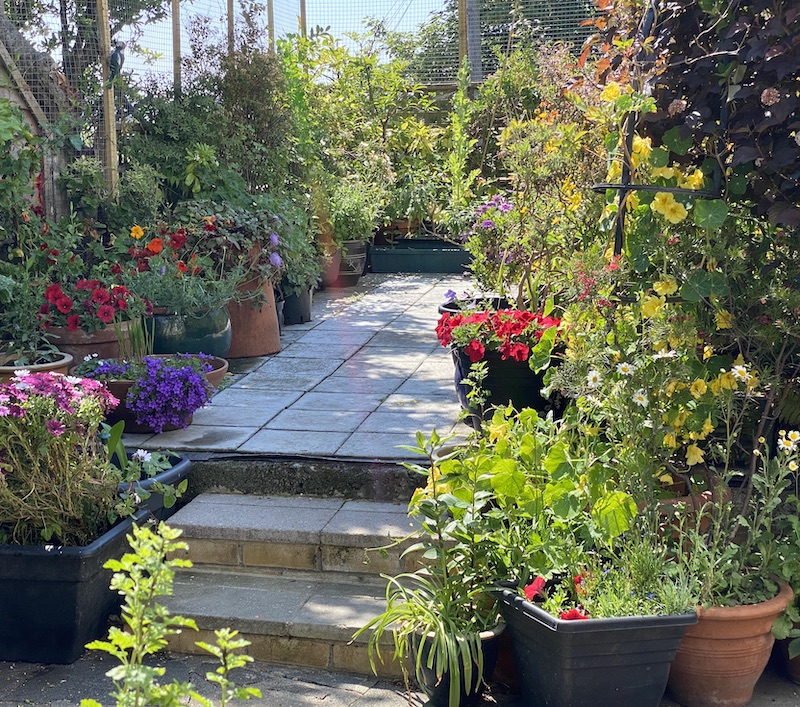
But today I only sat in the garden in the late afternoon, too late even to potter or water the garden, but time to sit back and enjoy it. Bee paucity has turned to bee city, slow growth is now an onrush of blooms and lush foliage and the gentle tones of spring are now the frowsy hues of summer come early. Its definitely looking lush now.
I did almost nothing except sip a cold drink and watch my legs going red in the sun… almost nothing as I also spent time being self-congratulatory. We had worked hard and now the garden is approaching its best. A tweak here, some weeding there, TLC as needed and a few pots moved about and its looking good. I’m particularly pleased with having trained a yellow nasturtium up into the trellis.
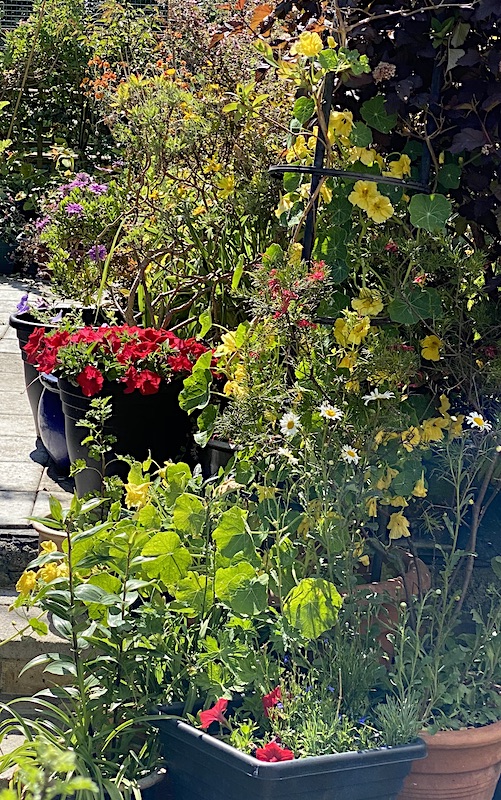
Neck and Neck
(29-05-20)
I awoke today with a crick in the neck, which is a pain in the neck metaphorically too. Because of my AS (Ankylosing spondylitis) this causes ‘positional vertigo’. It means when I walk around I stagger like a drunk. I’m fine sitting in front of the computer or in the garden, it’s just getting between the two that is wobbly. This can last several hours or several days… so today’s blog is a bit of a catchup with stuff in the garden over several days that didn’t make the daily cut.
The butterfly count is uncharacteristic this year. There was the great surprise of a Brimstone but otherwise fewer species than normal with at least three we regularly see by late May not having shown up while we watch. The list so far is: both Small and Large White, Holly Blue (most commonly seen with sometimes several at a time), Gatekeeper and Red Admiral (below).

A somewhat worn Red Admiral Vanessa atalanta on the prolifically flowering Pyrocanthas
Pyrocantha translates from the Greek to Firethorn in English, which is its common name… the European native being Pyrocantha coccinea which has bright red leaves thus explaining to the name… although the thorns are vicious as any gardener who has found out coming across their dropped twigs when weeding, or even, as I have, having had the thorn penetrate the sole of a shoe setting your foot aflame with pain! This year the blossom is as dense as I have ever seen it, so there should be a bumper crop of berries for the birds – they are much loved by the thrush family in particular. I hope some remain into winter and we might get a fieldfare or redwing in the garden.
Looking up the Red Admiral scientific name taught me that it was formerly called the Red Admirable, and it certainly is to be admired when it fans out its wings showing the contrast of jet black, white and red patterning.
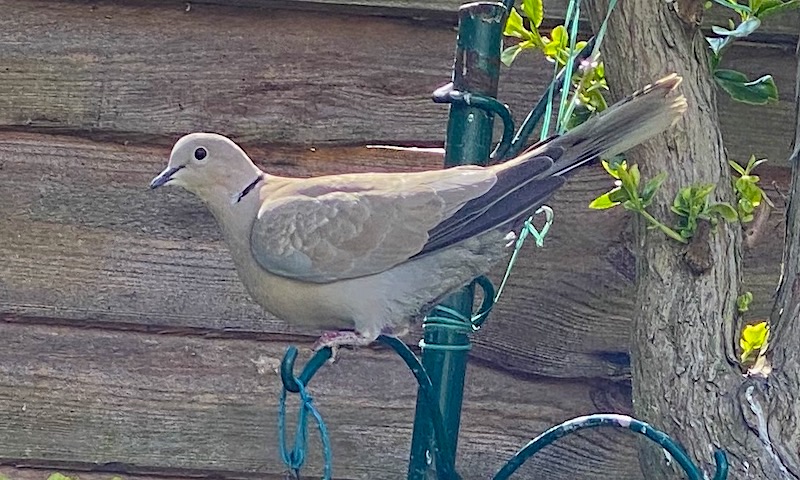
Collared Dove Streptopelia decaocto
The other day I remarked to Maggie that it was a while since I saw a collared dove in the garden. There have been plenty of feral pigeons and several wood pigeons but no collared doves although they sit on the next-door house roof.
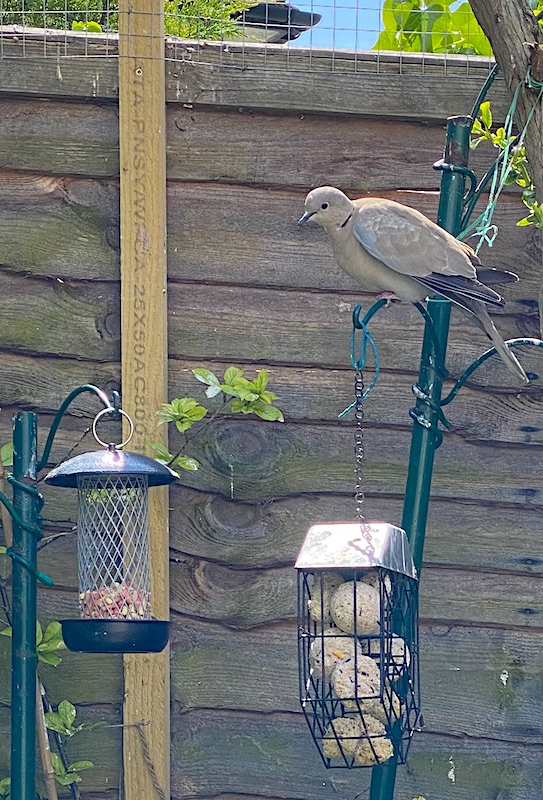
Of course, no sooner had I said it, and while Maggie was telling me I was wrong this dove landed to prove me wrong!
Bumbling Along
(28.05.20)
This has nothing to do with Boris Johnson despite his bumbling having dominated the news headlines of late. I’ll leave my rants about that for twitter et al. Instead I’m referring to my bumbling attempts at Bee ID and the several bumblebees currently flitting around my flowerpots.
I’m pretty sure I’ve got this one right, it being easy to compare its colours and patterns with photos on websites and my personal library. I’m pretty sure there is nothing else of this size with an all white backside! (The confusion species is Buff-tailed Bumblebee Bombus terrestris, but that has a small buffy band at the begining of the white bit.)
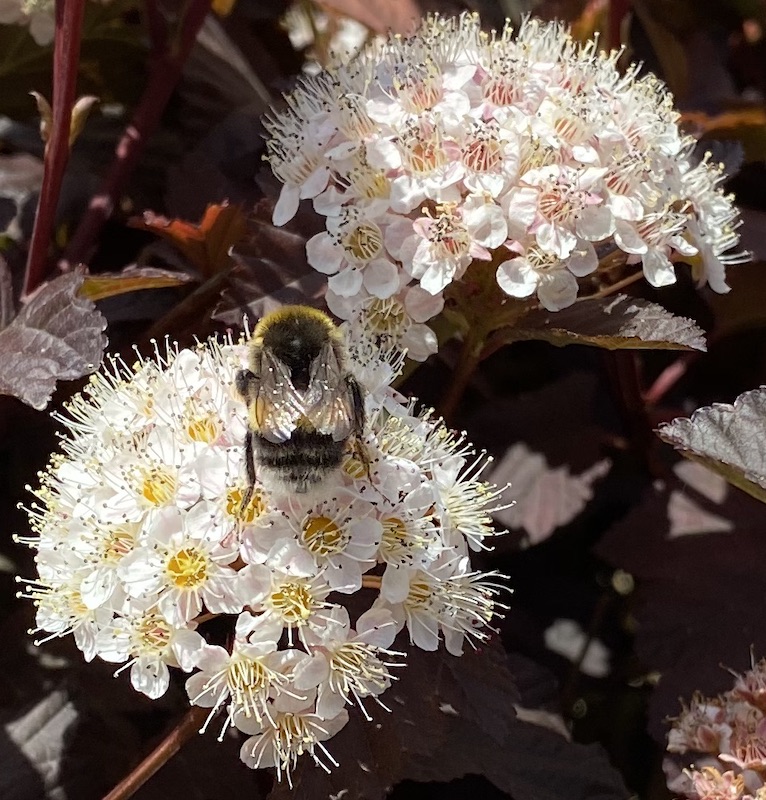
White-tailed Bumblebee Bombus lucorum busily collecting pollen from the blooms on my ‘Ninebark’ or ‘Diabolo’ bush Physocarpus opulifolius
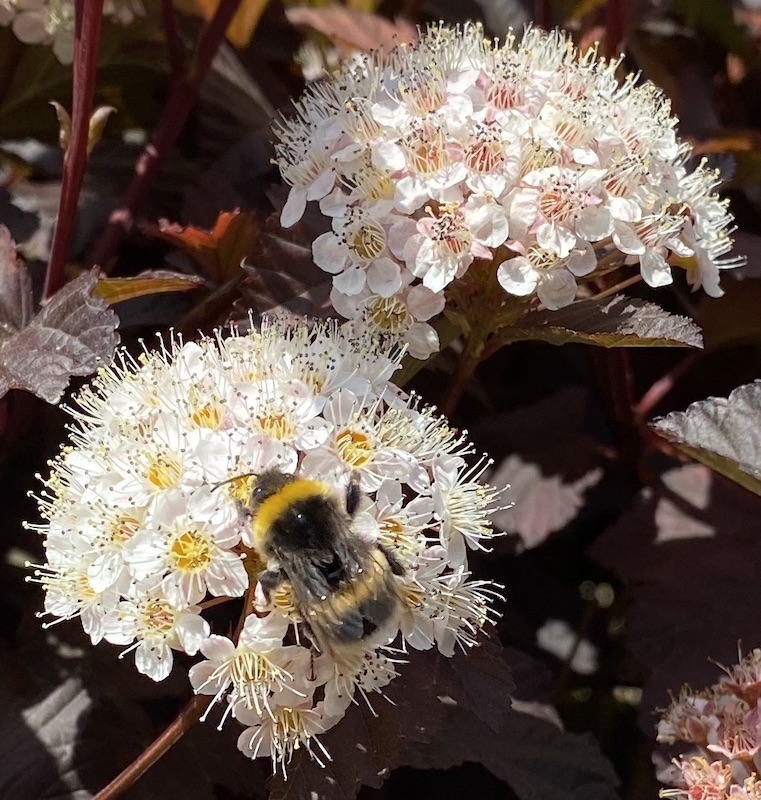
Less of a triumph is the bee below… all my attempts at identification came to naught but I had to be helped out by a kind lady at the bumblebee conservation project.
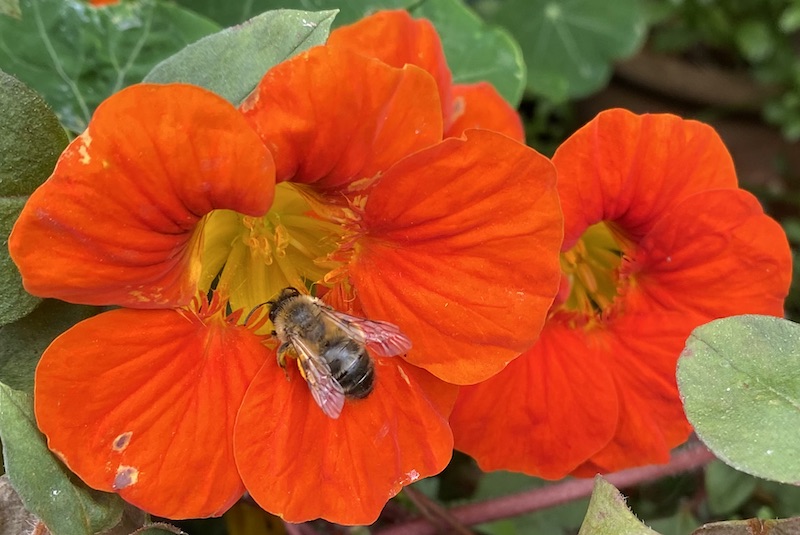
Buffish Mining Bee Andrena nigroaenea
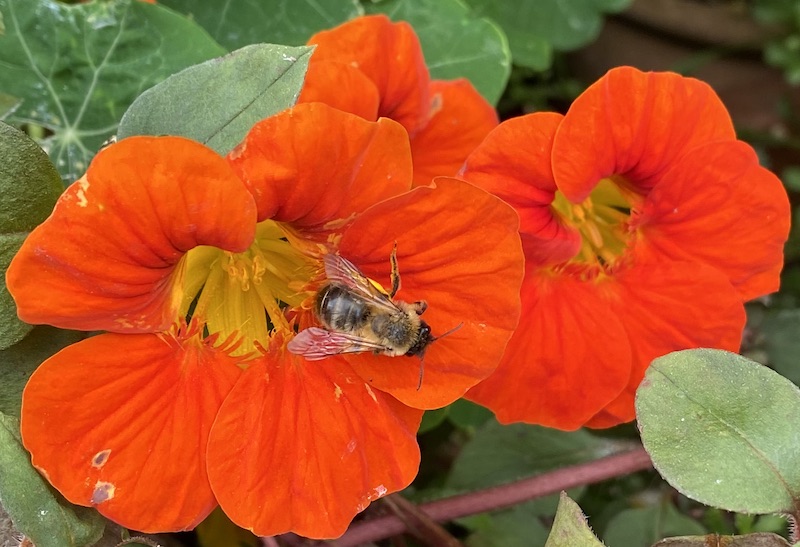
…same bee, different angle… mining the pollen from a Nasturtium bloom
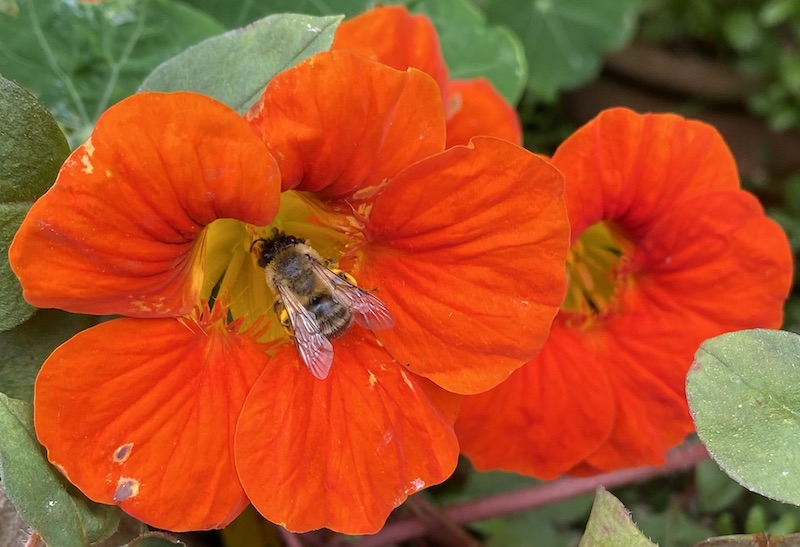
Another glorious May day with clear blue skies and temperatures in the high 70’sF. Overhead the same few swifts and around us a constant commotion of scrambling starlings rival parties of youngsters coming in to brawl like teenagers on the beach. Lockdown is keeping us alive and it feels good.
…and is there honey still for tea?
(27.05.20)
I’ve been worrying about bees as they seem to be in lesser numbers and variety this year… until today. For whatever reason, and I cannot fathom one, the garden was alive with bees today. I’ve been frantically taking photos but am none the wiser on a good many species, so am taking advice before revealing what I’ve had in the yard today.
Having said that, what I am sure of is that there have been a lot of honey bees in the garden today. Having chased them around the garden they seem to be favouring white or pink or purple flowers… this may be different tomorrow so I read nothing into it.
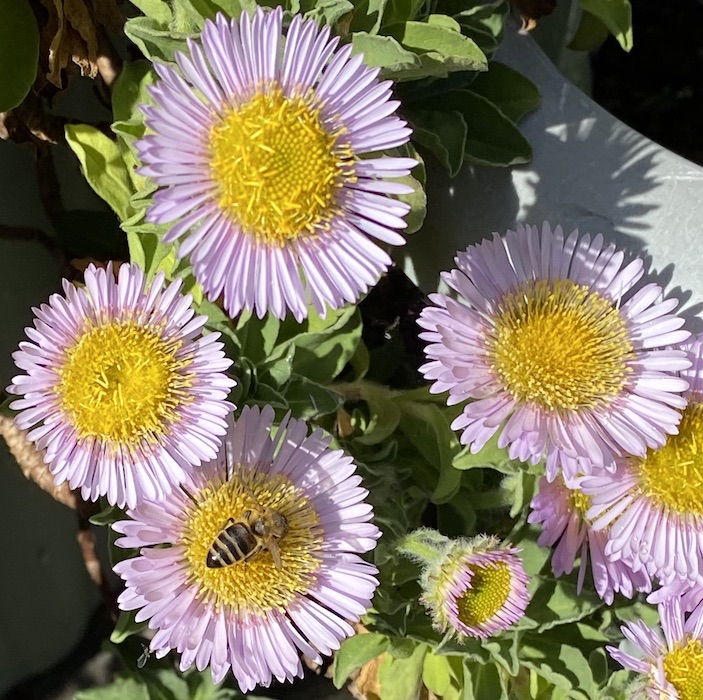
(Western) Honey Bee Apis mellifera
I assume that they have a hive somewhere in the nearby park as I am unaware of anyone keeping them locally.
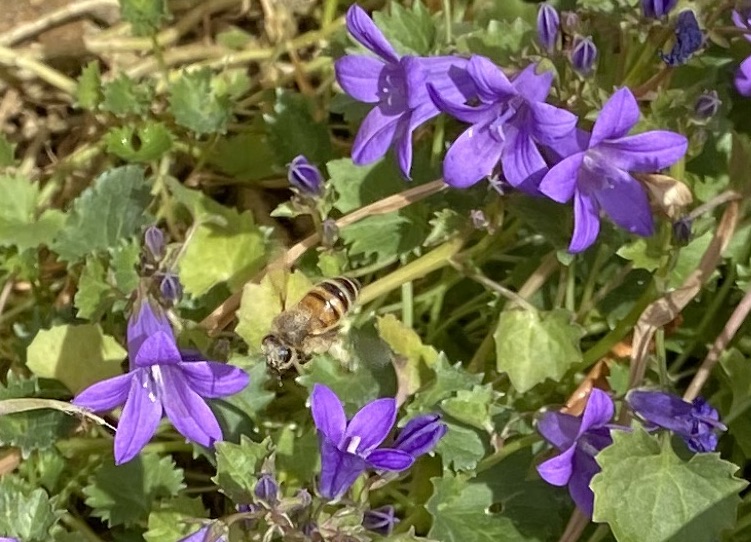
Catching one on camera in flight was much more luck than judgement.
Taking a picture of a frog in the usual place on the pond wall reveals that is a different individual to the two in images from yesterday. This little fellow is almost black… covered in duckweed too.
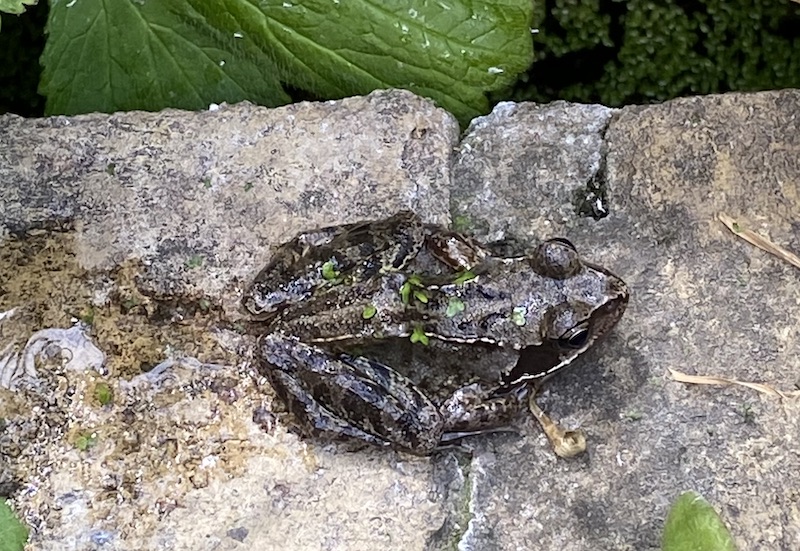
Bee prepared for my next posting when I’m hoping to name names.
Escape From Stalag 18
(26.05.20)
Feeling much sunnier… hence the pretty picture:
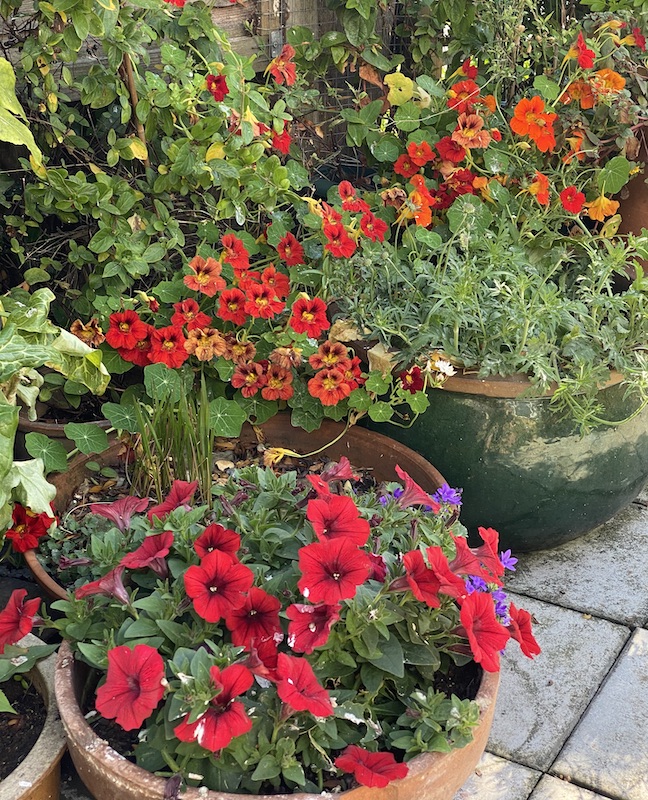
For only the third time in ten weeks we broke out of house arrest and went for a drive (previously it had been for medical appointments). It was truly shocking to see so many people out and about INCLUDING PEOPLE OLDER THAN US OFF TO THE SHOPS! I think people have just heard ‘its safer outdoors’ and have forgotten all the stuff about social distancing. I think we are going to have to brace for a second surge… heaven knows how Dominic Cummins & Boris Johnson can live with themselves, their arrogance is really making things worse (71% of people polled agree).
In the countryside it was like the busiest of sunny weekends before the lockdown so we couldn’t find anywhere we could walk and feel safe. So, we drove here and there stopping where there was no people and listening to birdsong, seeing five new bird species for the year plus some lovely critters like Banded Demoiselle Calopteryx splendens and a small Grass Snake Natrix natrix swimming across the Little Stour.
Sadly we missed the bluebells while shut away from the world, but were overjoyed to hear a Cuckoo calling – if Swifts are the feature film of summer, Cuckoos calling are the soundtrack. Thanks to Ashley for a recording on one of his recent outings to the Flood Plain Reserve, Milton Keynes.
Back in the prison yard a number of small frogs have taken to sitting on the wall of the pond under the shade of marginal plants. Yesterday there were three together, today these two occupied that spot.
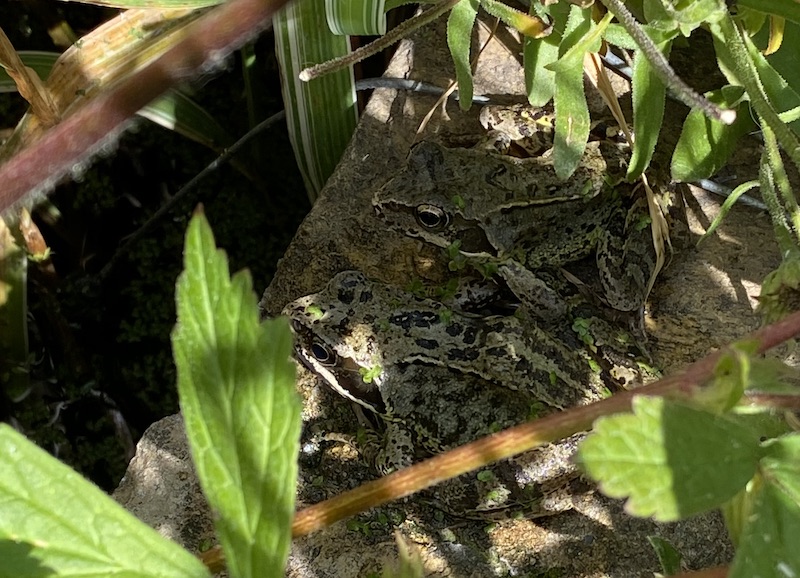
Lackadaisical
(25.05.20)
I’ve always liked to be busy… weekends, bank holidays and working hours never meant a lot, particularly since I began working from home over two decades ago. I do stuff to earn money, and I always have a writing project on the go. Since first being published I’ve alway been writing or researching one book, thinking about the next project or even doing two at the same time. There is always the monthly column to write and as you can tell I blog. I also keep up to date half a dozen websites with Fatbirder being massive.
Today I consider a lazy day, having washed the bedding, watered the garden, potted up some plants, vacuumed, got a couple of meals. A domestic day, physically active but intellectually inert.
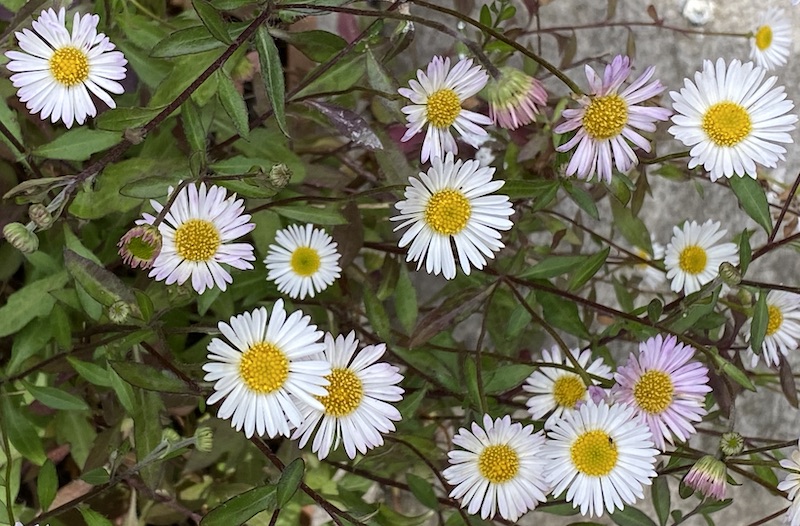
Lackadaisical but not lacking daisies (like the self-sown ones above).
In a month I will be 71 and I’m a ‘pensioner’, but certainly don’t feel retired. I’ve always structured my days and going from ‘having a job’ to being ‘self-employed’ seemed seamless.
If I stop and play a word game or do a crossword it feels like skiving. Even at weekends taking time to read for pleasure or watch a movie feel indulgent. I have no idea where this way of being came from, I did not have a religious upbringing, nor middle-class parents urging me to achieve.
So, today was a chequerboard of this and that and no sense of achievement. I imagine there will be a lot of other people out there struggling without formal structures or the purpose of the daily grind. Lockdown lends itself to directionlessness. It also has given new fears to millions. Those of us who are old or have health issues may feel it more than most… an incipient fear. Those who have to shield may be asking is it ever going to change. If no treatment nor vaccine is found millions will stay isolated never travelling or mingling for fear of contracting a disease that will be fatal to them
On that note an uplifting media addition. A rather better image of the hoverflies I caught in congress yesterday… Eupeodes latifasciatus visiting a scabious bloom.
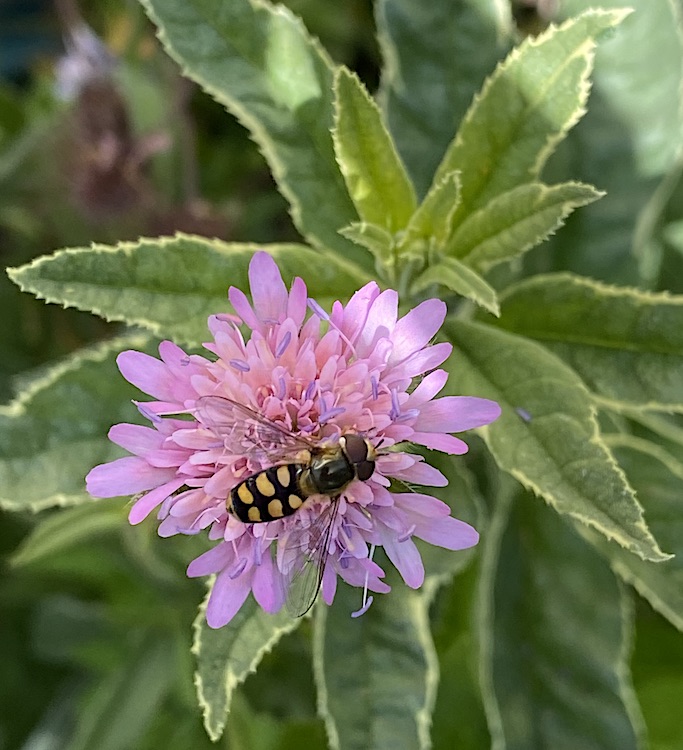
This mood probably serves me right for thinking that all that patronising concern for people’s mental health was a load of guff!
Marmalade Skies
(24.05.20)
Looking like wasps and acting like bees these flies are fascinating. They are useful pollinators, harmless to us and beneficial to flowering plants, but also very entertaining… even if it takes a bit of research to (try and) identify them. There are, after-all, several hundred species in the UK alone. Even my tiny yard has had around 25 different species and each year there seem to be new ones.
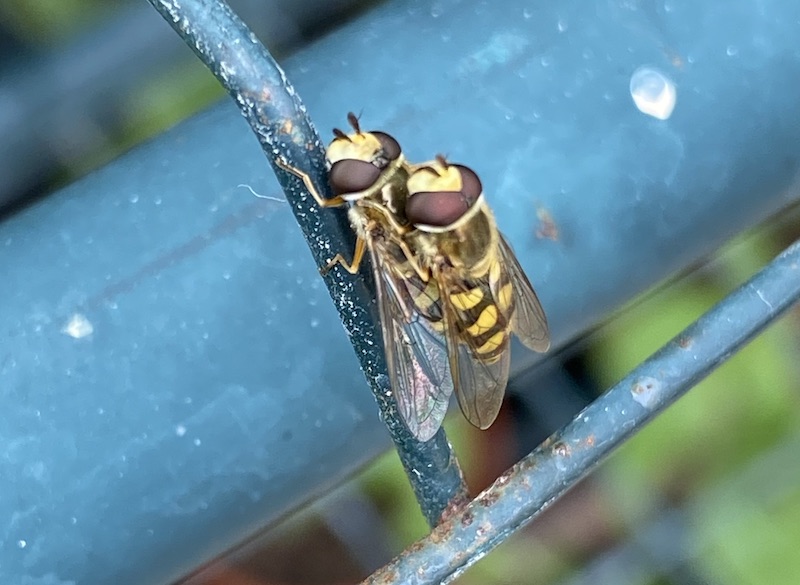
Eupeodes latifasciatus (I think) in congress on shelf of mini greenhouse – they are only 1cm long – notice that one (the female) has a dark area between her eyes.
Only about for or five species have shown so far this year.
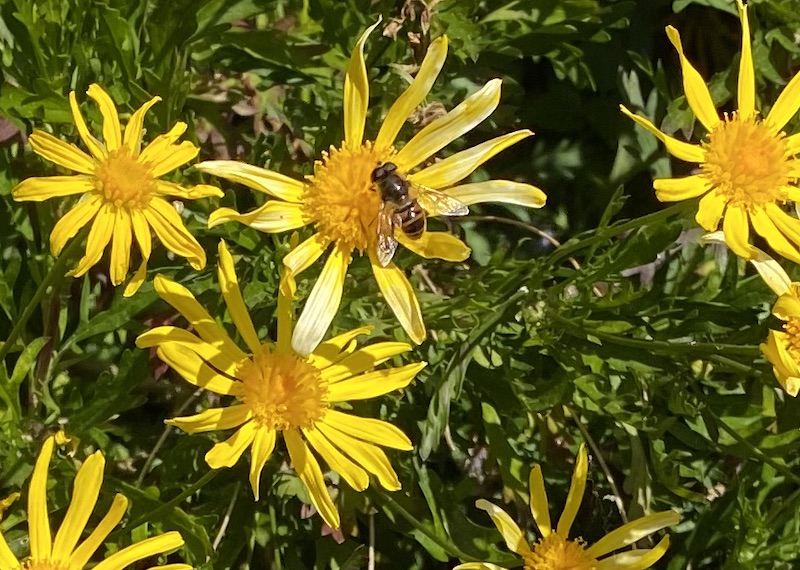
Epistrophe eligans

The Marmalade Hoverfly (one of very few with a common name) Episyrphus baleatus
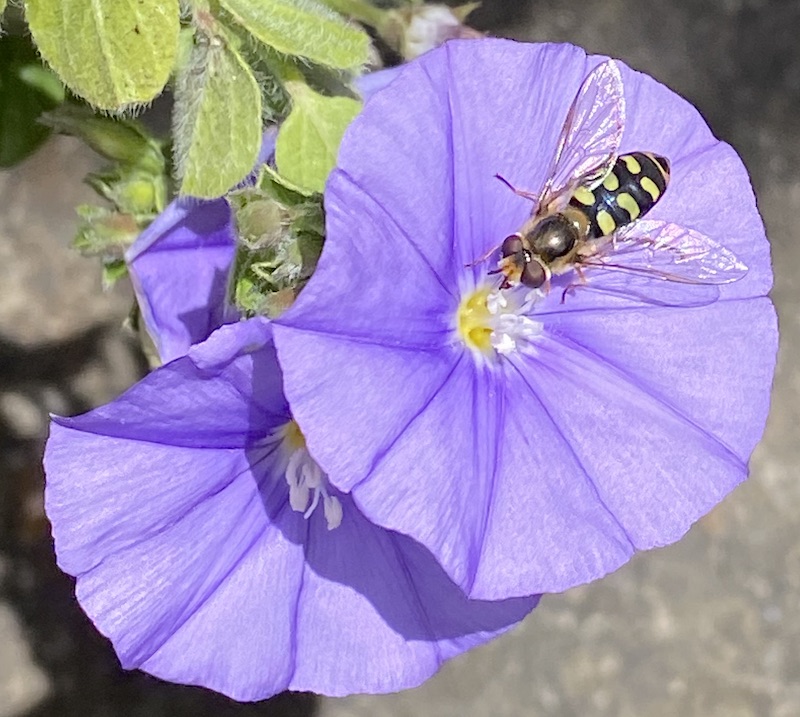
Eupeodes luniger
I find them as beautiful as they are fascinating as the stand still in the air inches from your face or dance around flowering plants. Unlike bees they seem to favour flat and open flower blooms making them much easier to photograph.
We all make mistakes…
(23-05-20)
On a very windy day (c.35mph) there was little to do but water whatever has been air-dried and admire the flowers waving in the wind while musing on how gardens come about and are ever-changing…
The one border we inherited had lots of shockingly pink gladioli dotted about. It’s just not a colour I can enjoy. When I’ve come across the bulbs I’ve removed them… but the one’s I missed have gradually matured and have thrown up the random spikes of in-your-face blooms.
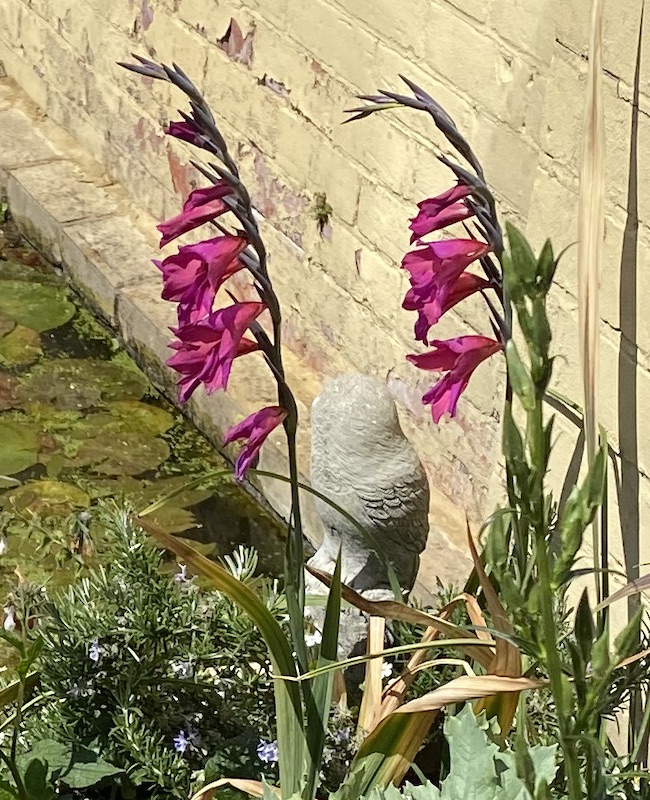
We changed that border utterly recently, building a higher retaining wall, heaping in half a dozen sacks of soil and totally replanting with a colour scheme of white and blues through its spectrum to pale purples. Ignoring my plans completely up they came again! What’s more several fat and fleshy ‘opium’ poppies self sowed and threaten to paint the palette pink!
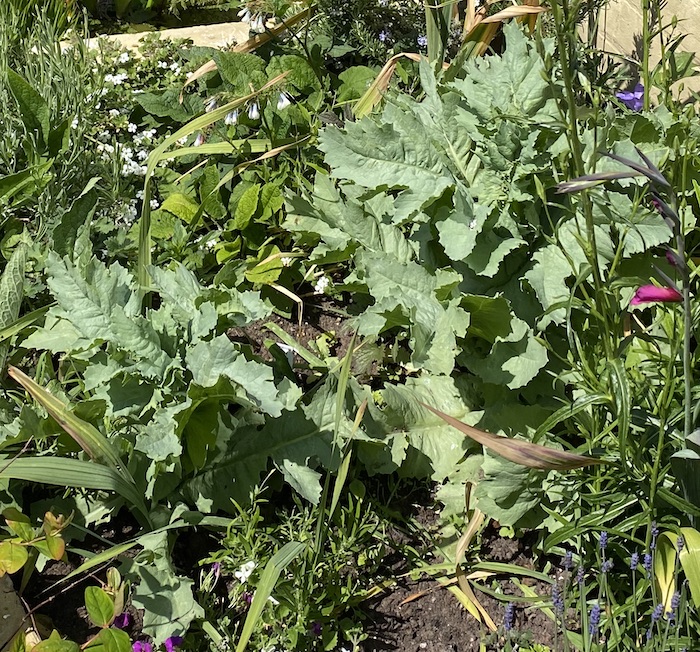
They are big bullies too, currently obscuring a number of new plants that may struggle and others already seemingly swamped. So much for my plans.
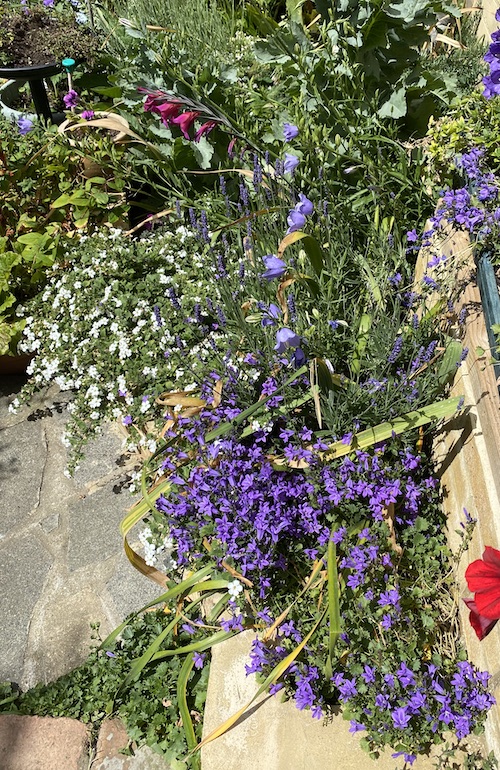
My Blue, White & Purple colour scheme with interlopers!
Sod’s law has prevailed elsewhere too. I planted up a tub with Sweet Williams… which, according to the packet were scarlet in colour. (I allow a smattering of red around the garden as many plants just don’t come in our preferred colours). It was a shock last year when they bloomed in as horrible a pink as the gladioli. I hate the colour, but neither Maggie nor I can bear to rip out flowering plants so they will go on for the rest of their natural lives.
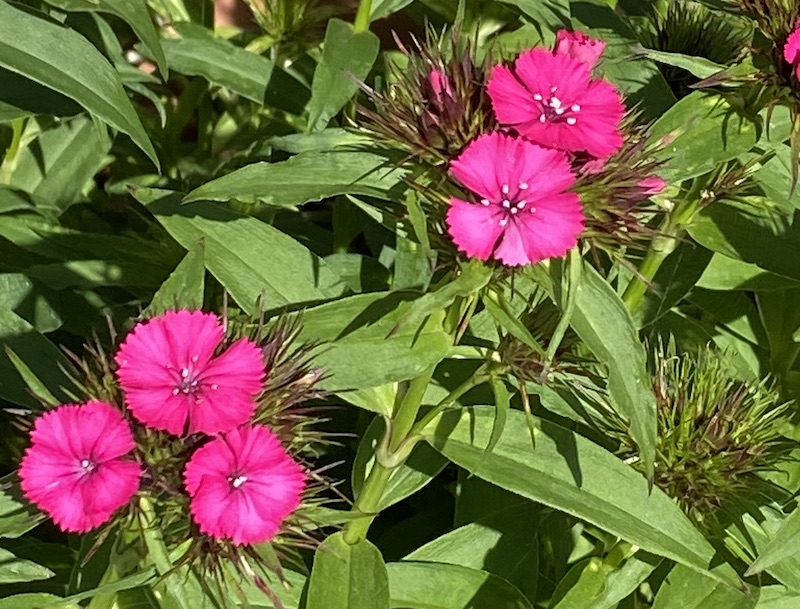
Sweet Williams Dianthus barbatus related to Carnations & Pinks
Being partial to peppers I planted up a packet of pepper seeds. Although the descriptions are all in some Slavic script (purchased on line from what looks like an English company, that turns out to be somewhere in Eastern Europe going by the packaging when they arrived) the pictures clearly show capsicums.
When the first true leaves appeared I carefully potted them on to grow ready for their final replanting. They are definitely NOT peppers. Judging by their leaves, and their red roots, I have carefully potted up radishes! We will see for sure when they finally mature. Can anyone else boast an individually potted radish?
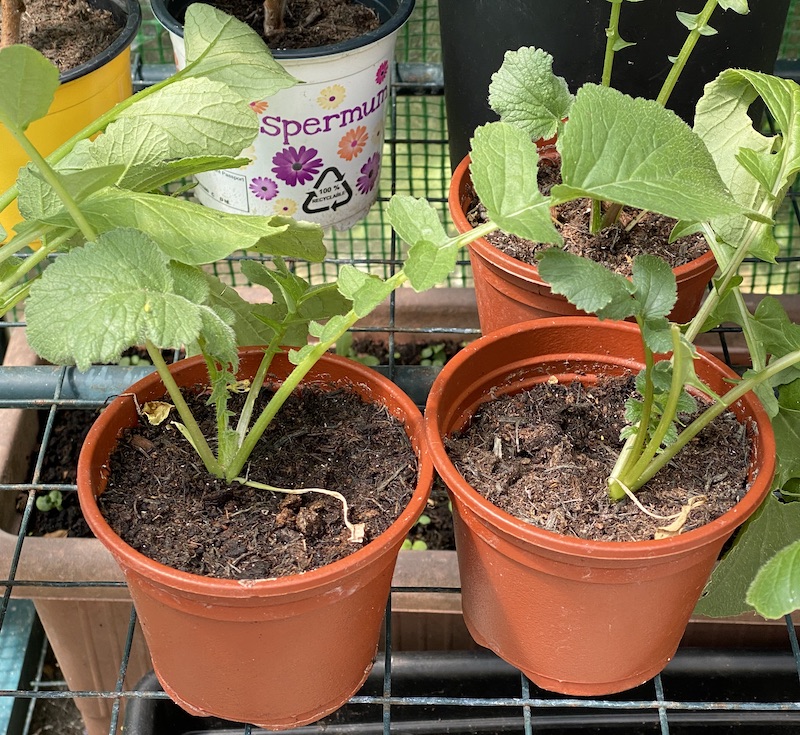
Gross or Gaudy?
(22-05-20)
A frustrating start to my day. I was supposed to be training RSPB staff in all-ability access via Skype but tech hitches scuppered that.
While warm, it’s very breezy (22mph) so not many insects at large with birds having to use up energy to balance when feeding. One good thing is that we should get away with not watering the garden.
One insect around most of the year is the Common Greenbottle – a fly found across much of the world.
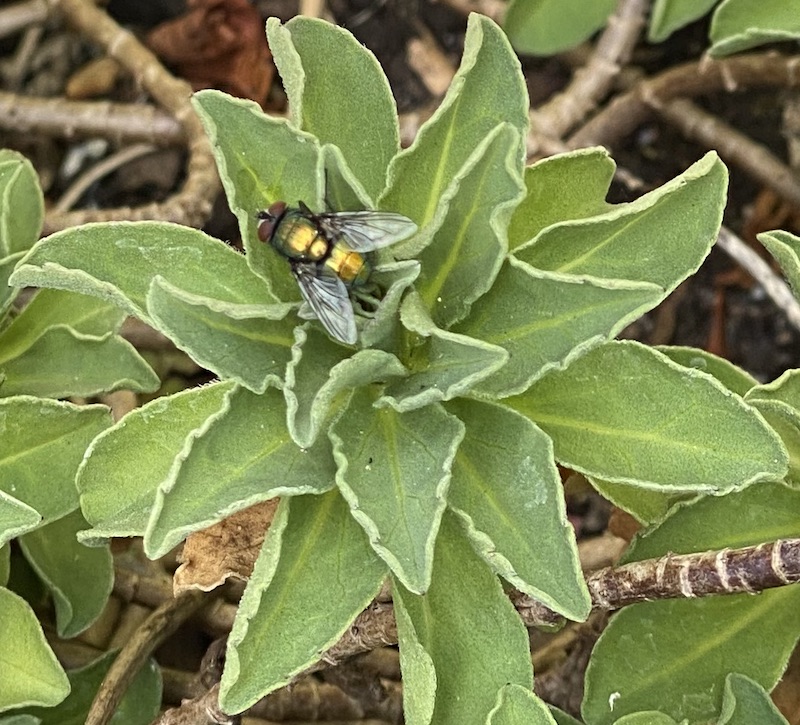
Common Greenbottle Lucilia sericata
In the sun, the metallic green to copper sheen makes them look like glittering jewels on the leaves or petals.
They lay their eggs on the rotting corpse of anything and the maggots hatch to feed on the rotten flesh. As gross as this might seem they only eat the rotten flesh so it is their maggots that are sometimes used in wound therapy to remove the decay and thus helping wounds to heal.
So glittering gem or gross out bug… you decide… …and while you do here’s another glittering gem.
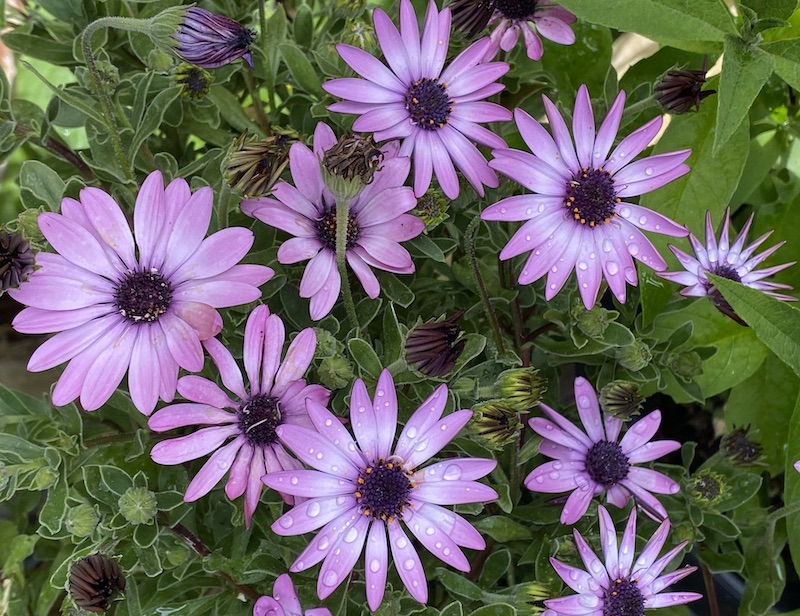
Freshly watered Cape Daisies Calendula osteospermum
Mouldy Toast & Toasted Toes Amongst the Planting
(21-05-20)
Hottest day of the year so far… forecast 24 degrees… my sweat glands say otherwise… top twenties to low thirties in our sun trap. Too hot to plant the stuff that arrived yesterday more than 5 weeks after I ordered it. So, I was out before breakfast avoiding the heat of the sun.
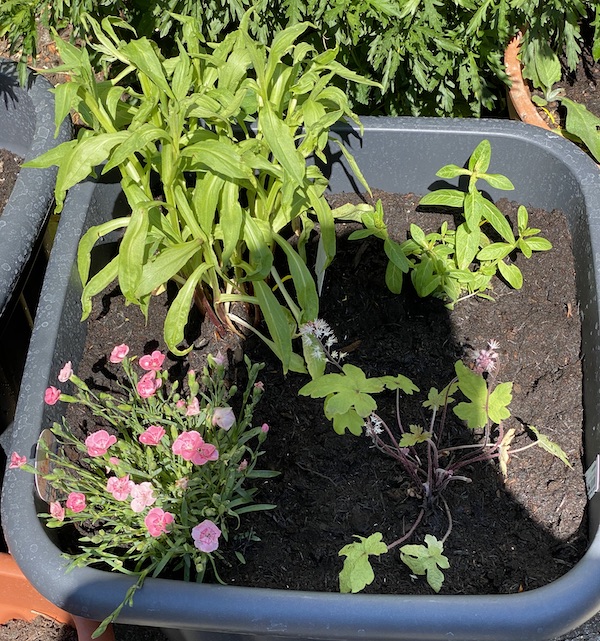
Having planted everything, and well-watered them in, I should have had a satisfied smirk with breakfast. I managed the smirk, but breakfast was a lot harder.
When you are ‘shielding’ you have to rely on deliveries… and delivery days are whatever you can get, IF you are lucky enough to get any! So, at best you can buy bread once a week. (What an irony it is that a week before lockdown we had given away our bread-making machine certain that we had no further use for it!) I like organic wholemeal. In this weather it is four days max before it moulds. Yesterday’s breakfast was but one bite masticated but not swallowed. I hadn’t seen the mould, but could certainly taste the stuff – yuk!
Maggie prefers what I call ‘cotton-wool bread’ – cut, white and full of e-numbers. She told me I could use hers today. I toasted it and then saw the little blue spots, yuk again. So breakfast was one choc-chip brioche (Maggie’s normal breakfast fayre), with the tomato I had already sliced for my mouldy toast. It ‘fills a hole’ they say… as did the dozen plants now in the once vacant pots.
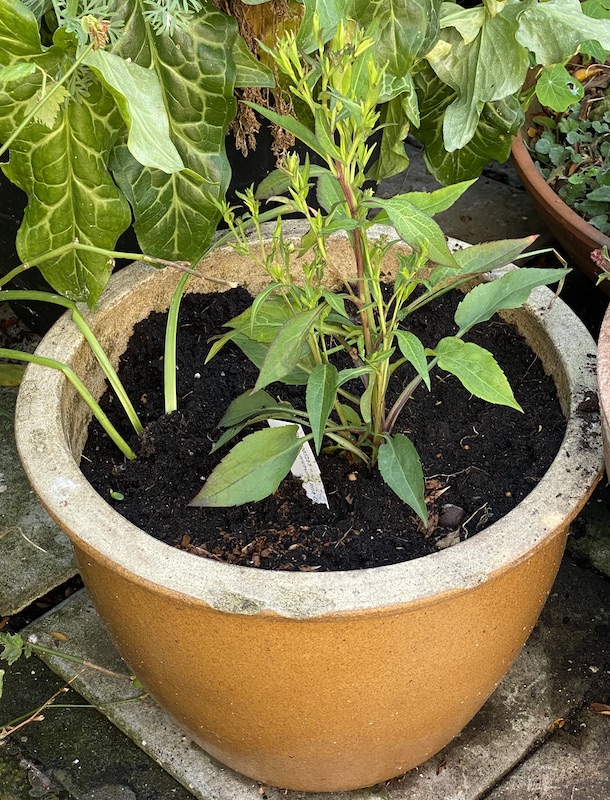
Companion Planting
Strictly speaking, companion planting is the practice of planting things with or near others because the two species can help each other. For example, Carrots and Onions are planted in alternative rows because carrot flies are put off by onions and the onion fly hates the smell of carrots. However, what I mean is the art of planting things in the same pot because they set each other off and look good together. Sometimes you can fill a large pot with several plants of one species…
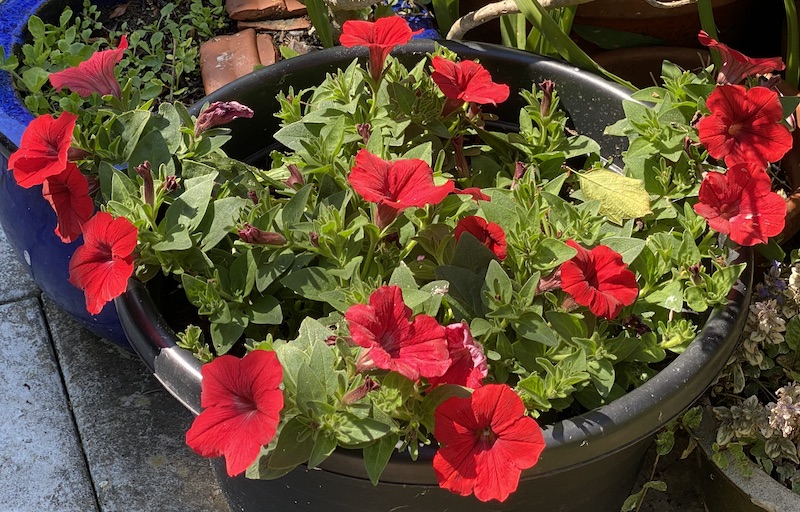
…sometimes different varieties of one species together…
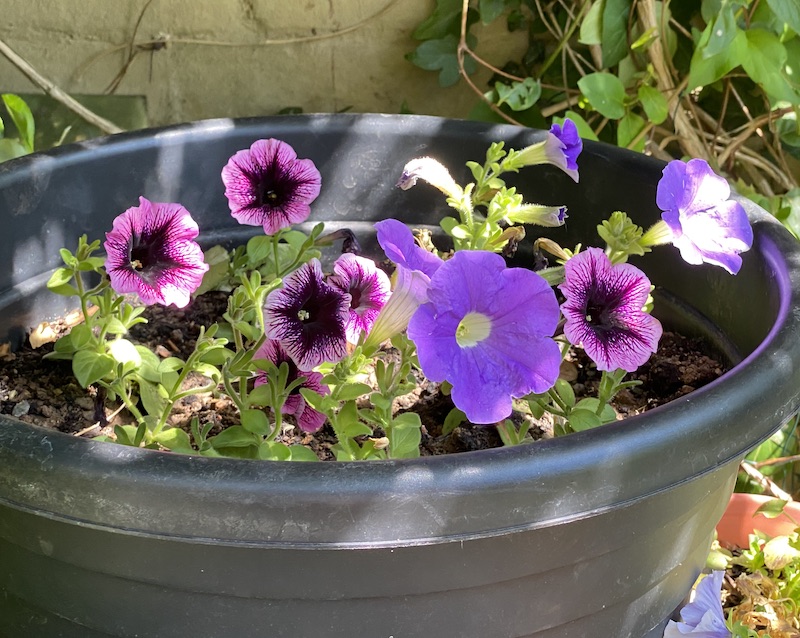
…and sometimes different species whose, leaves, shape or colour compliments the other…
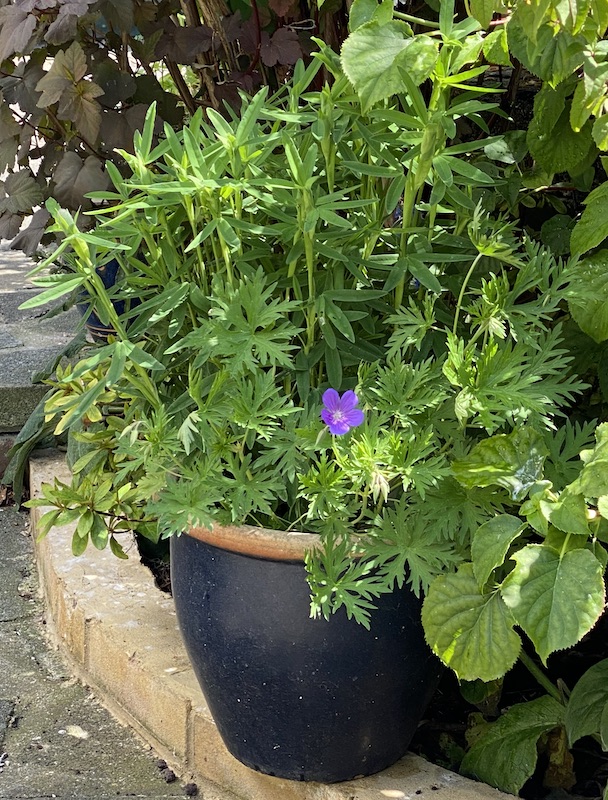
I recently moved this pot out of the sun and it loves the semi shade. The plant at the back of the pot will have fluffy pink flowers setting off this pretty purple geranium in both shape and leaf look, as well as colour.
This afternoon, I spent ten minutes in the full sun watching a few swifts cleave the unclouded, deep blue sky. Longer and I would have been toast. Most years you can see the mouldy blue veins in stark relief against my ancient milk-bottle legs. I’ve not even had cardboard-colour legs since I spent three weeks in Corfu four decades ago. Beer, Mataxa and olives in copious quantities consumed while your feet dangle in the Adriatic can lull you into sitting overlong in the sun. However, the olive oil seems to offer tanning protection from the inside.
Just over two months of lockdown garden pottering while the sun shines, has turned my legs something just south of ivory-coloured. A few more months of this and I might get to light oak or polished pine. Toast me for a whole year and I’d still not make it to teak, let alone mahogany.
World Bee Day
(20.05.20)
Today is World Bee Day. Bees are in trouble almost exclusively because of the actions of man! In general with most other life on our planet bees are diminishing – without them we will die out too, so it is incumbent upon us to do everything we can to save bees. Despite which we are still using [pesticides that kill bees. We destroy habitat and even when we keep bees commercially recent practice stresses bees. Moving hives around to take advantage of flowering crops, and taking advantage of their pollinating powers causes the hives stress. Stress makes them vulnerable to parasites and colonies die.
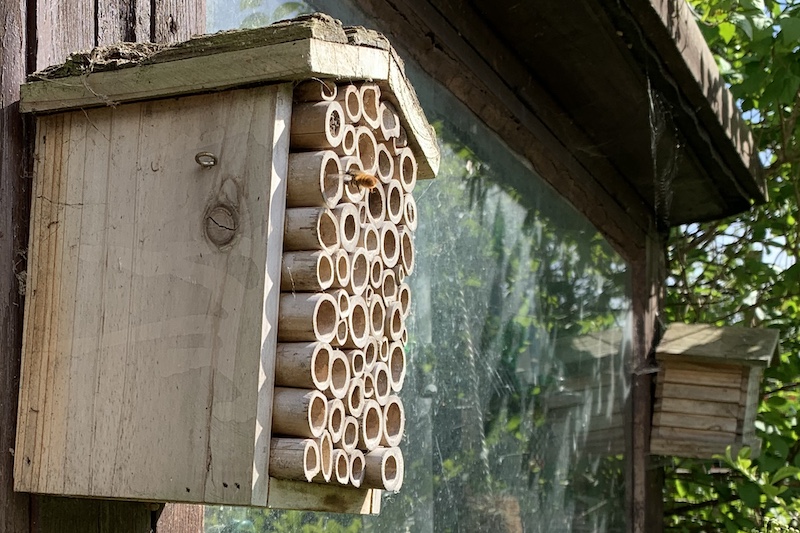
We should do everything we can to make the land we own bee-friendly. Installing bee houses for solitary bees is a start. Growing flowering, pollen rich plants helps and doing so organically is vital.
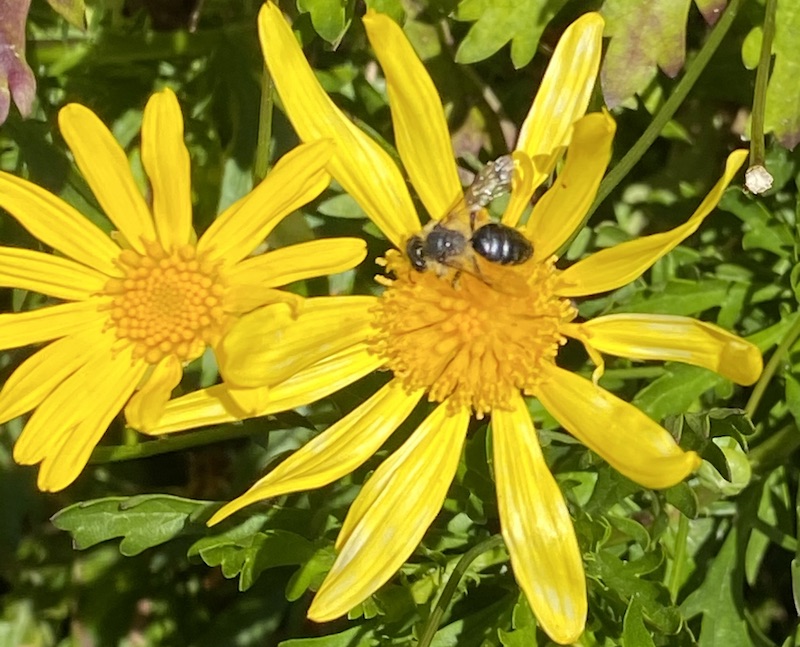
Bees are different to flies having four wings, prominent antenna and very narrow ‘waists’ between thorax and abdomen.
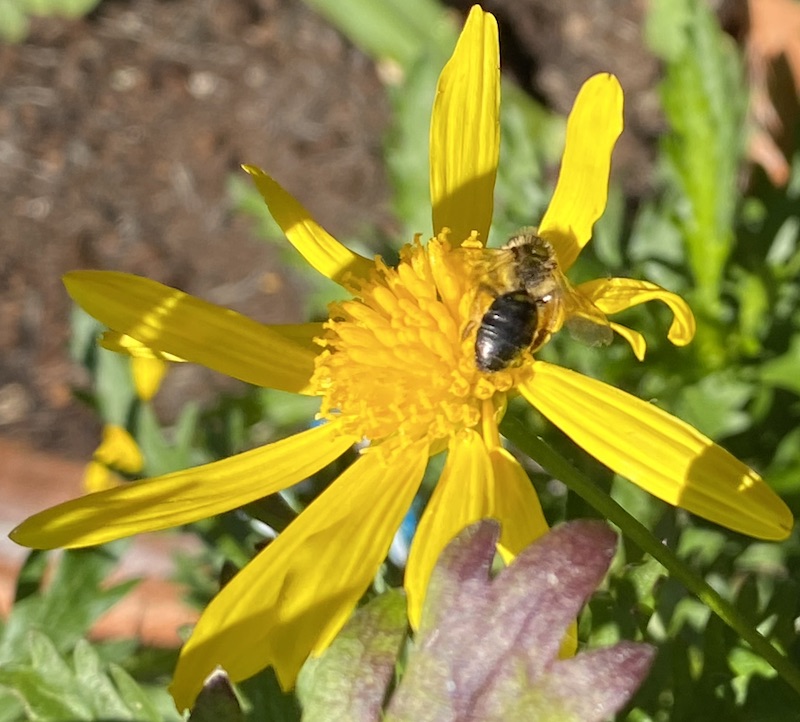
Many are hairy but so are some hoverflies that mimic bees.
Do your bit for the bees!
Busy Bees
(19.05.20)
Rather worryingly, there have been far less bees in the garden this year. Our bee houses stood empty and few individuals were about. A few of the early solitary bees were popping in; Early Bumblebee, Tree Bumblebee and the huge Garden Bumblebees have been in but in small number. The only bees that has been around for the whole of lockdown have been Honey Bees and the Common Leafcutter Bee… it has been gathering something too small to identify at the protruding roots of a pond plant since late March.
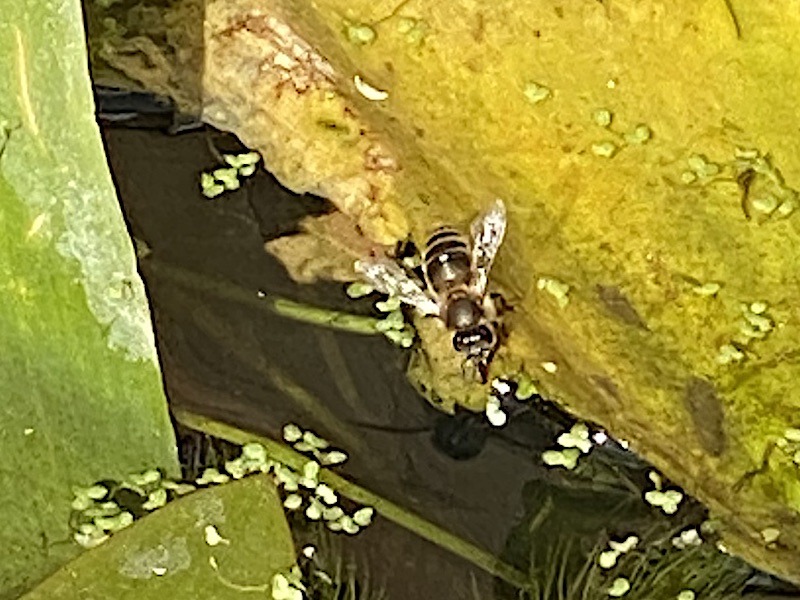
I mis-identified this as a Common Leafcutter Bee Megachile centuncularis – Ash has pointed out why this is a hoverfly species… one of the bee mimics which we have not tracked down
But, thank goodness, things have been getting busier over the last few days with them making bee-lines to several of our bee-houses.
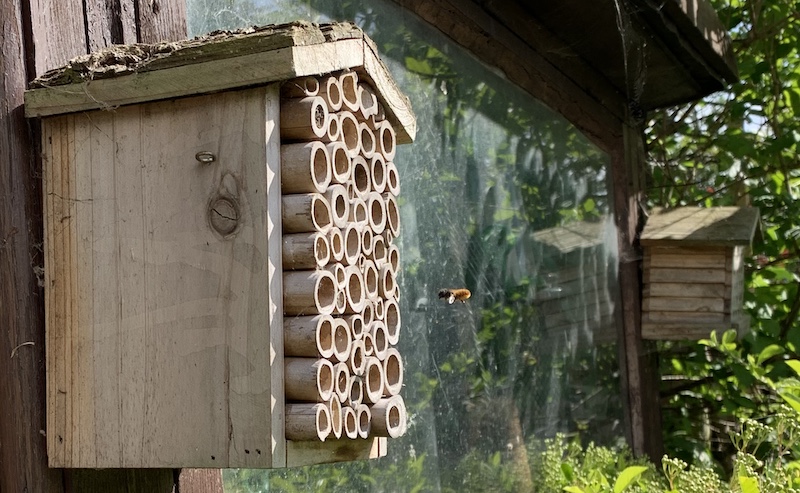
I’m no expert so others might want to question my ID but I am pretty sure there are at least two different leaf-cutter bees and as many different mason bees getting busy. The mason bees lay an egg and seal a chamber with mud; the leaf cutters fill several chambers in one hole sealing each with a part of a leaf harvested for the purpose. Maggie’s chore is removing spider webs from around the houses and cursing the spiders that lay in wait. (She was never enamoured of arachnids, but has been a one woman scourge of them all since being stung by a scorpion!)
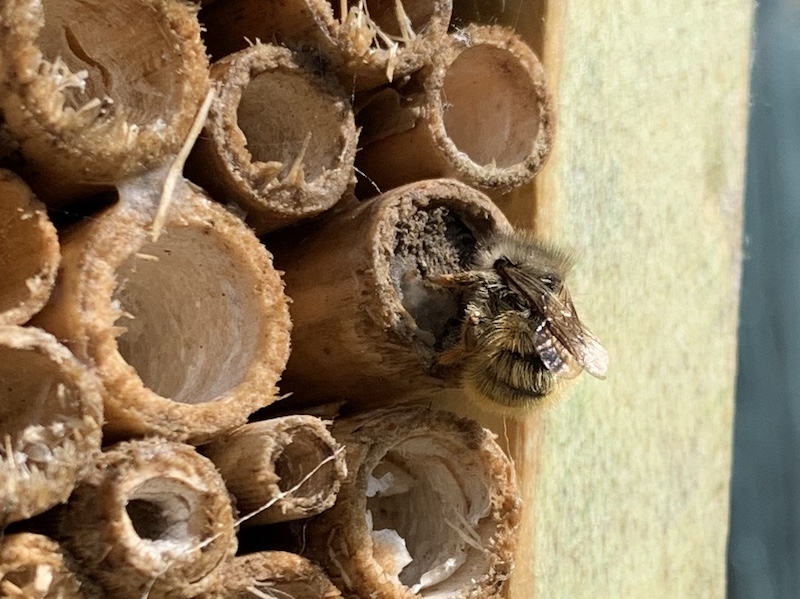
I think this is a male Red Mason Bee Osmia bicornis with the female below
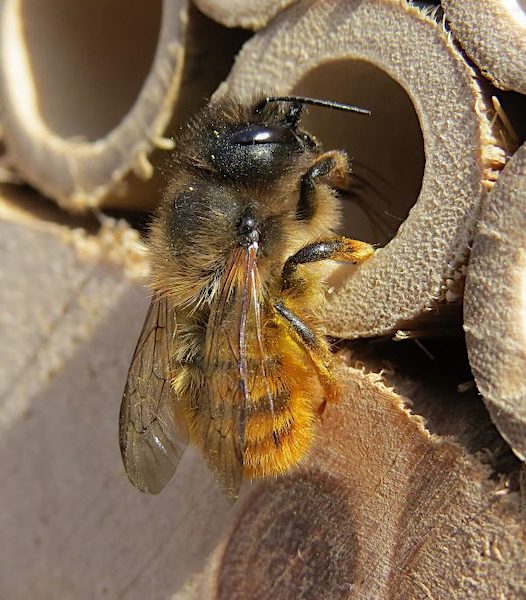
Getting There
(19.05.20)
It’s probably that we started sitting out in the garden much earlier this year but it seems to have taken forever for the garden to bloom in all its glory. It’s still probably a month before it will look its best but its definitely getting there.
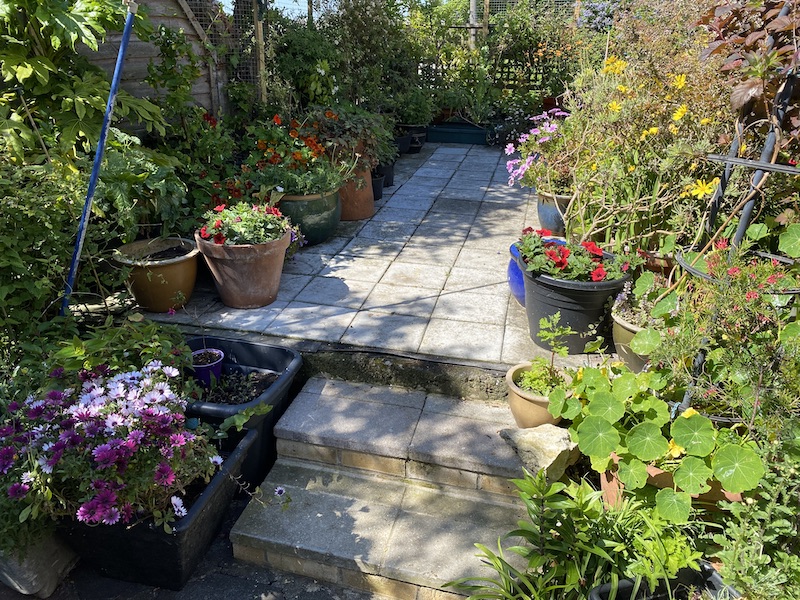
Calla Lilies Zantedeschia aethiopica are at their peak…
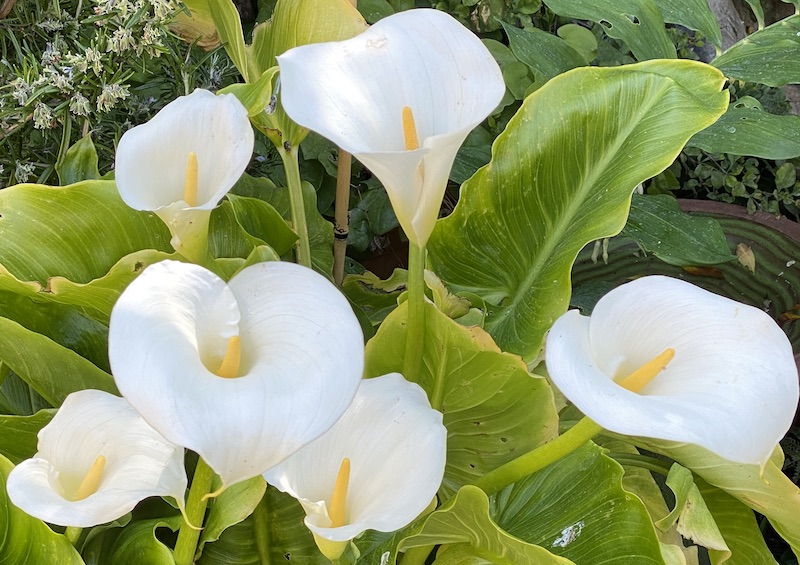
But Campanulas (Bellflowers) like this white form of Campanula persicifolia are only just breaking into bloom…
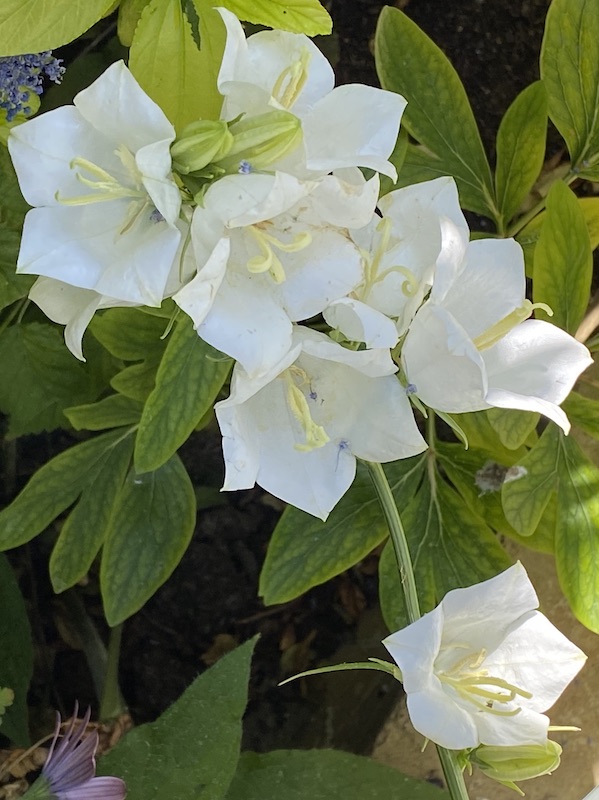
With Scabious Knautia arvensis just putting in an appearance.
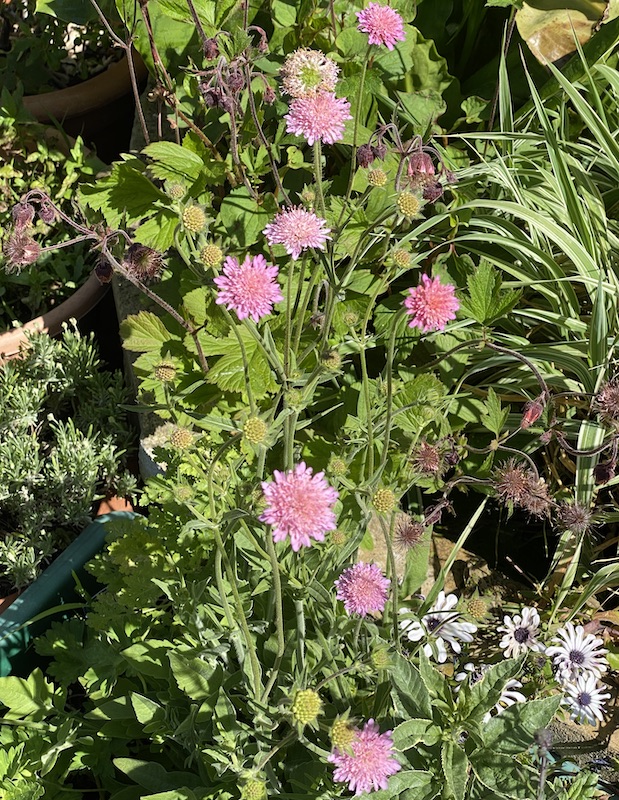
Saved by the Ark
(18.05.20)
Maggie is not fond of Starlings… they are bully boys who force off her ‘lads’ (House Sparrows) from the feeders. Personally, I cannot help but admire them as the very embodiment of survival. They are fast to adapt and combine sheer intelligence with clever use of their physical strengths. It’s not surprising that they are feral in many countries and their relatives world-wide have a history of being invasive… of note their cousins, Common Myna’s in Australia and New Zealand.
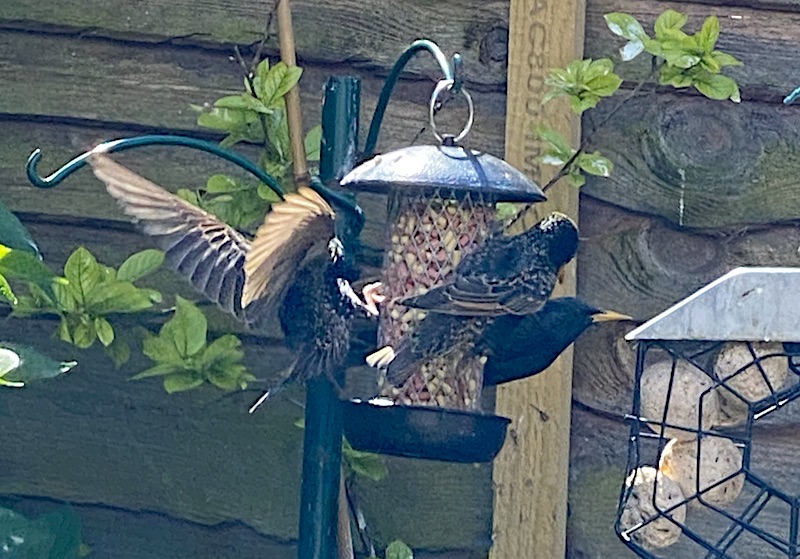
Common Starlings Sturnus vulgaris spot the suet
But they give a new meaning to fast food… boy do they go through food FAST! This year Ark Wildlife have been supplying me with a range of food. Mealworms, Flutterbutter, Fat Balls, Nyjer, Peanuts and Sunflower-hearts fill all my feeders. (They even supply tadpole food for the roiling masses of tadpoles churning up my pond this year).
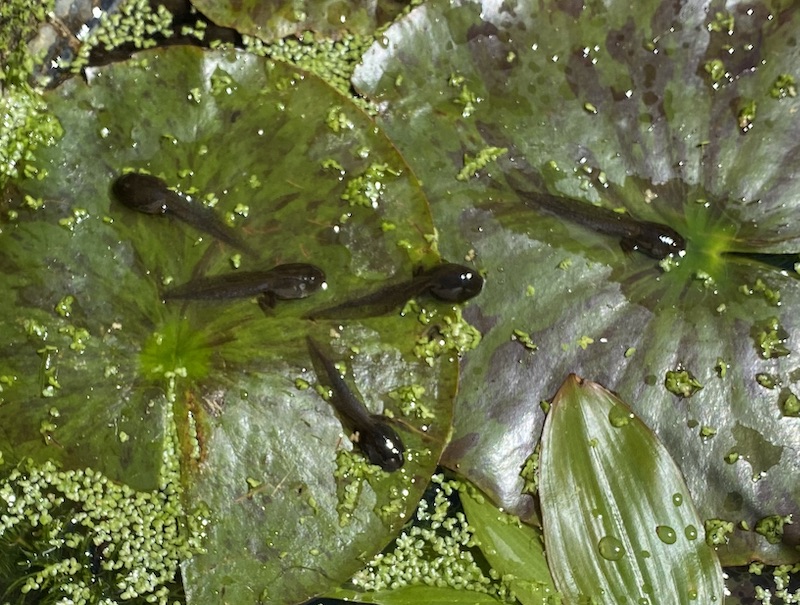
I’ve no idea why they have taken to wriggling onto the lily-pads?
However, since they began supplying me with suet pellets it’s been mayhem. Even the insect eaters use the feeders now. The only birds who prefer anything else are Goldfinches on the Nyjer seeds and Ring-necked Parakeets on ‘their’ apples. It seems like I’ve been begging Ark for more suet every week!
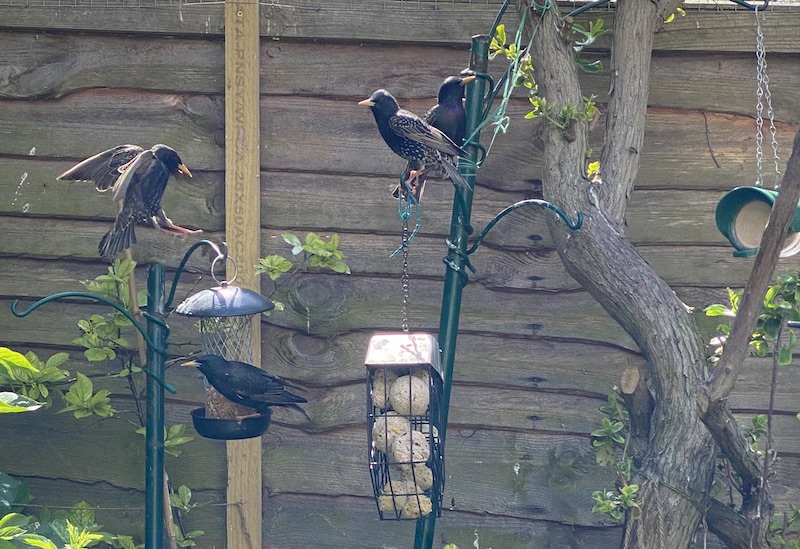
As Sean McMenemy, CEO at Ark Wildlife told me, at this time of year they ship out the pellets as fast as they can as demand rises. He also tells me (thank goodness) that it peaks when the Starlings bring in their offspring, but then tapers off so everything else gets a look in.
The rapacious little buggers can go through a whole jar of flutter butter in a day too!
We tried to even the odds for all the other species, even buying in a couple of feeders designed for smaller birds… guess what, the only birds using the starling-proof feeders are Starlings!
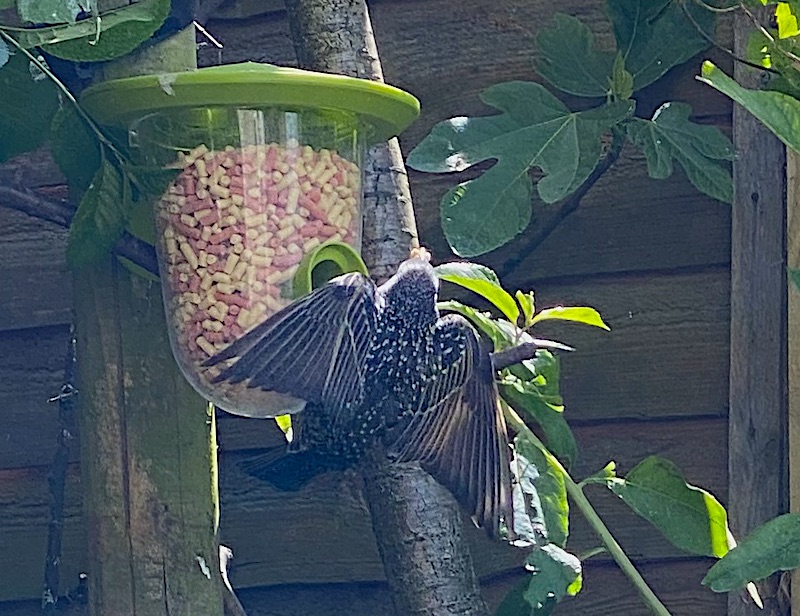
Its as well we are in lockdown and can’t get out and about because its a full-time job filling the feeders and then washing down the yard before the guano becomes knee deep!
Talking of lockdown my son (an essential worker) not only gets to see birds when he cycles to work, but gets up at silly-o’clock on his days off to get his essential input of nature. Sorry for me, and worried for my mental well-being while we are ‘sheildling’, he’s taken to sending me pictures of the birds I’m missing.
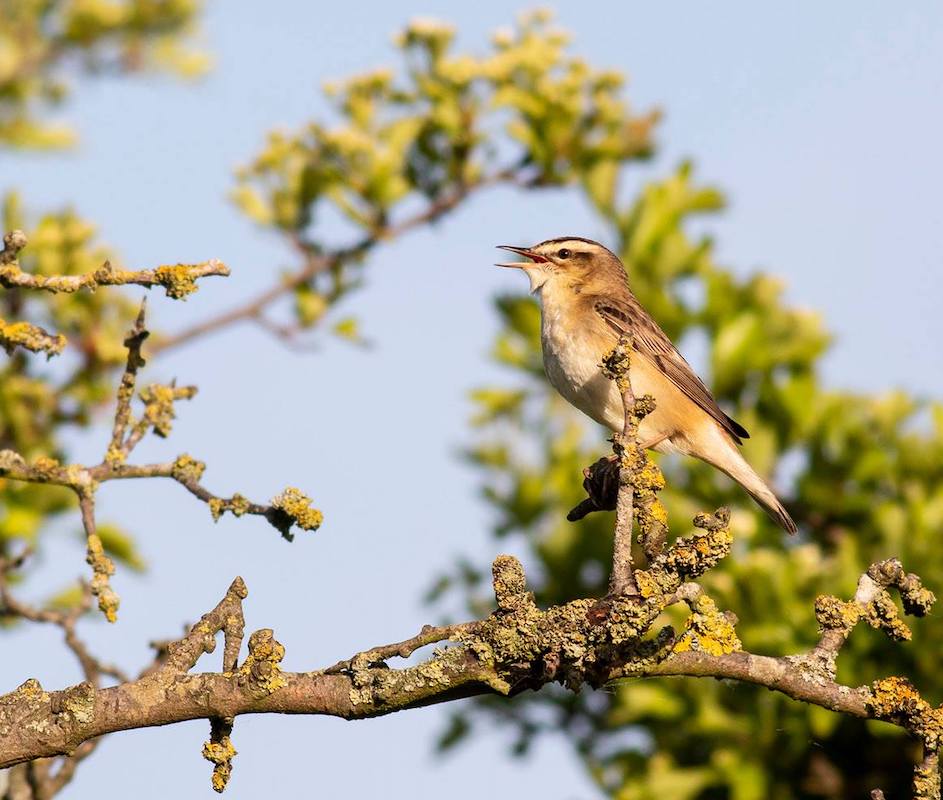
Singing Sedge Warbler Acrocephalus schoenobaenus ©Ashley Crombet-Beolens
At least, that’s what he tells me… I refuse to believe anything else, as I was never a devotee of ‘gripping off’ my mates back in my twitching days. I’m sure he could never be that cruel!
Slug Killers
(17-05-20)
When we moved here twenty years ago our concrete garden had one feature… a small pond with a broken pump. It held four fish. In time, we turned the patch green and enlarged the pond for more wildlife interest. By then, two fish had died and we had bought a couple more. At this point we decided we would keep the fish, but not replace any that died as the pond was more for wild critters. Not long after we finished the re-build the fish spawned and around a dozen goldfish survived to maturity. Natural loss has accounted for more and we now have just seven fish, one of which is the original we inherited, so must be well over twenty years old!
About a decade ago a birding friend allowed me to take some frogspawn from his garden pond… ever since we have had a garden full of natural slug killers! They are a delight to see… with a great variety of ages, sizes and colour morphs.
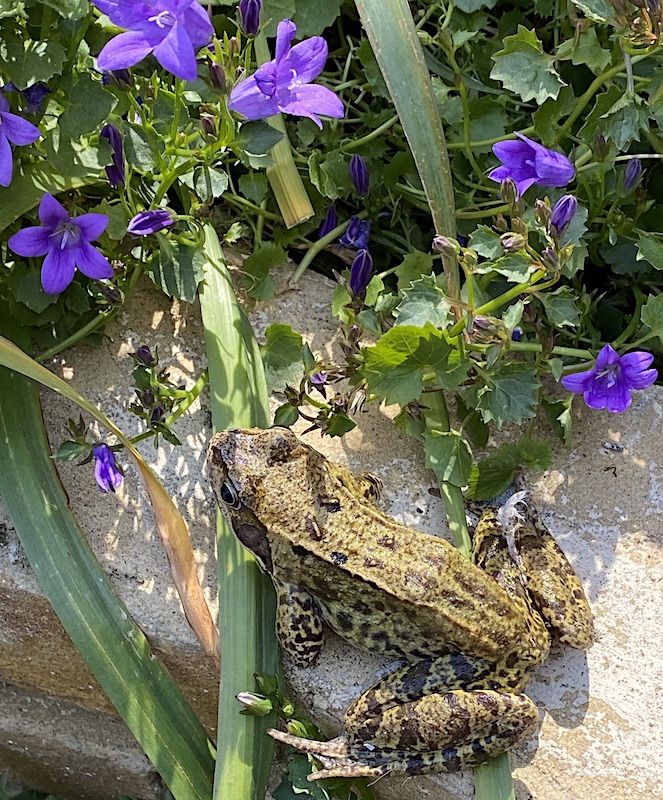
Yesterday, grandad appeared in all his glory!
I recon the next guy is a couple of years old as there are a lot of frogs about half this size, which I think are last years crop. When I potter about tidying up and moving pots etc., I often come across frogs… one afternoon I saw eight different individuals, in an area no bigger than the bathroom. There are clearly plenty of slugs to feast on.
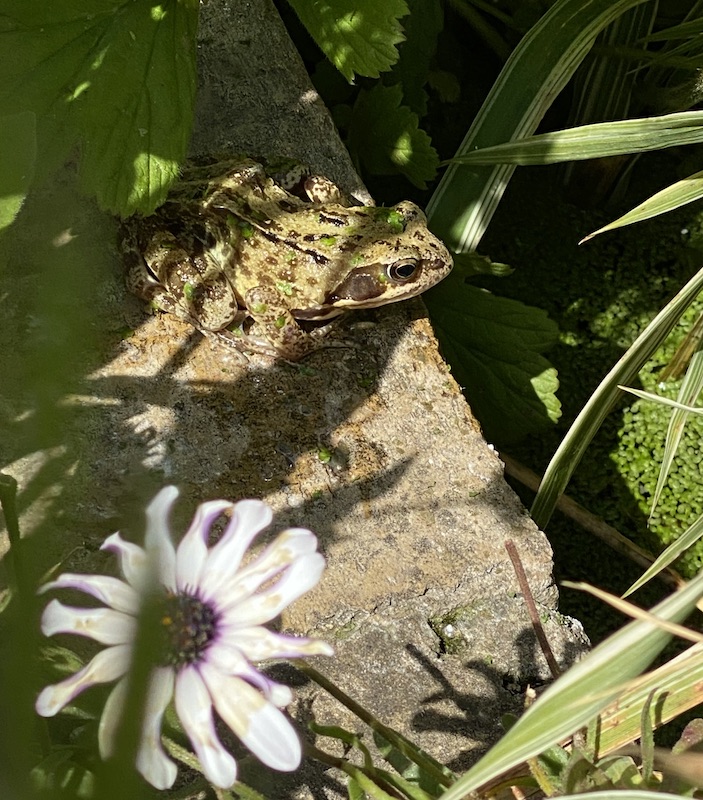
Mind you, some lilly-pad hoppers just think they are frogs!
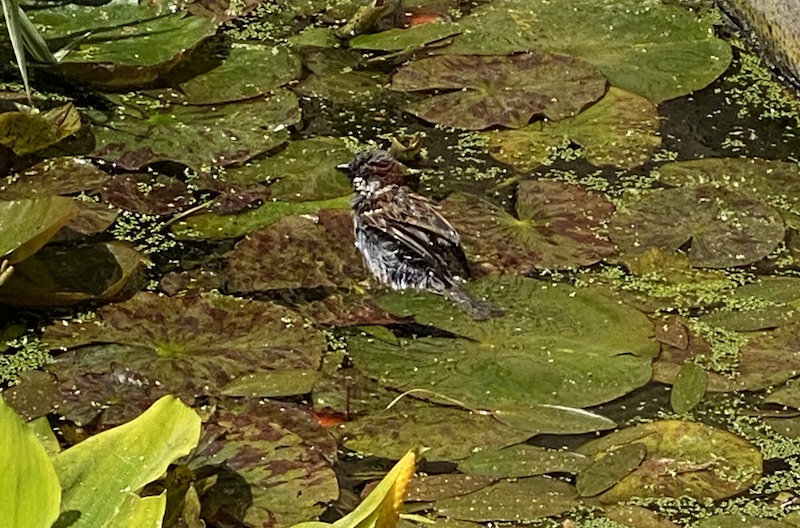
Look closely and you can see a couple of goldfish hiding in the weeds.
It was a frog-filled day… this chap was as far from the pond as you can get on the drain by our kitchen window. I was watering the plants when hew caught my eye and enjoy the artificial shower.
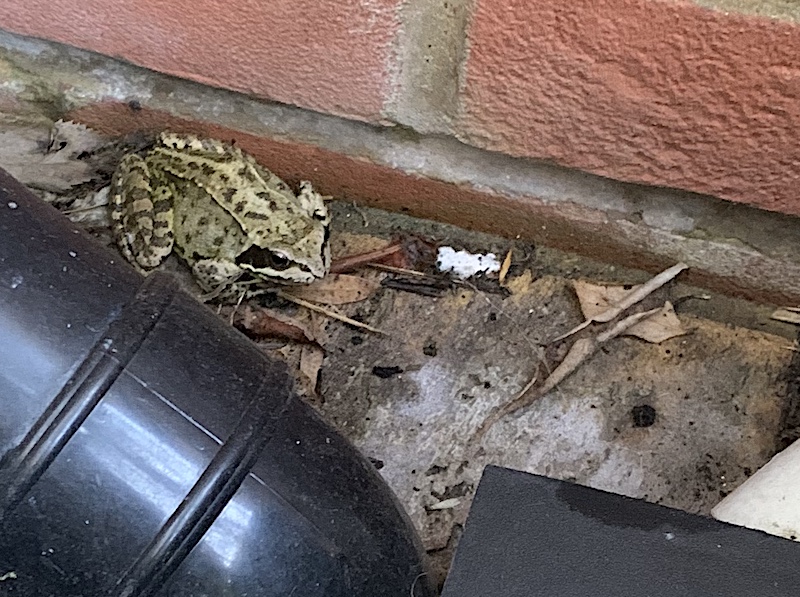
What’s in a name…
(16.05.20)
To finish the quote: “…that which we call a rose, by any other name would smell as sweet.” Call it a wildflower or call it a weed, there are a number in my garden that I treat with as much tenderness as any cultivar.
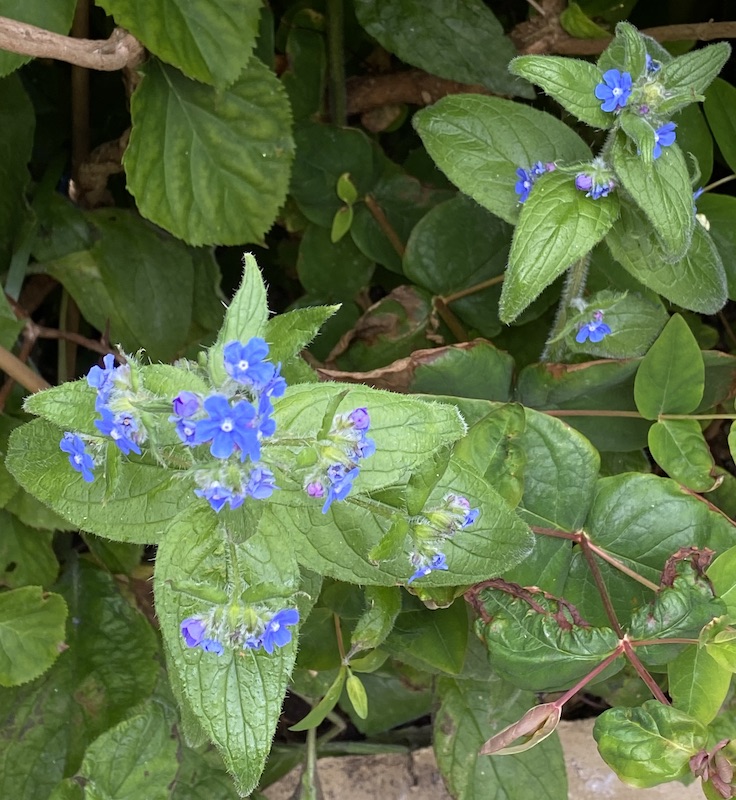
Green Alkanet Pentaglottis sempervirens
The Green Alkanet Pentaglottis sempervirens has pretty blue flowers from April to June (in my garden that’s actually practically all year). However, it soon becomes a weed, especially in my damp shady garden. I’ve been calling it ‘Borage’ for ages and it is a member of that family as is forget-me-not, which this can also be called. It seeds and spreads easily and also regenerates from its tap root, so once you have it, it’s a devil to eliminate. But, as it is very attractive to bees, I allow them to flourish here and there, removing them only where they encroach too much on other plants.
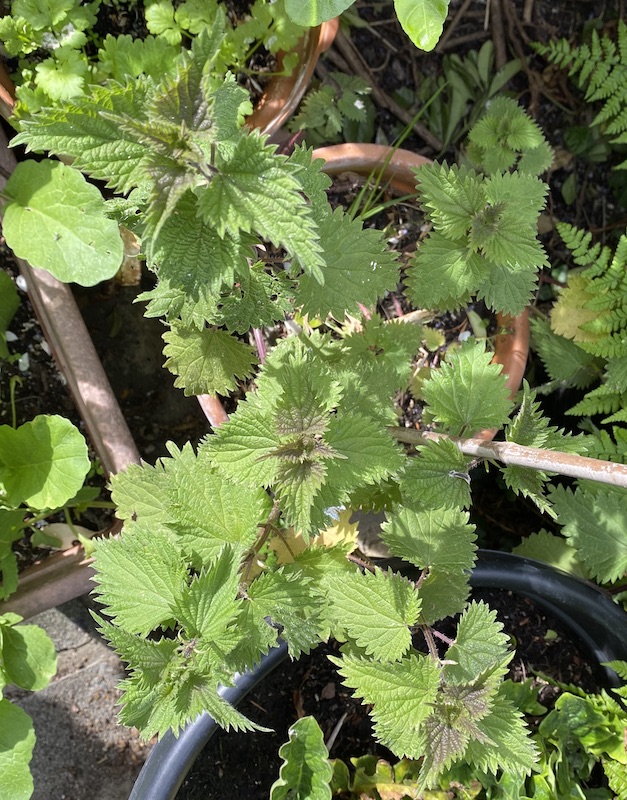
Stinging Nettle Urtica dioica
I don’t just allow nettles, I’ve actually imported some and potted them up. You should have seen the look last year, on the face of the nursery owner when I asked if we could dig up a stinging nettle – a mixture of delight and consternation! Nettles are the preferred caterpillar feed plant for a number of butterflies; we hope some lay their eggs in our garden this year.
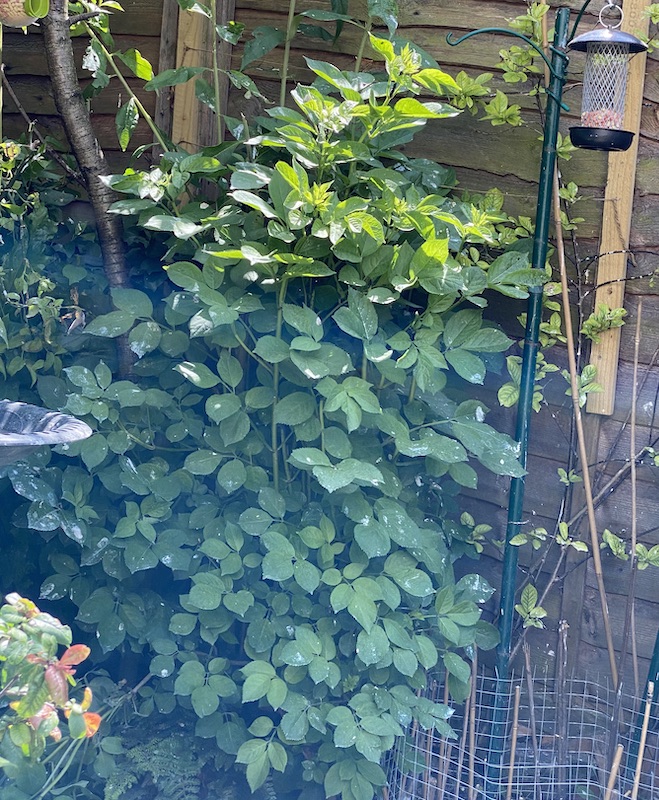
Elderberry Sambucus nigra
I have several elderberry bushes growing in my garden including one I’ve since potted up. One can, of course, grow them for their flowers and berries both of which make tasty wines, but mine are left by the birds and for them too.
You can see exactly how this comes about above. It’s beneath our feeders because that’s where birds leave the majority of their droppings! See the ‘lime’ streaked down its leaves. This was probably deposited by one of the three pigeon species that regularly partake of our offering. When it matures the berries will attract more pigeons… but you never know, maybe one autumn a passing Blackcap, Lesser Whitethroat or other warbler will feed up on its way back to Africa.
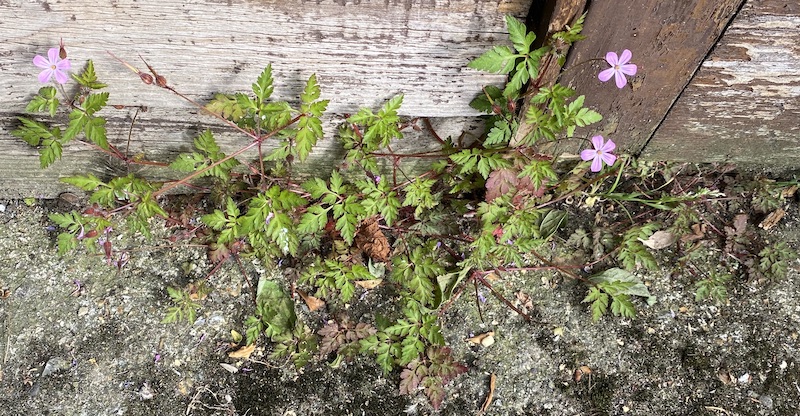
Herb-robert Geranium robertianum aka Stinking Bob
Not all are welcome ‘though. This pernicious little weed gets everywhere and can take over. The flower is pretty but tiny and although part of the Crane’s Bill (geranium) family it has far bigger and brighter relatives. And to return to where I started perhaps I should answer ‘what’s in a name’ with well… Stinking Bob!
Tell your mother I saved your life!
(15.05.20)
I remember, sixty something years ago it was common practice amongst my school-friends to take hold of someone’s shoulders as they were about to go down a flight of stairs, or step into a road and jerk them back saying “…tell your mum I saved your life.” I guess todays equivalent would be to do the same action saying “You’re welcome!”
Keep that in mind.
Of course I have favourite birds and, at the other end of the scale a few I am less fond of, but I do not condemn any for doing what comes naturally. I might rail against cats in my backyard but they shouldn’t even be in this country let alone killing my visitors. People defend them as natural predators. Natural they may act, but they are not native and there is an overwhelming density of them – if only they were all loved indoors not attacking wildlife.
There are a couple of Magpies I hear a lot, but see less. They usually sit on the roof of a neighbour’s house. Look closely and they are beautiful creatures. Indeed, I admire them enough to have asked an artist I know to paint that scene for me.
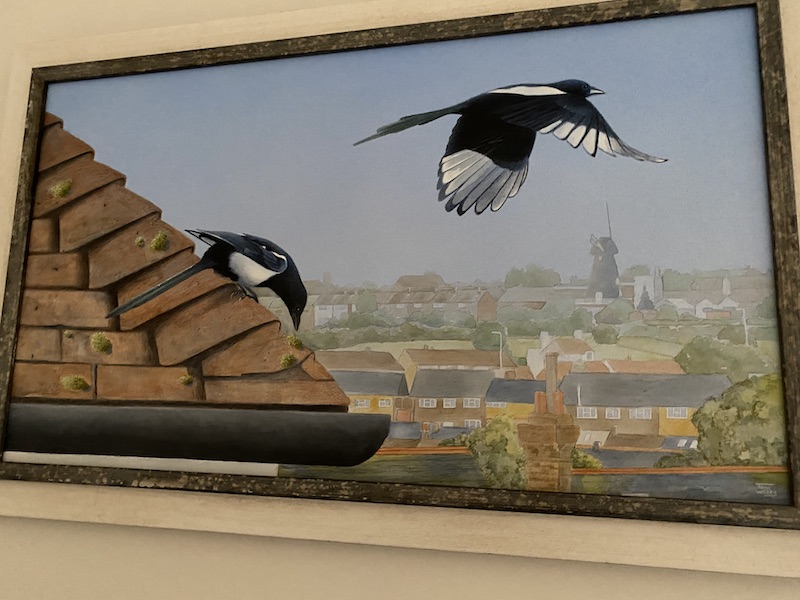
Today Maggie and I took a break from washing bird lime off our planters and sat in the sun. As is often the case now, if we sit chatting quietly with no expansive movements the birds feel secure enough to drink from the pond or pick over pots close to us.
What was new today was that fledgeling sparrows were chirruping in pots and on the pond wall attended by dutiful parents bringing them a few morsels.
As we enjoyed their company a Magpie suddenly descended from my other neighbour’s roof scattering the sparrows all around. The fledgeling it was after weakly flew straight at me and hid under my chair. The Magpie was not sufficiently secure to come too close to us. Back on the neighbour’s roof it protested loudly before flying away. I turned to see the youngster disappear into the bushes so I said… “Tell your mother I saved your life.”
Talking of guardian angels (well, I sort of was…) I snapped this Ring-necked Parakeet pose the other day quite accidentally.
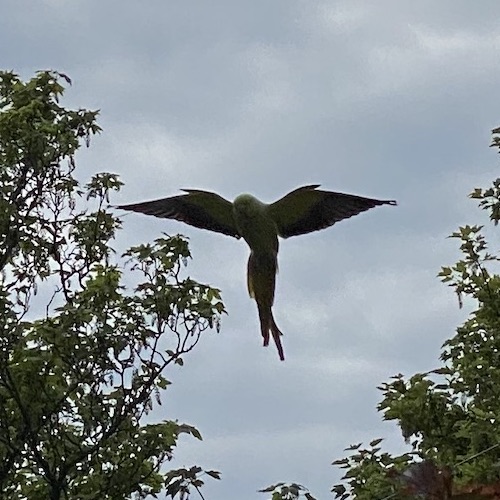
Re-modeling
(14.05.2020)
A garden is rarely a static space, constant re-modelling happens not because us gardeners are fickle but because we learn. It’s often a matter of trial and error… a plant left in the full sun frequently wilts so needs to be moved into the shade, a tender plant doesn’t survive winter or just comes to the end of its natural cycle. Given that bedding plants differ year to year, new or popular varieties are always changing the gardener’s choices.
It’s also a matter of choice too as a neglected corner becomes a new focus or some practical change such as garden furniture deteriorating calls for a replanting, move around or makeover. Remodelling renews interest and energy too.
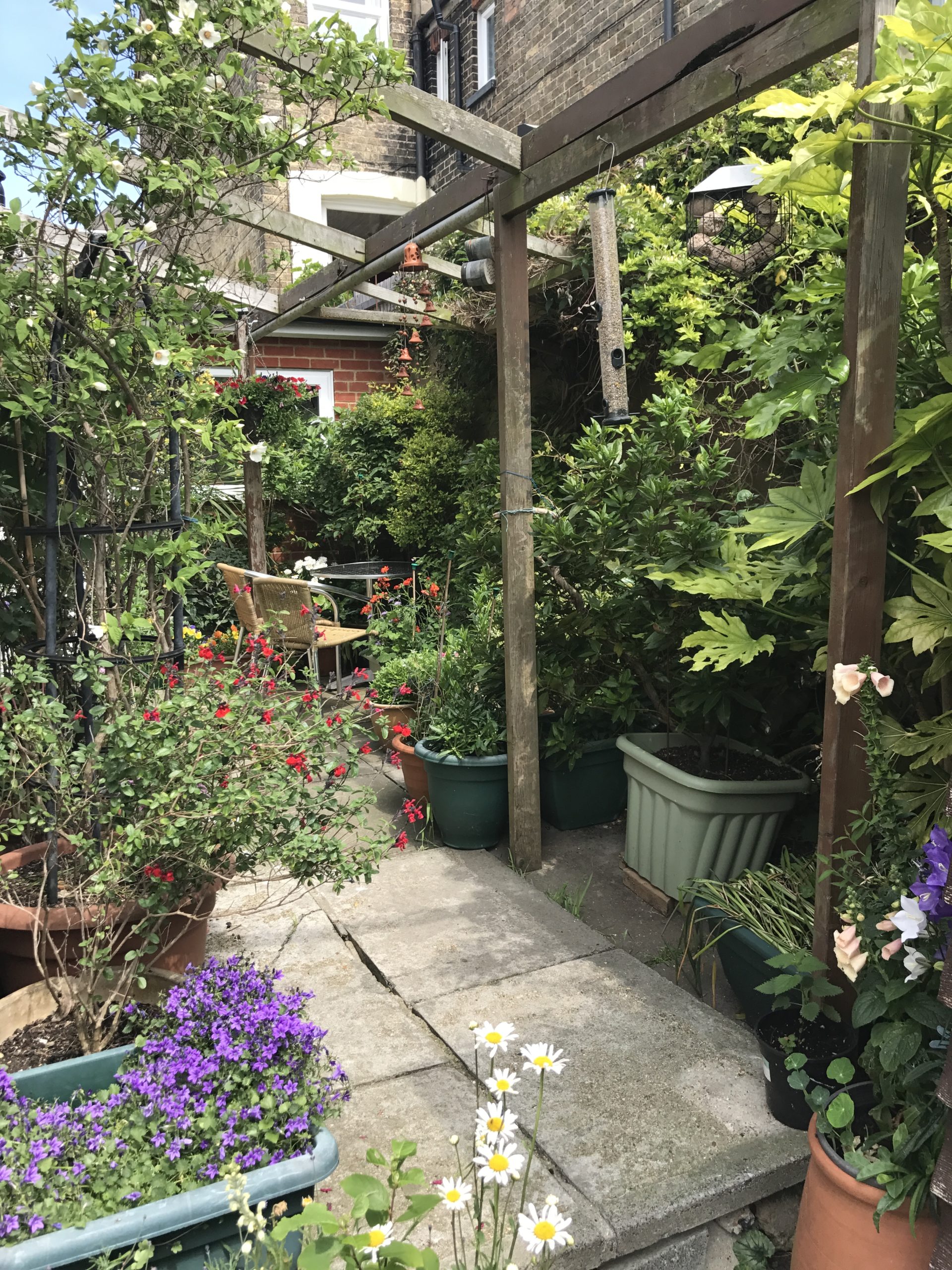
July 2018
Today it was the turn of the view from our Kitchen. A narrow strip along side the house, not wide enough for social distancing, bounded by a high wall makes for a difficult patch. Often in deep shade and partly in the rain shadow created by the house it can be bone dry one side and sodden the other, one side can be stiflingly hot and the other chilly!
Having put plant pots on our picnic table the metal covering came adrift as water had seeped beneath swelling and distorting the underlying strawboard. Now it is assigned to a new spot where supporting planters is its only duty.
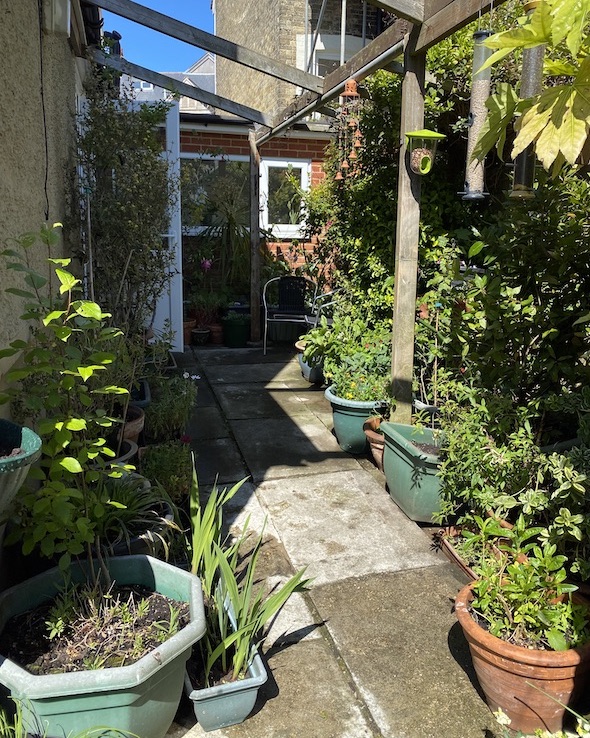
May 2020
Its too early to judge the changes from July 2018…
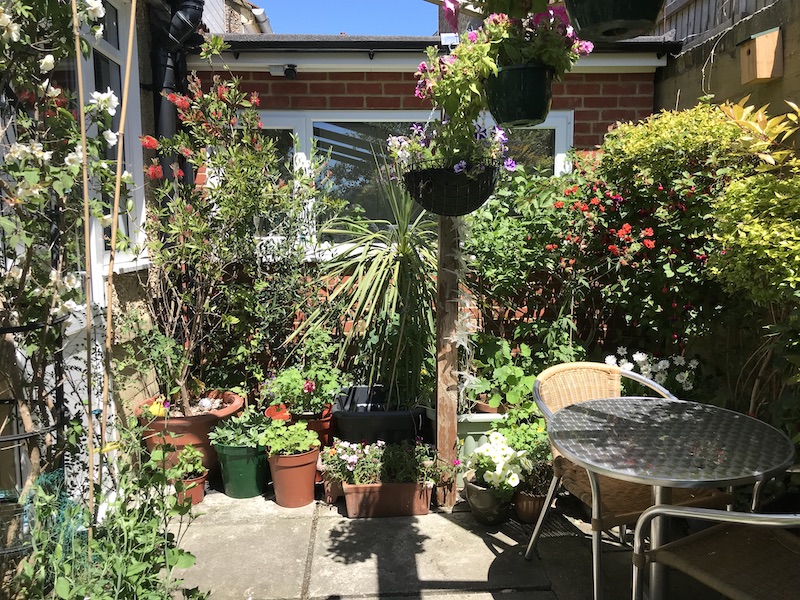
To May 2020… give it a couple of months!
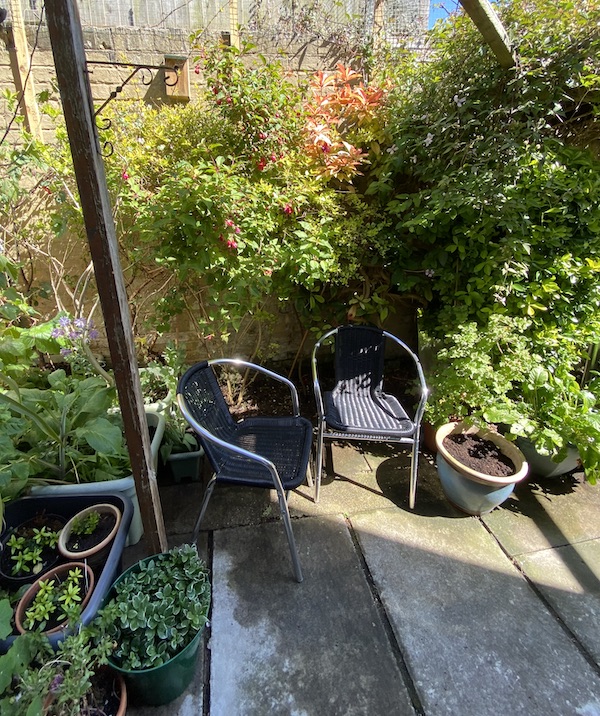 This year’s added frustration is that for those of us ‘shielding’ on line plant sellers are the only option and orders are so backed up that deliveries are at least a month after ordering!
This year’s added frustration is that for those of us ‘shielding’ on line plant sellers are the only option and orders are so backed up that deliveries are at least a month after ordering!
Top of the pops
(13.05.20)
Nightingales are wonderfully expansive in their song, Garden Warblers and Song Thrushes have their own attractive phrases and the soulful robin is hard to beat. However, there are millions of us whose spirits are lifted by Blackbird song.
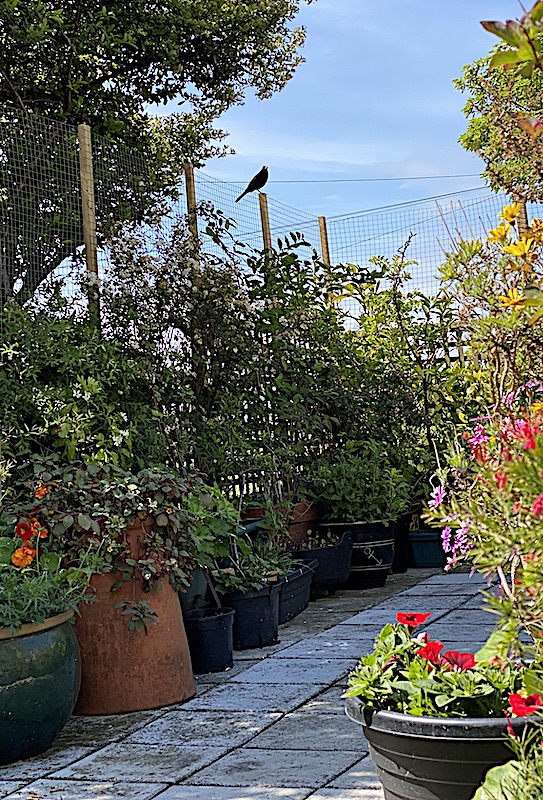
Our Songster
Throughout two months of lockdown a Blackbird has sung to us from early morning until darkness has fallen. It is mellow but not melancholy, tuneful without frills and trills and hardly changes. I smile every time he sings.
As Maggie pointed out he is ducking his responsibilities, out on the tiles (literally) singing away his rivals while, no doubt his missus is tending to the housework and looking after the kids.
Nevertheless, she forgives the chauvinist all as the most uplifting troubadour that he is.
Several males and females do pop into the garden to snatch up mealworms in Summer and raisins in Winter but during Spring the visits are rare and super fast as he must get back to his song-post.
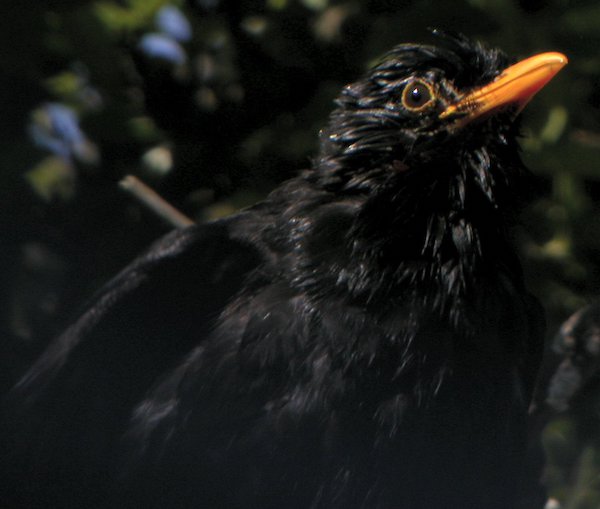
Later he will take time out for a wash and pick over the pavers for more food but right now territory is everything to him.
Todays spring winds have brought a new chill arriving just as some plant plugs were delivered and we had to retrieve our mini greenhouse from the garage to protect the newly planted petunias and daisies while they establish themselves.
Most insects were hunkering down or being blown around with few photo opportunities. One brave Small White butterfly landed long enough for a quick snap.
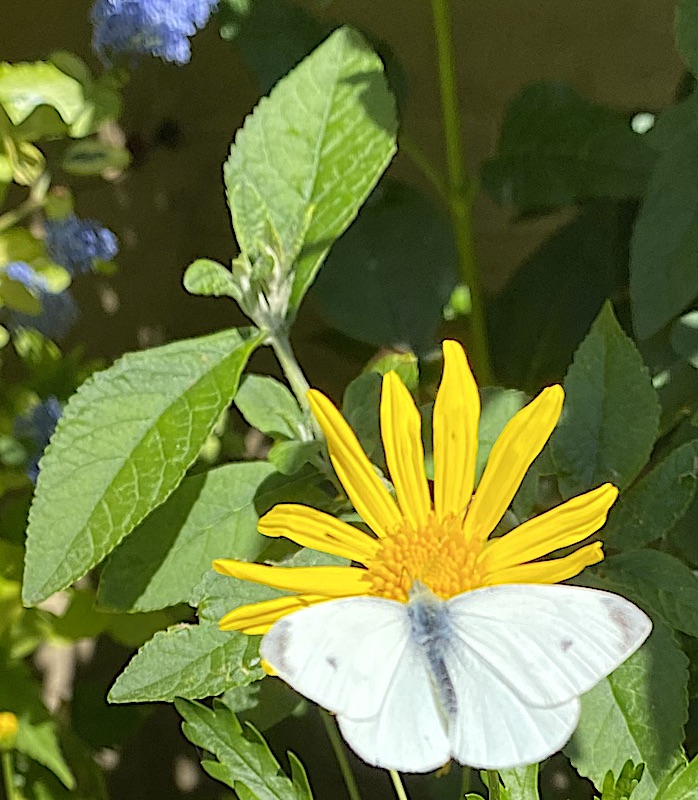
The Orangery
(12.05.20)
When I was seven my favourite colour was red, ever since I’ve not much cared for that colour. Oddly, if you paw over seed catalogues and garden centre websites there is a definite preponderance of red flowers. Maybe it comes from the long love of the English for roses and one cannot deny their charms regardless of colour… if I cast deep into my mind’s eye I can recall the smell of the deep red roses in my grandmother’s garden.
Notwithstanding this memory I have allowed few red flowers to bloom here. Instead our main colour scheme has been blue… from the palest flax to the deepest mauve. We have deliberately splashed yellow about too as that seems to compliment our blue palette. Here and there we have also encouraged orange for the same reason.
However, with no seasonal plan it appears that most of the early blooms in our garden are of the contrast colour, with the main theme not coming into its own for another month.
So below is the current bloom crop gracing out pots and borders.
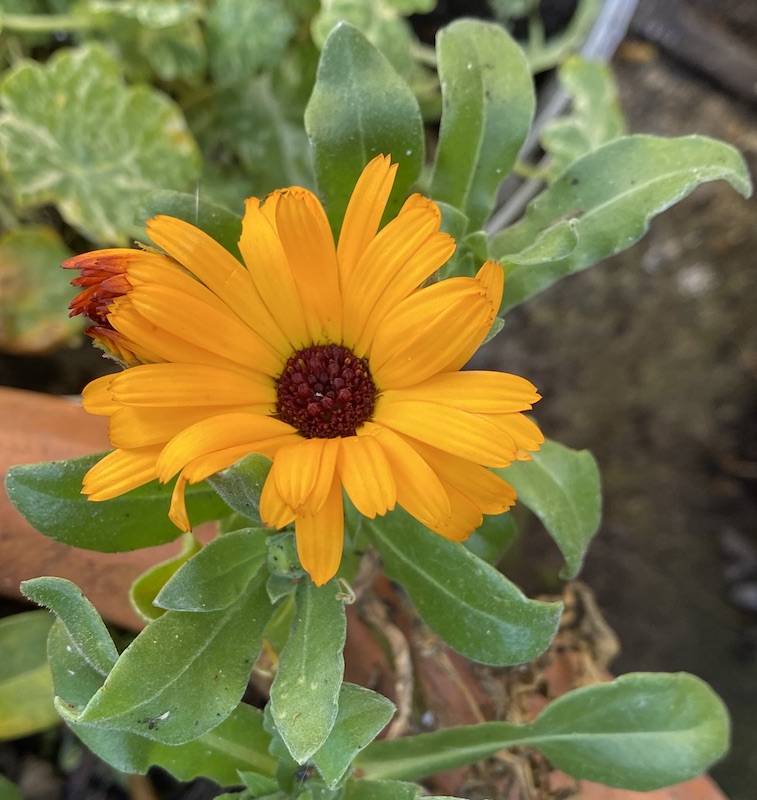
Cultivated Calendula’s were developed from the wild field marigold Calendula arvensis
Gran ran a small holding all her long working life (grandad was disabled in WW1). She grew veg commercially and to feed her family but the main cash crop was flowers. On our visits sixty years ago we would spend entire summers running in the local fields or helping Gran with the chores such as tying bunches of flowers with raffia ready for the ‘flower girls’. These women would turn up with huge, wide shallow baskets that would be filled with sweet peas and gypsophila, calendulas and asters taken back into Brighton for the rich folk to buy. Gran had her own way of pronouncing the names read from seed packets but never heard… so she sold ‘gyp’ and cal-en-doolahs’.
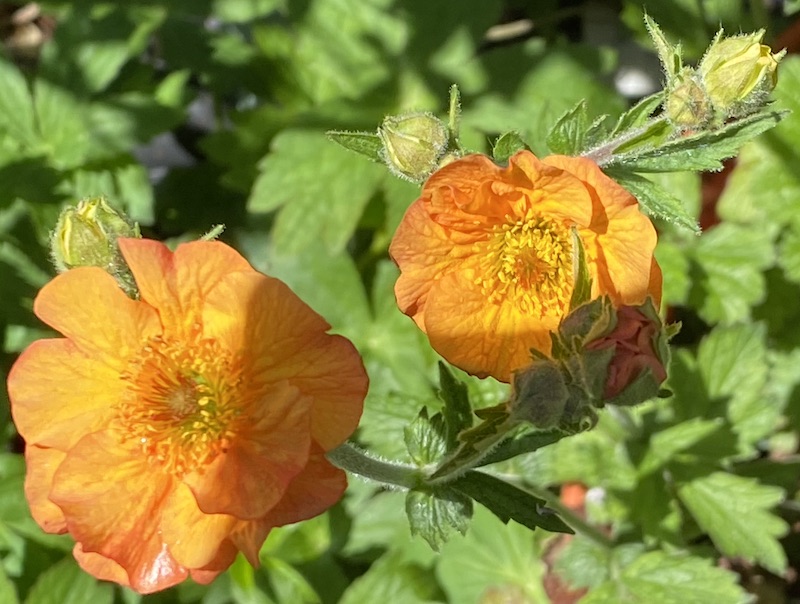
Geums – another of Gran’s bounty
Nasturtiums were scattered around Gran’s borders but they are no use as cut flowers. Never one to grow for show Gran used the flowers and leaves in salad and pickled the seeds as her home-grown capers.
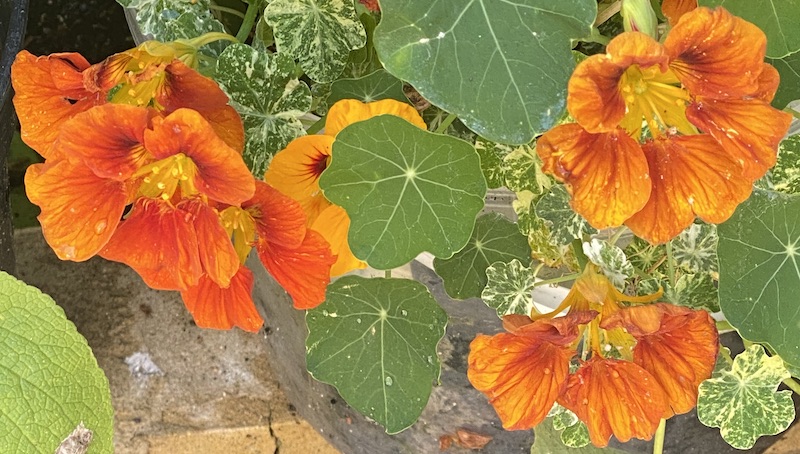
Delicious Nasturtiums cultivated from Tropaeolum majus
I’m not sure that Gran had known of Californian Poppies… a wildflower in the drier southwestern states of the US cultivated now to give a mass of flowers all summer long. With our mild climate they sometimes last more than a year and readily self sow when their seed pods dry in the sun to twist and burst a shower of seeds around.
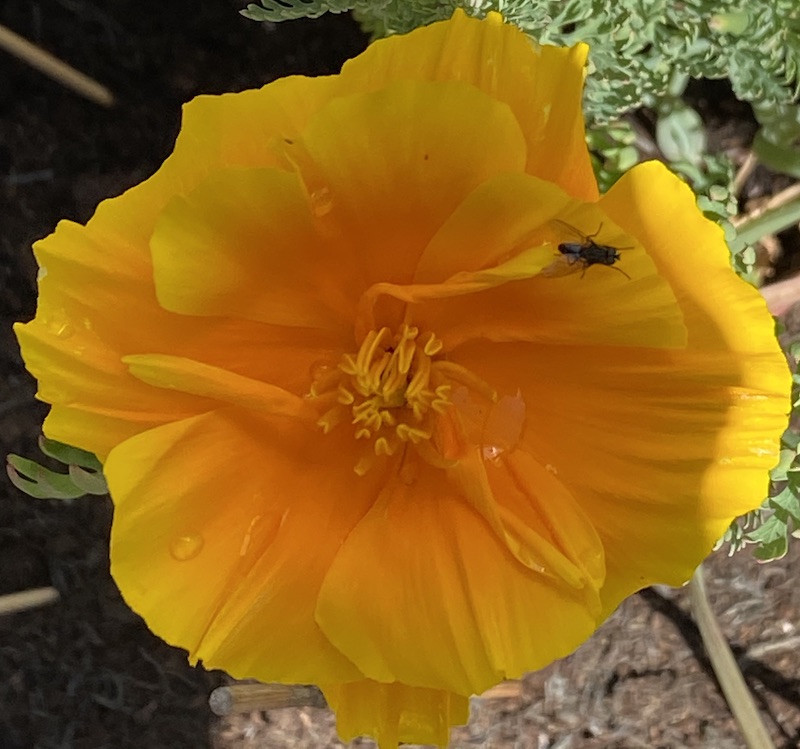
Californian poppies Eschscholzia californica, as popular with bees and flies as with us
Uninvited guests
(11.05.20)
Having a totally enclosed urban garden its not surprising that we have only had four native mammals popping in over the two decades we have lived here.
House mice live in our shed and sometimes venture out into the garden. Field mice have put in an occasional appearance too.
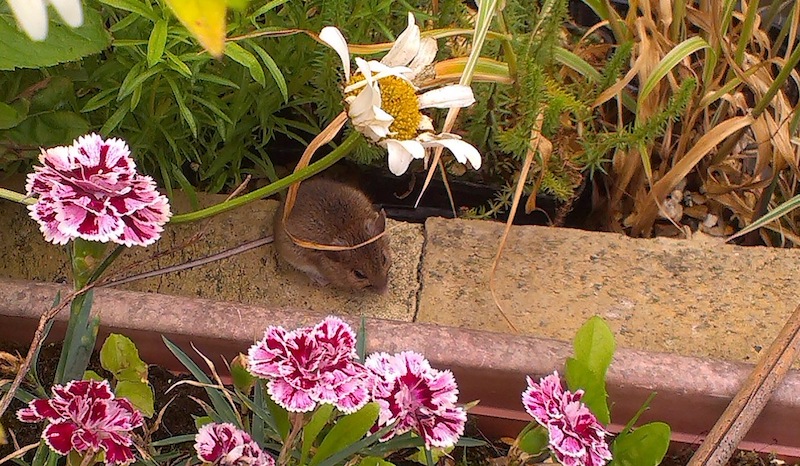
Field or Wood Mouse Apodemus sylvaticus on the pond wall 2015
Before we raised the fences in an unsuccessful attempt to keep the neighbourhood cats at bay, we had a fox coming in to eat the bird food and mooch about for other tidbits. He was a rather mangy critter so we sought advice and found a website where you could register for free mange medicine which we arranged. We then put out the medicine in some jam sandwiches (we were not mad but following advice) which the fox duly ate… it cured his mange!
Now we get almost daily visits from the scourge of bird feeders everywhere… grey squirrels. (Plural only because we just once saw two together, but who knows how many different individuals drop by).
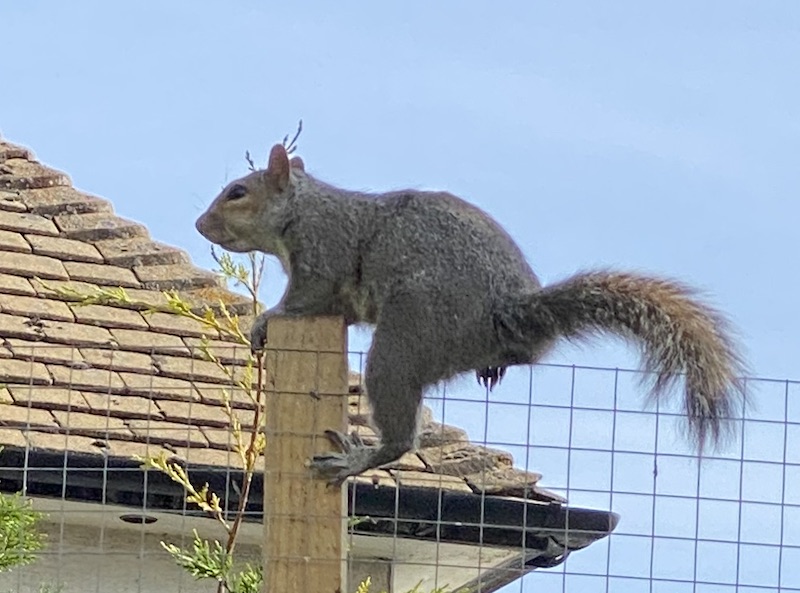
Sciurus carolinensis on a ‘mission impossible’!
I know they come from the local park which we can see a few hundred yards from our garden. They use the telephone wires to cross the roads in between and navigate back and forth via fences and trees.
I am old enough to remember when there were still native red squirrels this far south. I’ve always thought of the interloper greys as tree rats (perhaps I should spell that ‘grays’ seeing that they are American mammals not natives.)
Yes the are furry and cuddly and can entertain but they are also carriers of disease and robbers of nests as well as purloiners of my bird feed.
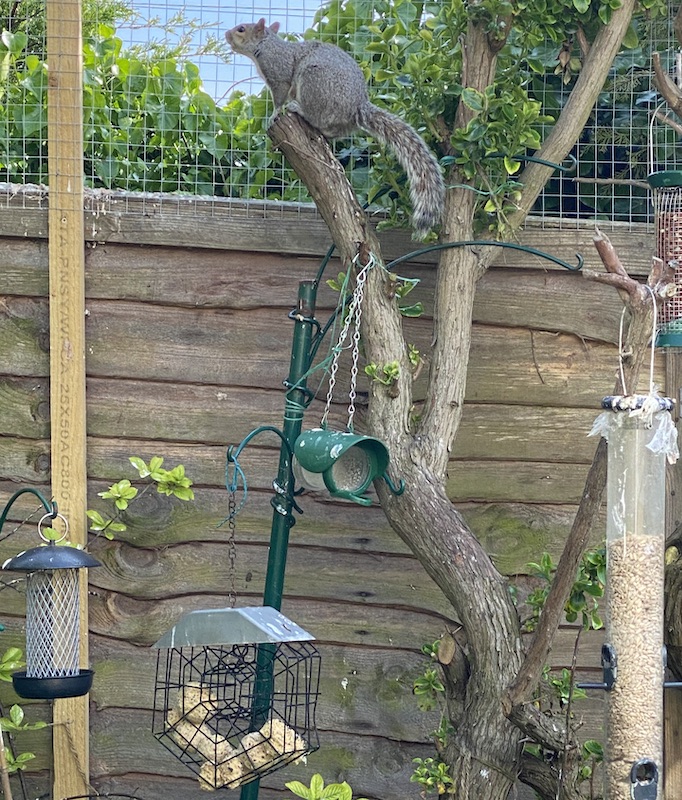
Even cling-film on feeder tops doesn’t stop the daily ‘deposits’ – we clean them off every night, and they go on making deposits all day long!
If I ruled the world I would advance an eradication policy. Perhaps it would be impossible to achieve but if numbers were radically reduced bird populations would grow in some places and if we started where reds still have a foothold perhaps we could increase their range and numbers.
You’re not the boss of me!
(10.05.20)
Let’s get this straight mister, you are not the boss of me! We are in a relationship. OK?
Yes, I know my part is to feed you while you provide the entertainment, its worked for the last two decades so there is no need to change now.
Granted that as we age we do get a bit grumpier, more likely to fly off the handle, but does the constant nagging have to be part of it?
This was my internal dialogue this morning as I was pottering about in the shed reacting to the drop in temperature… today is forecast to be half the temperature it was yesterday! As I moved things about, filled planters with compost and generally tidied up there was a constant racket from outside. Three Ring-necked Parakeets were demanding my attention, one sat ready on the washing line, another overhead on telephone wires and the third on the peak of the gable end of our house. Non-stop squawking seemed just to increase in volume until I dropped what I was doing and hung up a couple of apples. The pictures below tell the story (all taken within six feet of the birds yesterday almost into the full sun).
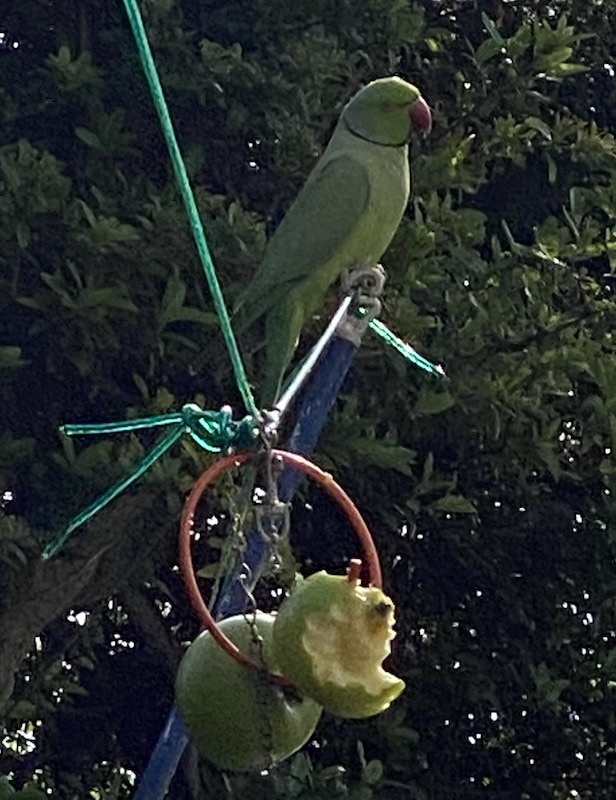
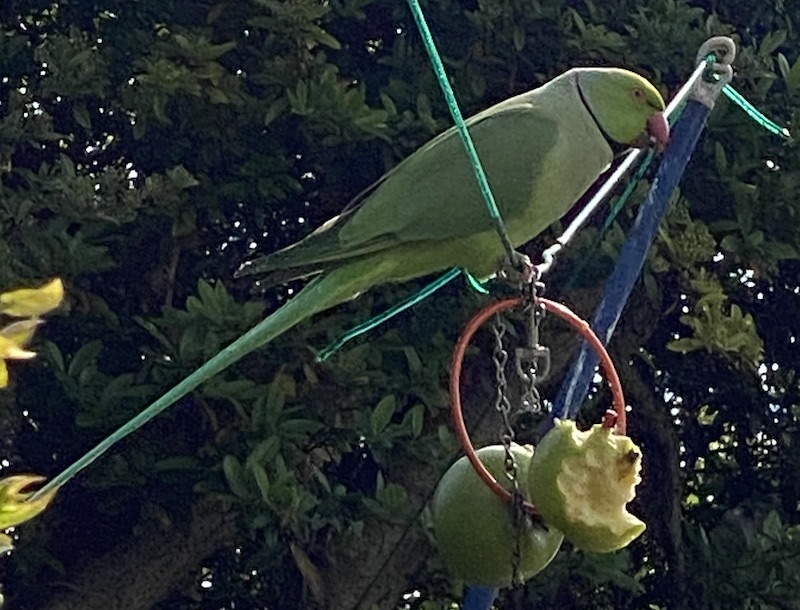
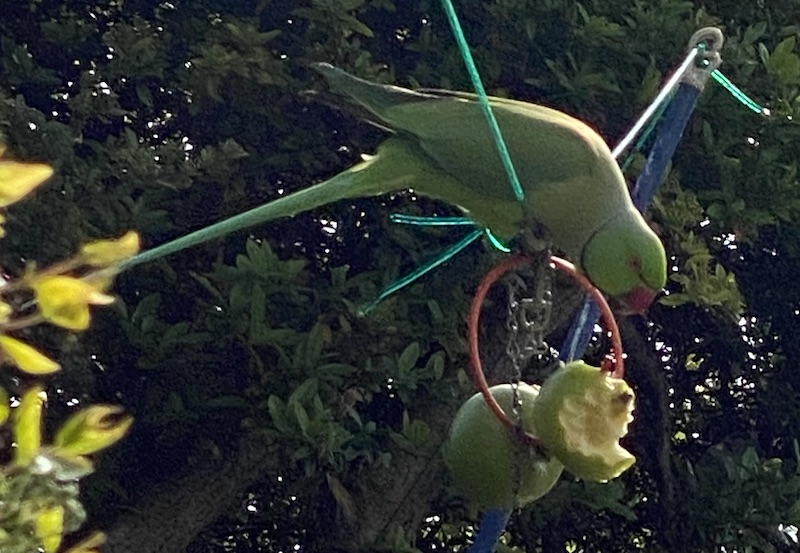
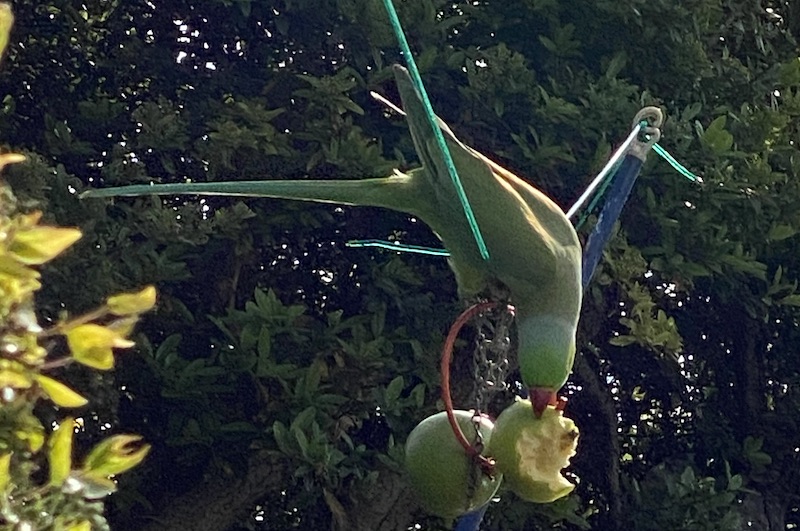
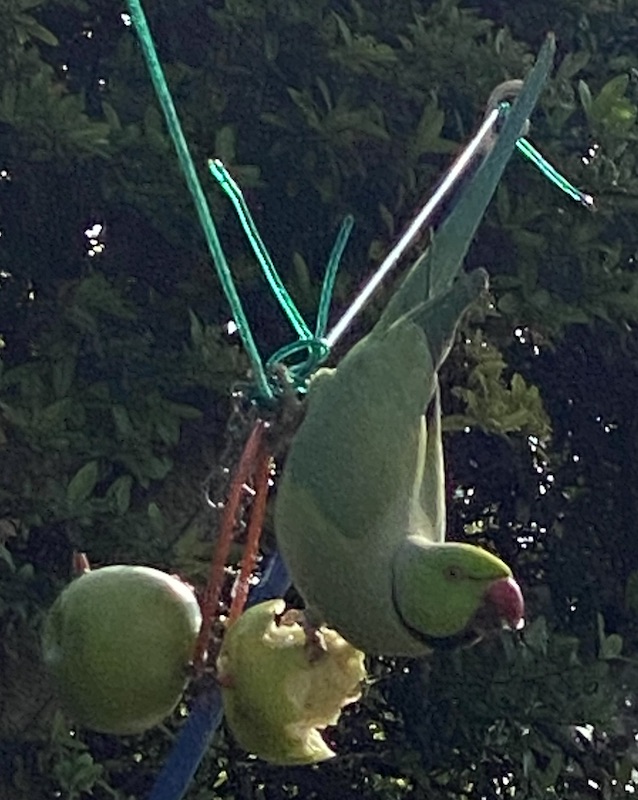
Perhaps I should have called this Parrot Power!
They always leave us having to clean up behind them… below the apples the pavers are always covered in apple-peel. Who knew that parrots peel each mouthful rejecting the peel and eating the pulp. It’s neatly done but untidily left for us to sweep away.
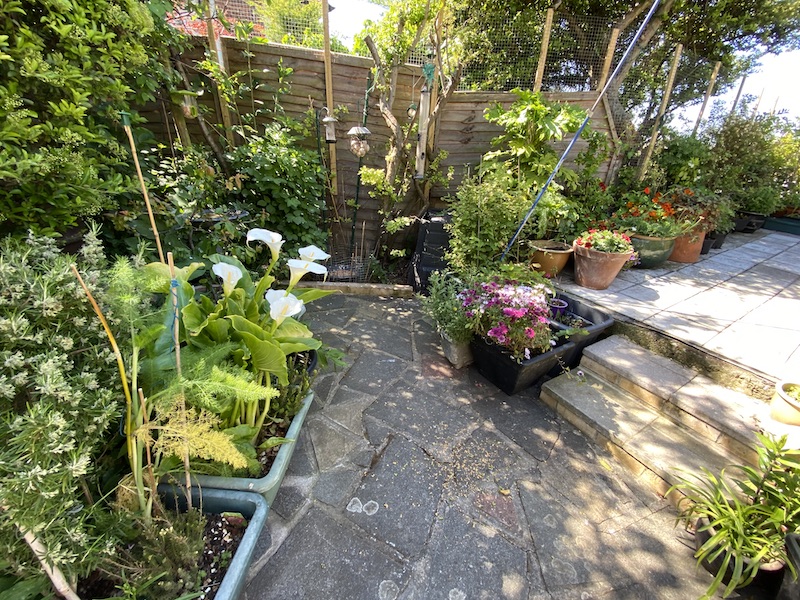
Day’s End
(09.05.20)
Its not quite a summers’ evening and its not yet fully planted, let alone mature and blooming, but a tidying hand, burgeoning growth, breaking colour and soft light is making the garden feel like a garden and the blackbird singing from the visible telephone pole makes it a calm place of solace.
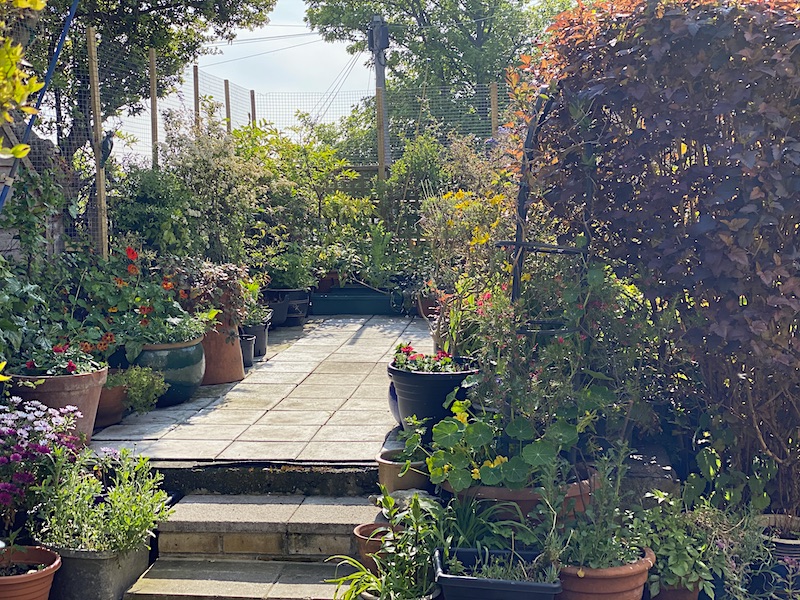
Somewhere to sit and ponder. It’s oddly true that I think differently in the garden. Staring into the sky is not idling but meditating; drinking in the flowers is not wandering but appreciating. Somewhere to sit and feel, being relaxed and tranquil is the antidote to collective fear in the time of plague.
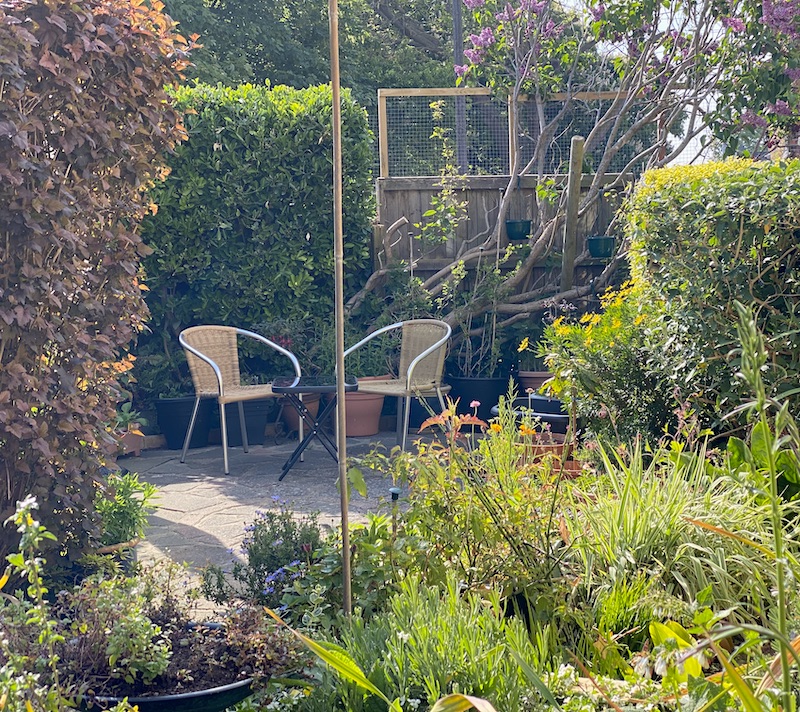
Hottest day of the year so far…
(09.05.20)
As the heat was forecast and the garden looked pretty dry last night I decided to water as soon as I arose when the sun had only entered one corner of our yard.

Hoverfly sunning itself on a leaf of our variegated ceanothus
A few insects were up early including this Dead Head Fly (Myathropa florea) that gets its name from the marking on its thorax, which are said to resemble a human death mask.
Dull days are not dull days…
(08.05.20)
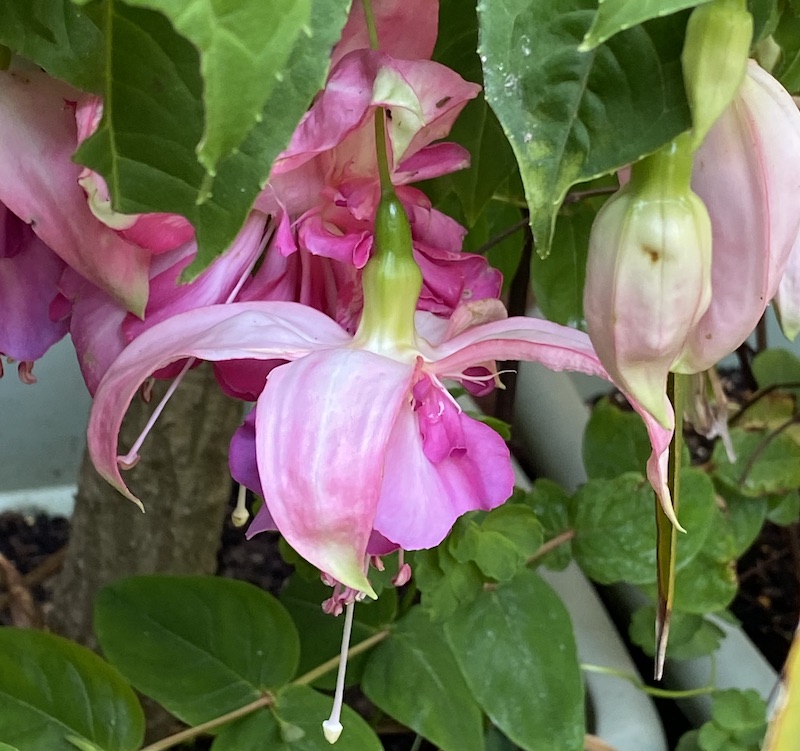
Flashy, fleshy fuchsia
It dawned wide blue skies, morphed into fluffy clouds, but then descended into all over dull. A breeze followed, but the heat remained in place. My pre-breakfast wanders are usually unheralded by song or accompanied by busy insects. It’s just a tranquil time to appreciate colour and growth. The pond is quiet except for the bubbling aerator and its not too hot to pull a few weeds and potter around always finding something to tweak.
A pot moved, a plant re-potted is the daily diet with a side order of seedling checking and marvelling at the latest bloom to escape its winter lockdown for the new season where it can shimmer its bright skirts.
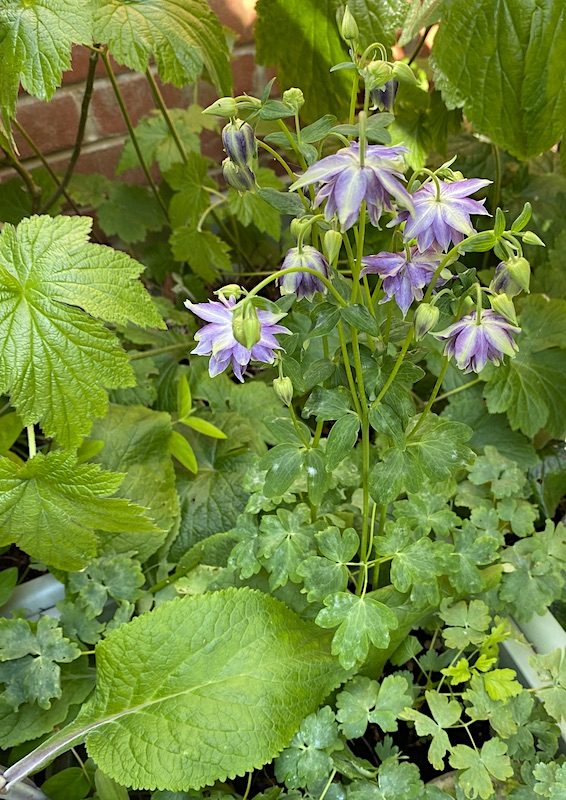
Aquilegia commonly called ‘grandma’s bonnets’
…when the day is brightened by your family
Ash (my son) is an increasingly accomplished photographer and fellow lover of nature. He brightened my day when he sent the two photos of common terns he took on his early morning walk. Not wanting to be among too many people even before lockdown he prefers to get out while most people sleep as it is also the time when nature feels free to be itself away from the dangers man represents.
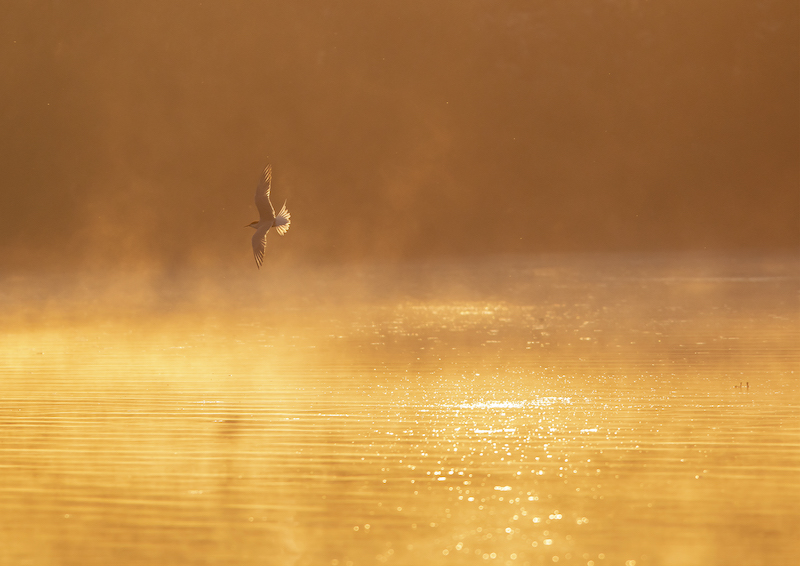
Dawn light can be even more stunning than sunsets ©Ashley Crombet-Beolens
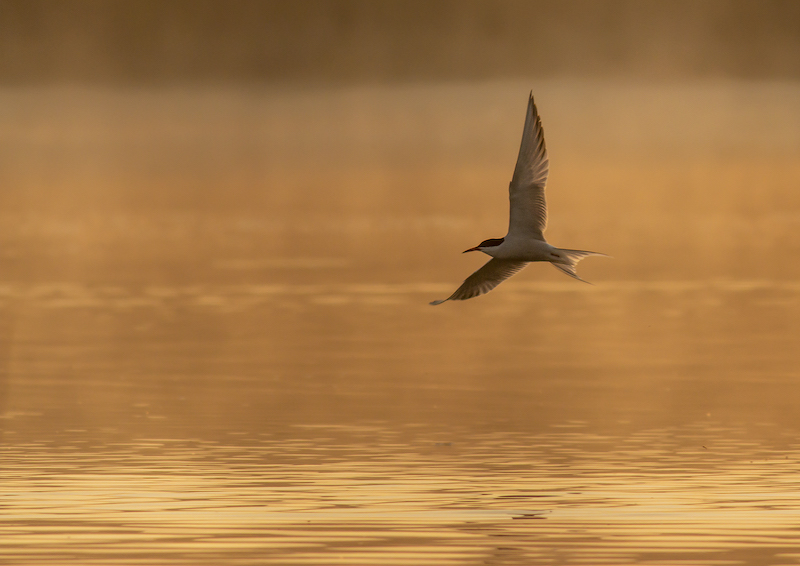
©Ashley Crombet-Beolens
If you are as impressed or moved as I am by his pictures there are plenty more on his website Urban Lake Photography.
…or when they are full of drama
A daddy-long-legs spider hauling in his catch, a hapless bee. I admit I thought this was a harvestman (an arachnid but not a spider). They have an unsegmented body, don’t make webs and have no venom. Not to be confused with what I grew up calling a daddy-long-legs – the cranefly.
Like many afternoons the sun returned and the sky was clear blue. An insectless patch also morphed with butterflies, bees and flies.
The sun brought out the bright yellow flowers of the Californian Flannelbush (beware the irritating stem hairs) that grows through the ceanothus affording wonderful colour contrast.
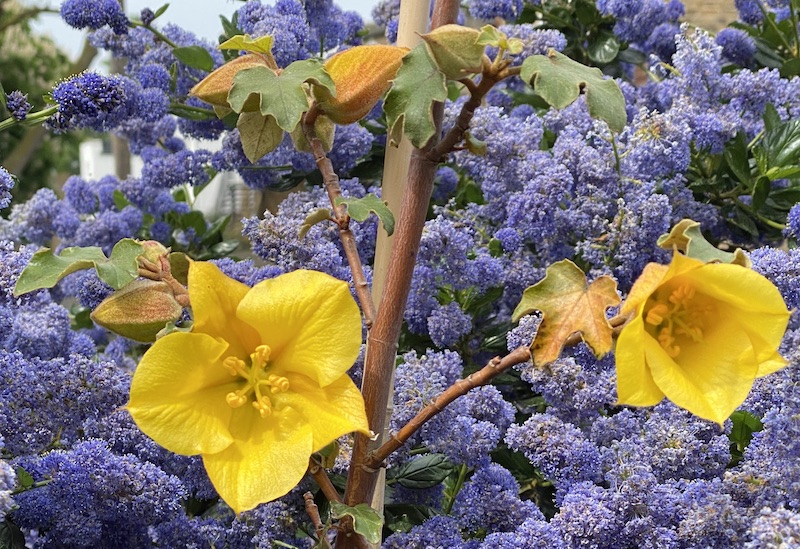
Fremontodendron californicum
Almost an outing…
(07.05.20)
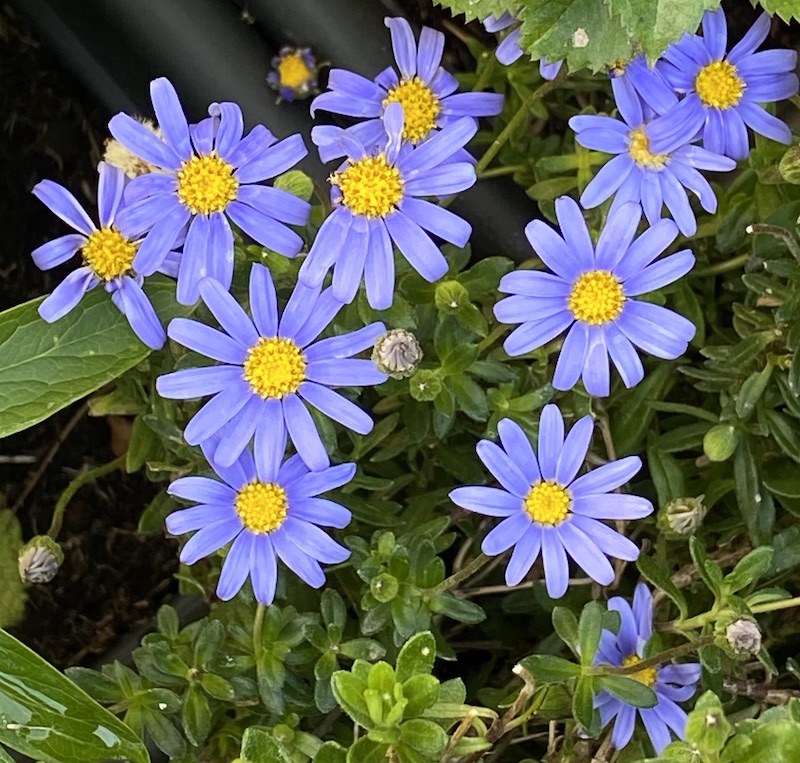
Felicia or Marguerite Daisy
We have been ‘under house arrest’ for over two months now. In that time we have left our house just twice; once for a medical appointment and now a second time to ‘exercise’. Yesterday, having considered government advice and police guidelines we decided that driving the 10 to 15 minutes to Pegwell Bay with the intention of being there for an hour or so, was legitimate. The truth is I am often unable to walk far, and yesterday was no exception as my chronic sciatica decided it had rested long enough and spiked. However, exercise is only partly physical…. mental exercise is also necessary to keep from losing one’s marbles. So off we drove, finding roads much freer of vehicles than is normal, but more crowded than government figures would suggest.
So it was a terrible disappointment to find the road closed due to roadworks. Having got that far we thought a few minutes driving the back lanes before returning home was within the spirit of the lockdown, given that we had no intention of leaving the car let alone contravening social distancing.
On this route we have never encountered walkers or cyclists before, this time they were legion. It was a pleasure to spend a few sunny minutes alongside the lush growth of late spring but birds were few and nothing special. Having said that three migrants were new to our lockdown year with a singing Whitethroat and a few swooping Swallows the highlights… sadly Sedge Warblers were heard but not seen. An Orange-tip butterfly was also a ‘year tick’.
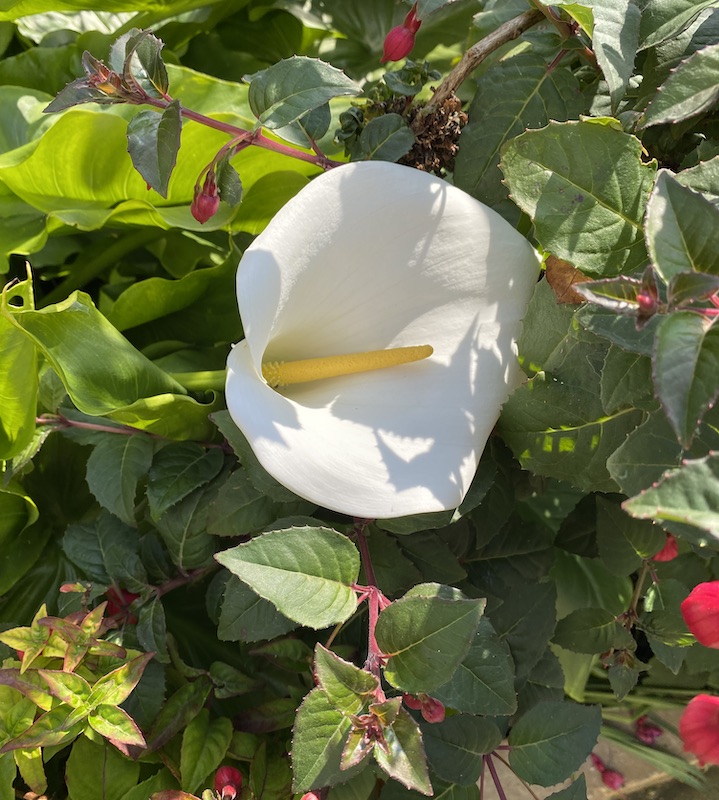
A Calla Lily blooms among the Fuschia
Today the garden is ‘quiet’… a breeze seems to be keeping the insects away apart from Red Admiral, Holly Blue and Small White butterflies and a couple of visiting bees. Of course there is mad action in the pond when we feed the tadpoles and two of last year’s brood were hiding in the duckweed.
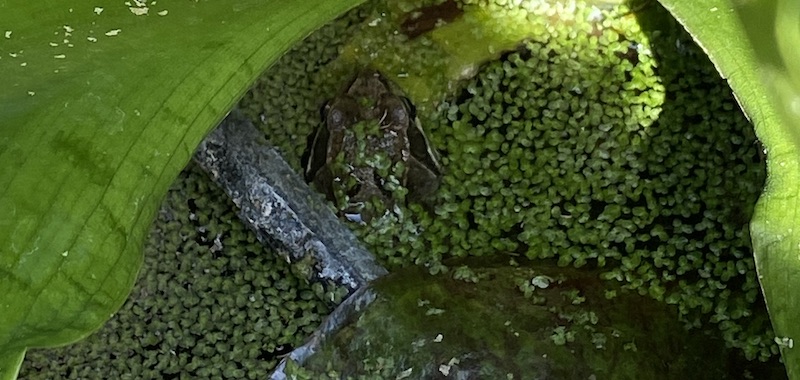
Hanging Ten
(06.05.20)
For those who don’t know, ‘hanging ten’ is a surfing term (sea not internet) when a surfer has all ten toes curled over the edge of their board. As you can see this feral pigeon Columba livia is surfing my steps.
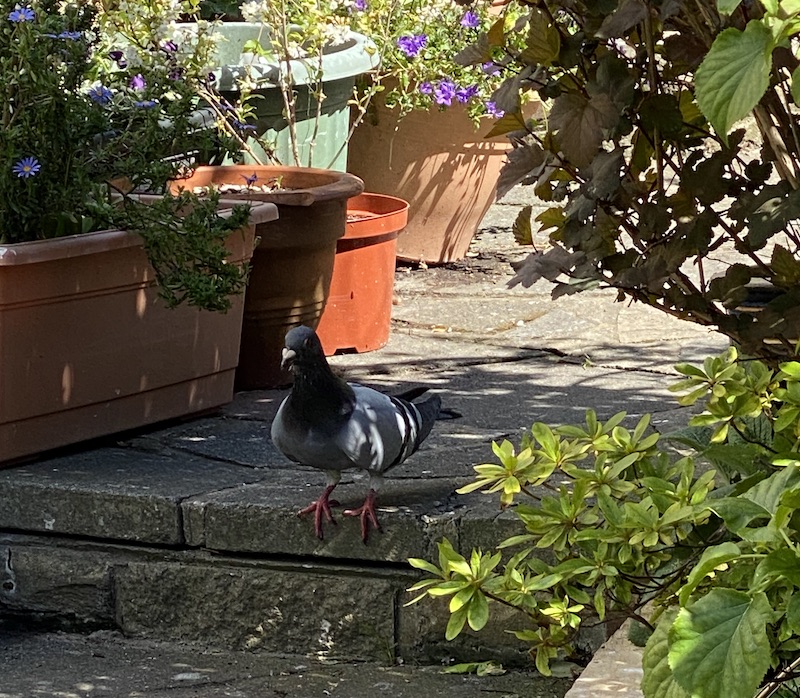
That it is displeasingly tame is a truism of such birds across the globe. While in theoretically all birds are equal, we all have our favourites and those we frankly shun. Maggie is not enamoured of Starlings, but I daily forgive these bully boys as their readiness to adapt and self confidence shines as bright as their iridescent feathers. Look closely at their plumage and it is a match for many exotics. My scorn is saved for feral pigeons. Rock Doves in their natural habitat are fine, but they are now counted in their billions because they found out that towns and cities are a myriad of cliff faces. Worse still, we tamed them to live in dove cotes as a welcome addition to the table in times of scarcity, then allowed then to flourish. I apologise for my prejudice, but I cannot love them.
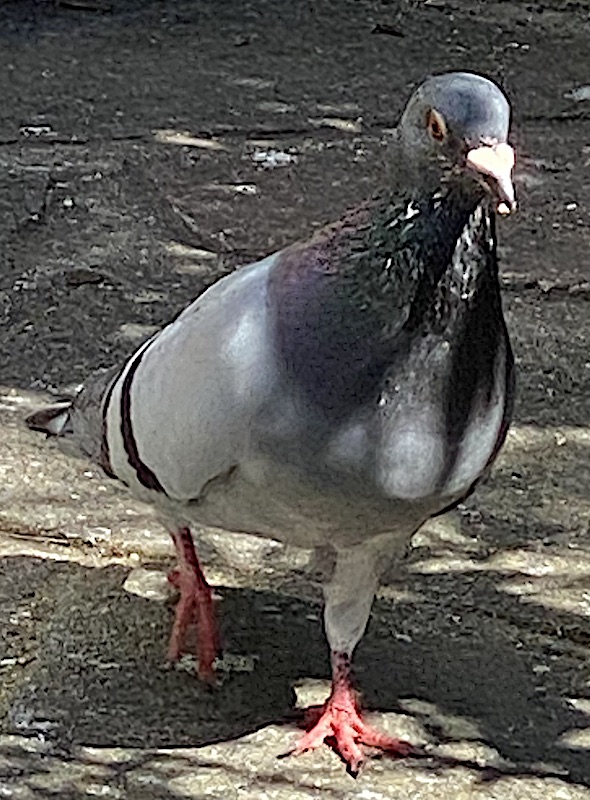
I should love their colour and appreciate their cleverness but I just don’t. Perhaps it is their very docility? I find sheep to be unattractive in their doziness too.
I resent their consumption of the expensive offerings provided to attract species I admire more. I abhor the mess they make and cannot even warm to their tameness. My bête noir is a grey bird. I wish they would the ten hanging out in my garden would hang elsewhere!
Swift Sky Scanning
(05.05.20)
For nearly a month my morning regime has been to scan the skies from my study window with the first espresso of the day.

My Sky
I’ve been hoping for hirundines. Sand Martins are one of our earliest arriving migrants but I seldom see them before they are nesting in a local colony. House Martins are scarce in my town, although there is a local chippy with a tally turret that has a few still returning for me to view on my way to the supermarket. Swallows however often grace my local sky during high summer when the ants are flying. In most years I can expect to see them from my window in April. Sadly, I have yet to definitely spot one, although there have been a couple of eye-corner maybes. Normally Swifts arrive around 6th of May. ‘Our’ local Swifts have dwindled from around twenty to just four or five. Late summer as the refuel ready for the long journey south they sometimes gather overhead in large flocks.
Today my sky scanning was rewarded with my first four Swifts, for the first spring ever I have seen Swifts before seeing Swallows!
Still its nice to have the sun back and to be able to see flowers showing off…
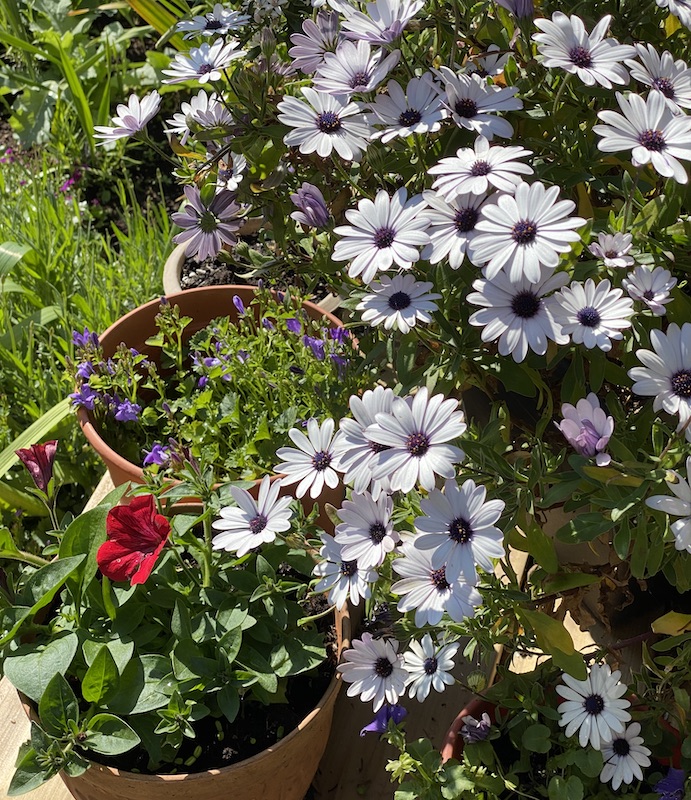
Osteospermums, a red Petunia and creeping Campanula
…and to go on teaching the birds that we are no threat. That starlings can safely pick through the pots…
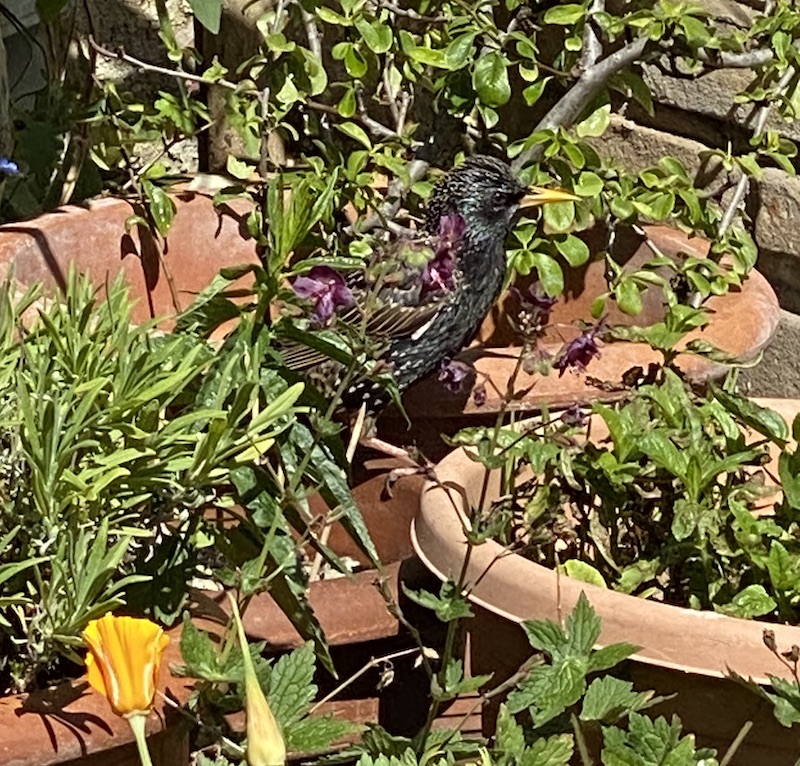
…and house sparrows can take a dip fearlessly.
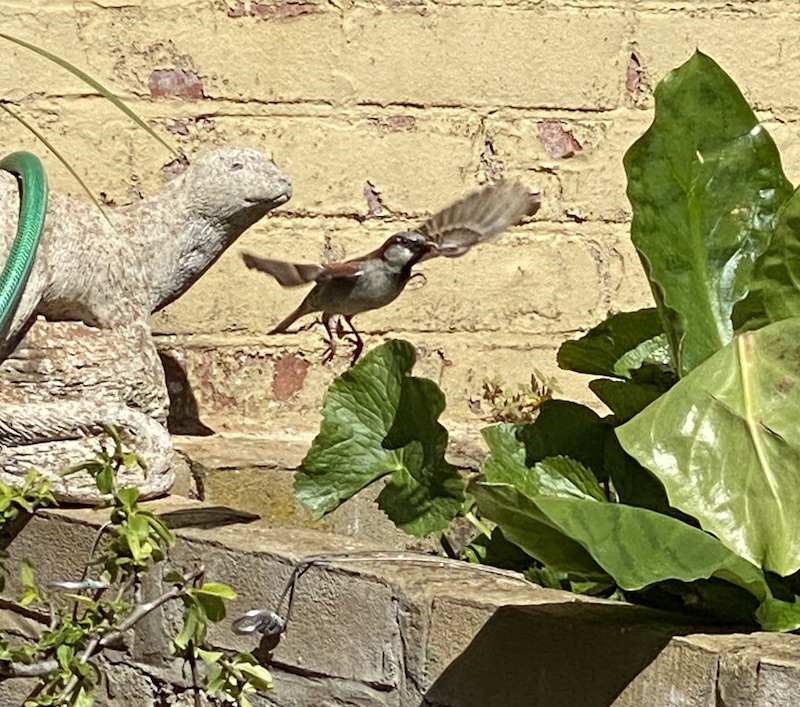
Dull Days
(03.05.20)
Not every day in lockdown is full of sunshine and laughter… sometimes the weather, birding and mood is duller. Today, staring out of the study window Maggie spotted two sparowhawks soaring and chasing. Given its past time to pair and nest and the birds appeared to be the same size maybe this was territorial or just two youngsters competing?
So far this lockdown few closer encounters… right in week one of shielding a sparrowhawk landed on the corner of the fence over the garage scattering every other bird bar the ring-necked parakeets that stuck fast to apple-eating. Nothing to eat for the sparrowhawk she slipped off the fence and glided down the road. It’s a while now since one came fully into the garden. At that time the bird perched on the pyrocanthus under our shed and got frustrated being unable to get to all the sparrows sheltering well inside the thorny bush!
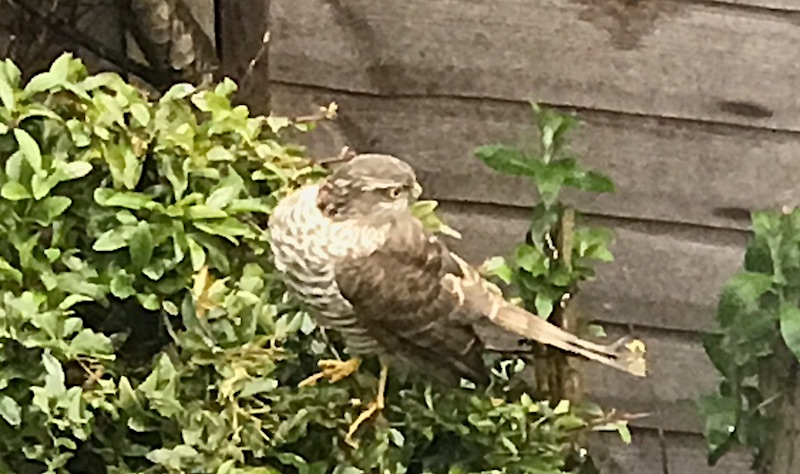
Another reminder that its the experience not the photo that counts!*
I wonder if a Sparrowhawk was responsible for this (16.05.20)
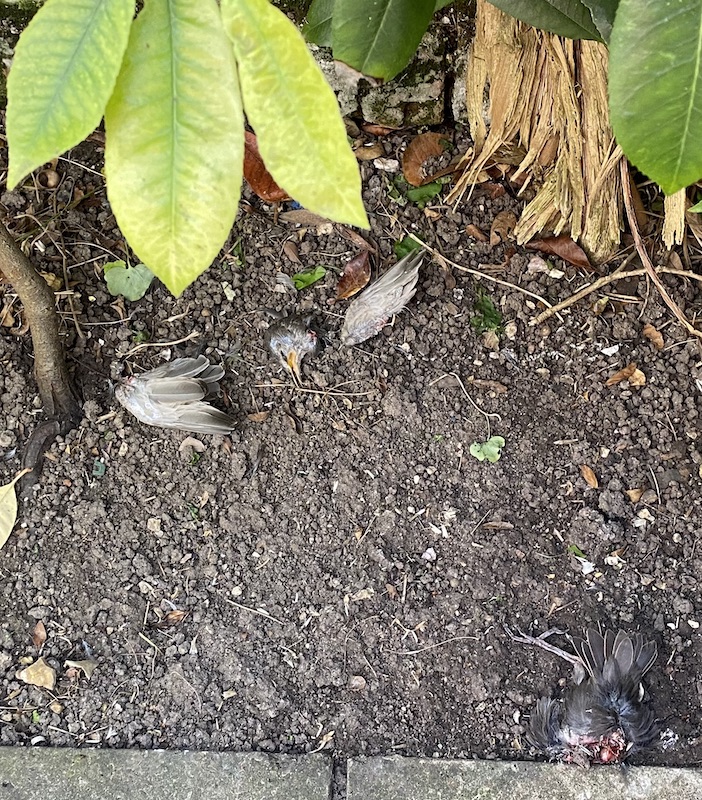
Brief views of the two birds soaring was uplifting but only briefly as it was also a reminder of better bird days. Lockdown is a necessary confinement which sometimes frustrates and dulls the emotions… bring back the sun.
Apparently people are posting ‘Where’s Wally’ shots on social media… I’ve just posted my version: ‘Where’s Polly’
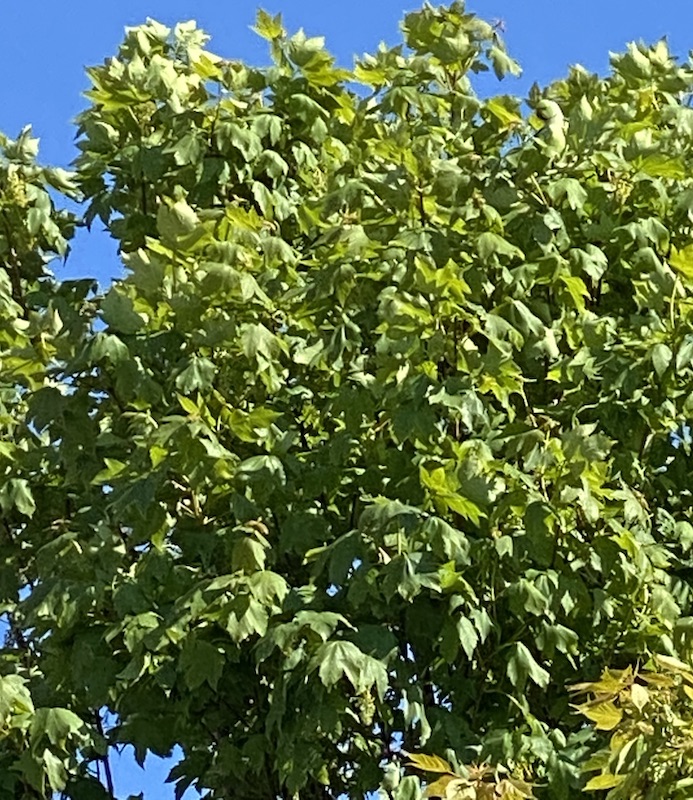
Spot the ring-necked parakeet
*Footnote: More than forty years ago I stopped over in Fiji en route to NZ for a family visit. I arrived a day after a hurricane stripped the tops off of the palm trees and swept away the birdlife. I only had one day there so decided to take a boat out to ‘Treasure Island’ a tiny atoll where a cookout was followed by a trip on a glass-bottomed boat over the reef where the lunch leftovers were tipped over the side attracting a myriad of colourful fish. I was madly snapping away with my camera trying to catch the scene when it occurred to me that instead of enjoying the moment and immersing myself in the unique experience I was wasting it trying to record it. Ever since, making the memory has been much more important to me than making a visual record of it.
Sprouting Summer
(02.05.20)
I wasn’t fast enough with my phone to capture a red-letter garden visitor. Most years we get a few species of butterfly, large and small whites, red admirals, peacocks, meadow browns and gatekeepers and holly blues visit all summer long. If we are lucky there will be painted ladies, commas and other blues or whites. But just three times in twenty years brimstones have popped in and out for as long as it takes to tell. But I cannot supply evidence and must settle for this blue.
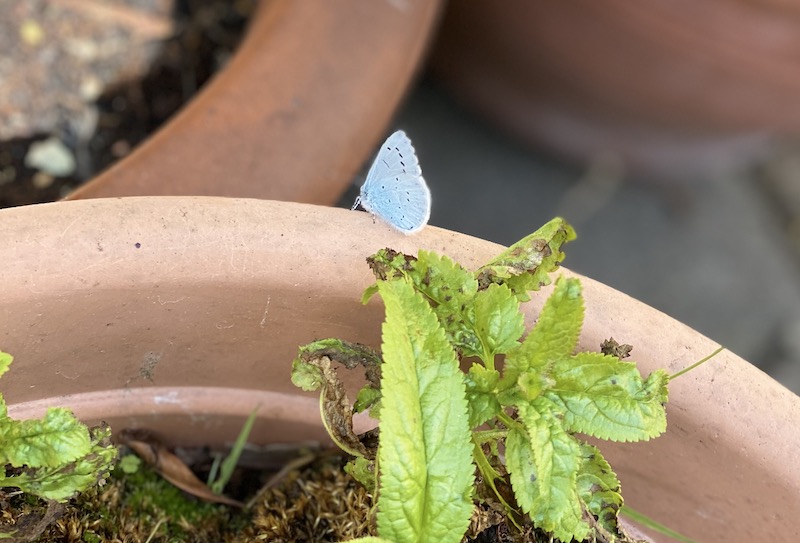
Daily the pots become more densely packed with fast growing foliage. In lockdown its been hard to buy in plants and our usual over expenditure in garden centres has been impossible. Having to revert to seeds merely reminds me of how limited my gardening skills are as well as how little space we have. The ‘unused corners’ of TV gardeners could swallow our entire garden whole without it touching the sides, so places to pot up and grow-on seedlings is sadly lacking.
The kitchen windowsill becomes packed with my attempts to propogate and any earth daring to stay bare is prey to my fingers pushing in a nastutium seed or sprinkling some bee-favoured scatterings.
The starlings continue to get bolder still!
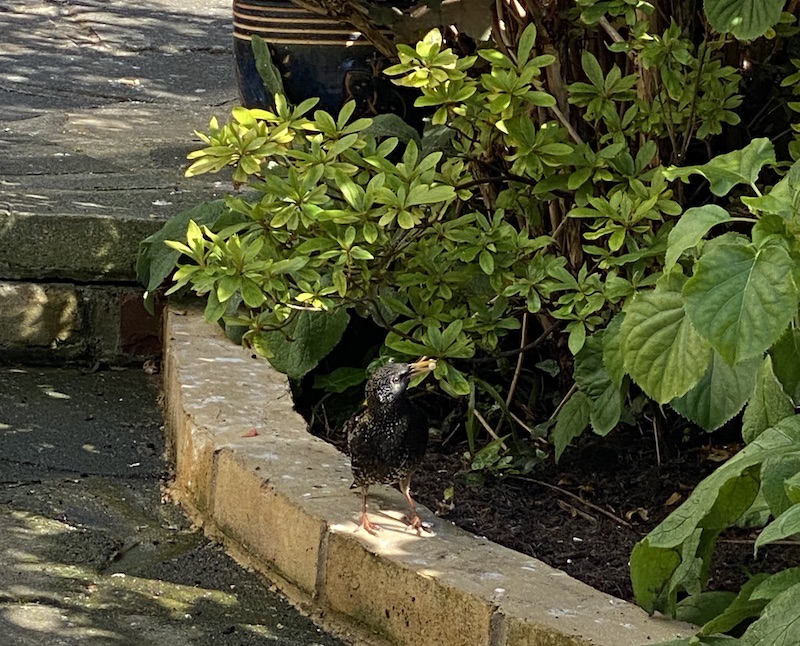

Mayday Re-cap
(01.05.20)
Daily we thank providence for our minuscule but comely outdoor space. Lockdown with no fresh air or bird song would be house-arrest, we have an open prison where the two inmates can do a little horticultural exercise and peer over the garden wall at the world not going by.
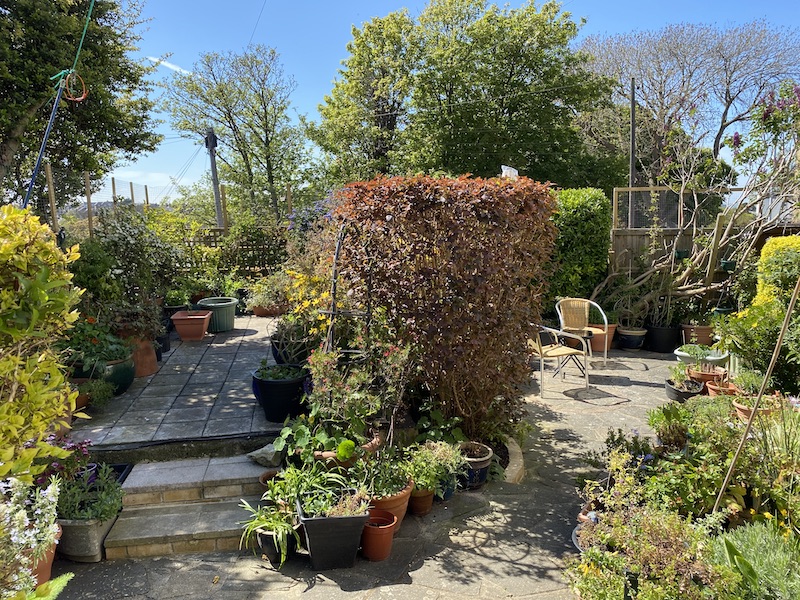
From our garage roof (sunk into the garden so forming a walled, raised patio) we can look down a road to the corner of a park. Social distancing seems not to apply to youngsters, but the rest are like clubbers walking home in the early hours, when they spot another human they cross the street and pretend they cannot see them, fearful of a viral assault.
Perhaps the weather gods feared viral loading as they have vacuumed and washed the floors for the last couple of days. For most of our lockdown days they shone a heat lamp into our corner. Six weeks of blue sky and enough rays to lightly toast my face and limbs have taken the garden from skeletal shrubs and bare earth pots to lush leaved lavender and full flowered perennials.
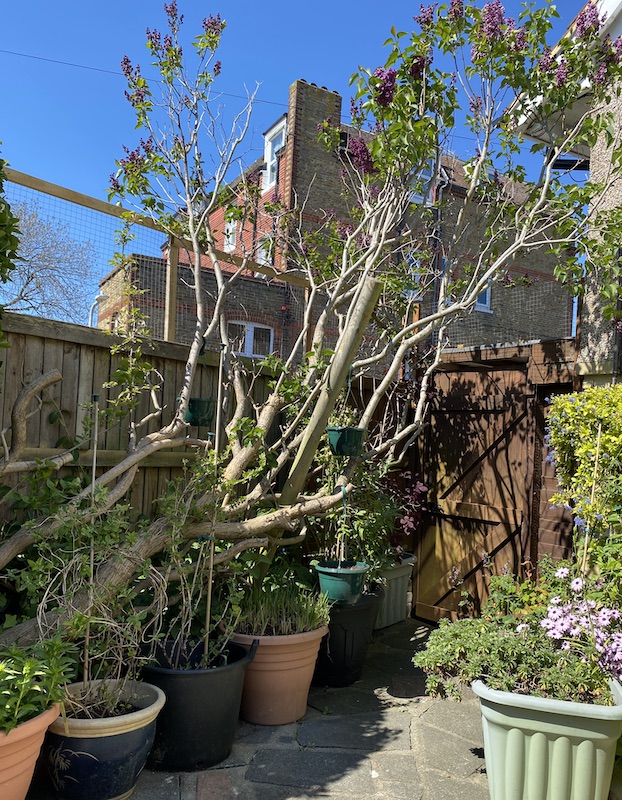
Pottering has pushed aside the quarantine police to mere nodding acquaintances. As never before we have witnessed the hourly growth of springing foliage and the daily miracle of emerging life. Corvid-19 had hardly taken hold when our pond sprouted the first spawn. But as we shielded from its ravaging, tadpoles emerged and grew to a roiling mass when we sprinkle their home with baby frog formula.
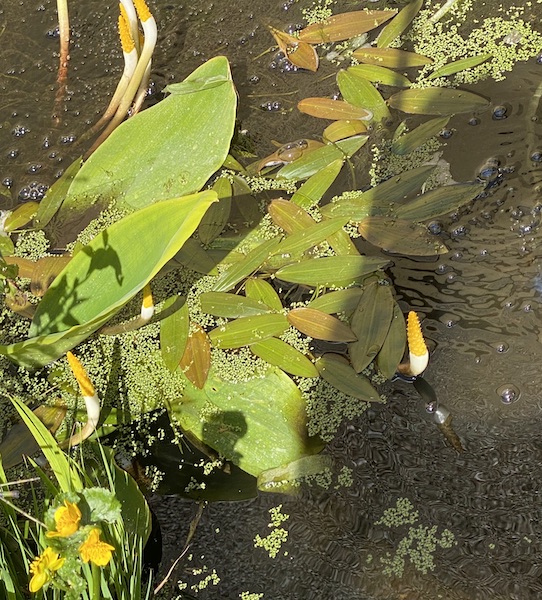
Most years we emerge from our cocoons in early summer having spent spring days birding the marshes and migrant fields. The garden was a winter-end tidying chore, followed later by a cold-drink corner when the local tree leaves had hidden all the birds from view. High summer is a time to retreat from avian pursuit into the sanctuary of the daisy-filled courtyard and shed clothing while doing as close to nothing as we can.
This year we have seen more of our personal spring than ever before. We have before had just tangential awareness of how our southern maritime climate allows for some all-year colour. But this spring we have seen that Rosemary is blooming attractive to bees in late February and by May is an irresistible magnet to every flier. Over six weeks grey lavender remnants sprouted inches of green growth and naked ceanothus is overwhelmed by blue robes.
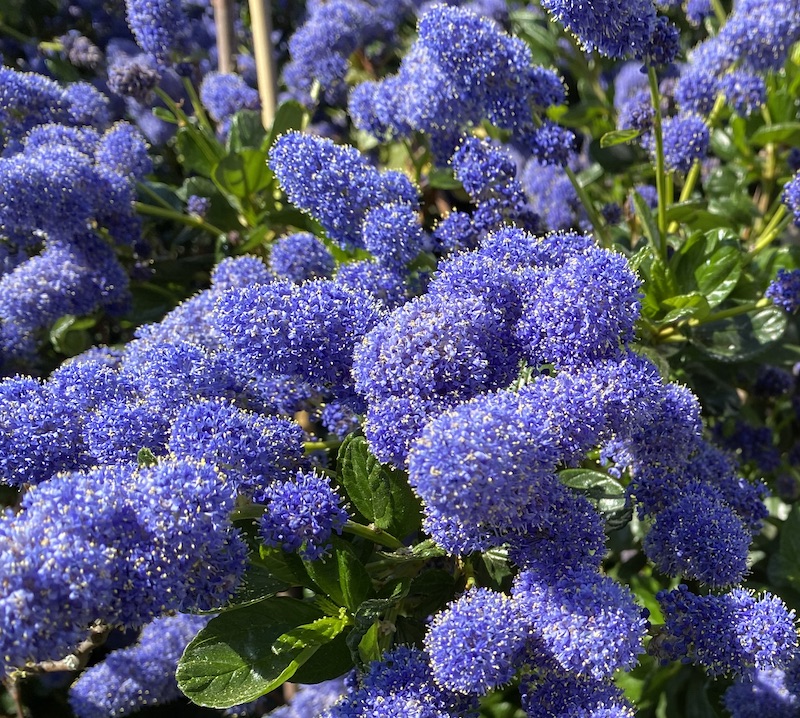
Ceanothus
Clematis was rope coiled and knotted but is now a cascade of light pink confetti. Campanulas were tight grey-green mounds barely showing life and are now meter-high spikes about to burst with purple, blue and white. Almost while watching geraniums are creeping across the ground and salvias stretched up tall ready to burst into bee towers.
In lazy summer our sitting selves would count the hover-flies and honey bees, but this busy spring bee-flies hover eye-crossingly close and a succession of bumblebees paraded by, early, tree, garden and carder variety no longer one buzz but laying a trail to follow the season.
But birds are the biggest revelation. This is no New Forest headspring nor heartland orchard full of forty species but a dozen regulars all in profusion. Our diminished sparrows have consolidated and grown five-fold, scrapping starlings abound, dunnocks pick across pots and sudden song bursts our eardrums as never before. Every day is ceremoniously opened and closed by blackbird heralds. Afternoons at ease are serenaded by dunnocks and naps startled by wren’s whispering across seven fields.
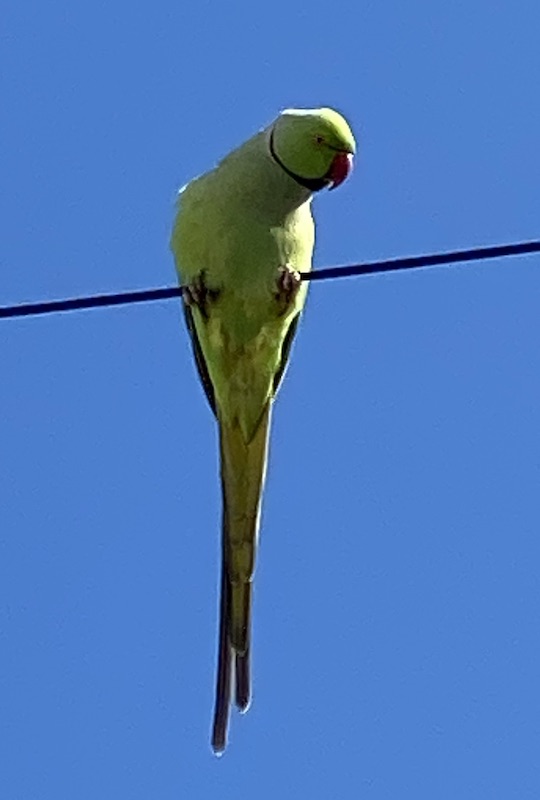
If we don’t feed the ring-necked parakeets their daily apples, they sit on the washing-line and squawk raucous admonitions. Every day the sparrows and starlings are bolder and the robin less caring of our presence. We invaded their domain but have been forgiven with the best prize, being ignored. If we are slow and muted we are new bushes, almost to be tried as perches but ever worth no notice.
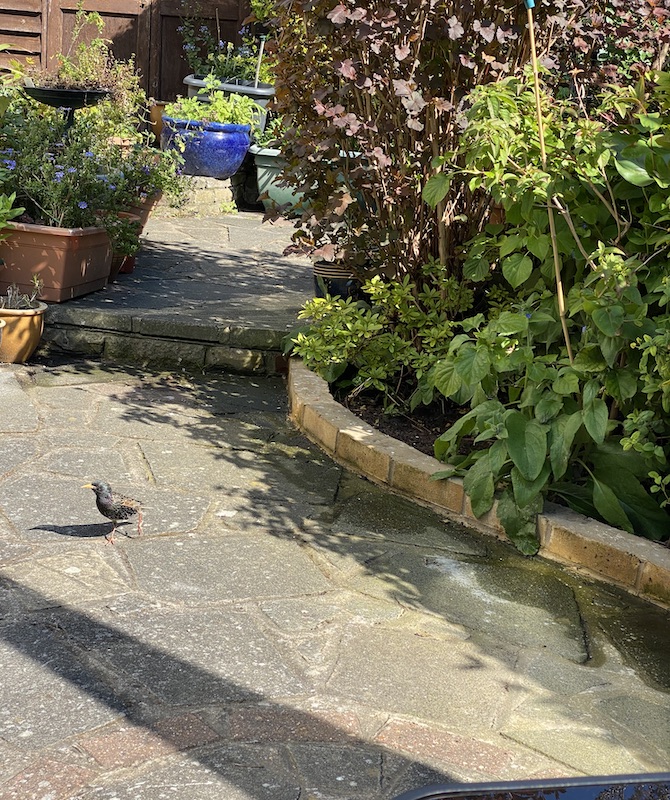
Locked away from variety we may be, but we are locked in with ever more confiding inmates and ever more colourful prison walls.
Quiet Corners
(April 2020)
Conservation organisations may worry about urgent tasks left undone during lockdown but quieter roads must have save thousands of toads, hedgehogs and other ‘road kill’. Cleaner air must be good for insects and undisturbed countryside better for breeding birds.
In our tiny urban haven there have been no migrants overhead let alone gracing our patch, but a few birds we scarely ever see have turned up in our quiet corner. Most gratifying this songthrush. When we moved here two decades ago my waking was often to the gentle tap-tap of a thrush despatching a snail. Sadly it has been many years since that morning sound and evening seranade. This year, for the first time in many, this fellow found his way to our garden every morning for a week or more. Given it must be nesting we hope he is close by enough to return and rid our pots of more rampaging moluscs!
